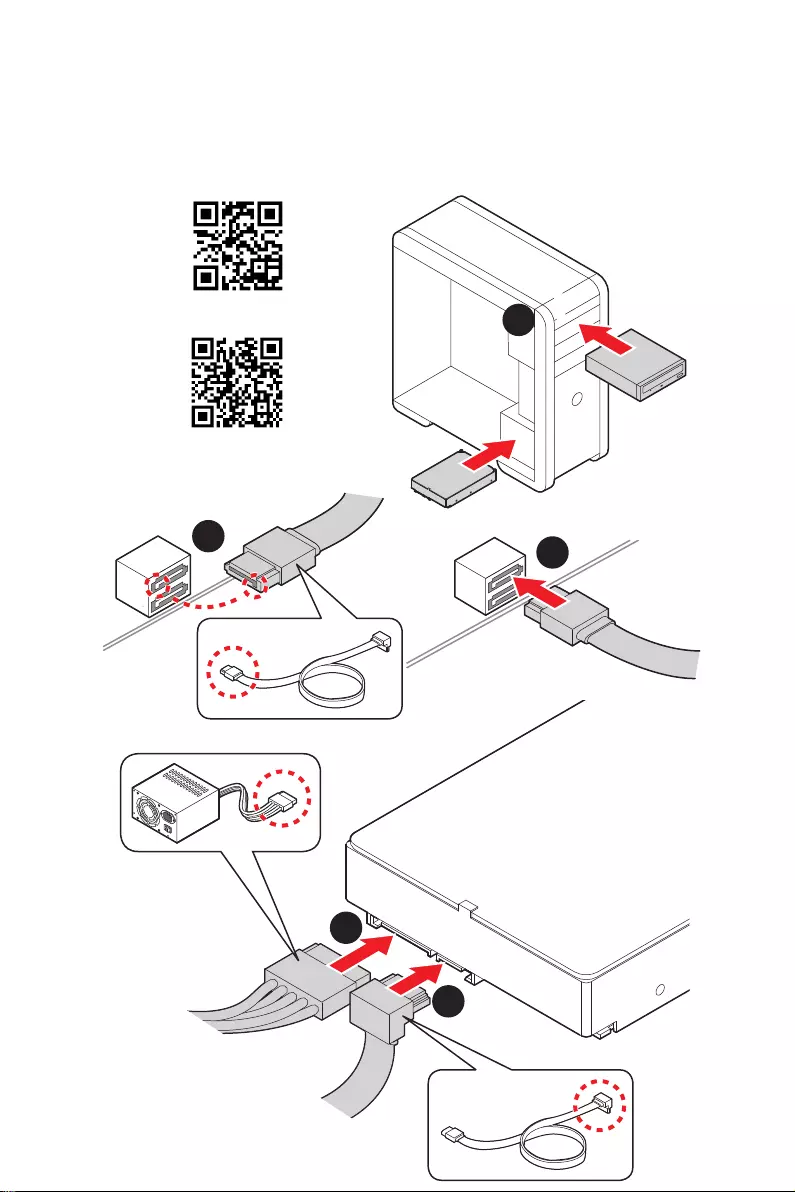Table of Contents
- Safety Information
- Specifications
- Package contents
- Rear I/O Panel
- Overview of Components
- CPU Socket
- DIMM Slots
- PCI_E1~3: PCIe Expansion Slots
- JFP1, JFP2: Front Panel Connectors
- M2_1~2: M.2 Slots (Key M)
- SATA5~8 & SATA_A~B: SATA 6Gb/s Connectors
- JAUD1: Front Audio Connector
- JTBT1: Thunderbolt Add-on Card Connector
- JDASH1 : Tuning Controller connector
- CPU_PWR1~2, ATX_PWR1: Power Connectors
- JCI1: Chassis Intrusion Connector
- JUSB4: USB 3.2 Gen 2 10Gbps Type-C Connector
- JUSB3: USB 3.2 Gen 1 5Gbps Connector
- JUSB1~2: USB 2.0 Connectors
- JTPM1: TPM Module Connector
- CPU_FAN1, PUMP_FAN1, SYS_FAN1~2: Fan Connectors
- JBAT1: Clear CMOS (Reset BIOS) Jumper
- EZ Debug LED
- JRGB1: RGB LED connector
- JRAINBOW1~2: Addressable RGB LED connectors
- Installing OS, Drivers & MSI Center
- UEFI BIOS
- Sicherheitshinweis
- Spezifikationen
- Packungsinhalt
- Rückseite E/A
- Übersicht der Komponenten
- CPU Sockel
- DIMM Steckplätze
- PCI_E1~3: PCIe Erweiterungssteckplätze
- JFP1, JFP2: Frontpanel-Anschlüsse
- M2_1~2: M.2 Steckplätze (Key M)
- SATA5~8 & SATA_A~B: SATA 6Gb/s Anschlüsse
- JAUD1: Audioanschluss des Frontpanels
- JTBT1: Anschluss für Thunderbolt-Erweiterungskarte
- JDASH1: Tuning Controller-Anschluss
- CPU_PWR1~2, ATX_PWR1: Stromanschlüsse
- JCI1: Gehäusekontaktanschluss
- JUSB4: USB 3.2 Gen 2 10Gbit/s Typ-C Anschluss
- JUSB3: USB 3.2 Gen 1 5Gbit/s Anschluss
- JUSB1~2: USB 2.0 Anschlüsse
- JTPM1: TPM Anschluss
- CPU_FAN1, PUMP_FAN1, SYS_FAN1~2: Stromanschlüsse für Lüfter
- JBAT1: Clear CMOS Steckbrücke (Reset BIOS)
- EZ DEBUG LED
- JRGB1: RGB LED Anschluss
- JRAINBOW1~2: Adressierbarer RGB-LED-Streifen Anschlüsse
- Installation von OS, Treibern & MSI Center
- UEFI BIOS
- Table des matières
- Informations de sécurité
- Spécifications
- Contenu
- Panneau E/S arrière
- Vue d’ensemble des composants
- Socket Processeur
- Slots DIMM
- PCI_E1~3 : Slots d’extension PCIe
- JFP1, JFP2 : Connecteurs de panneau avant
- M2_1~2 : Slots M.2 (Touche M)
- SATA5~8 et SATA_A~B : Connecteurs SATA 6 Gb/s
- JAUD1 : Connecteur audio avant
- JTBT1 : Connecteur de carte additionnelle Thunderbolt
- JDASH1 : Connecteur du contrôleur de réglages
- CPU_PWR1~2, ATX_PWR1 : Connecteurs d’alimentation
- JCI1 : Connecteur intrusion châssis
- JUSB4 : Connecteur USB 3.2 Gen 2 10 Gb/s Type-C
- JUSB3 : Connecteur USB 3.2 Gen 1 5 Gb/s
- JUSB1~2 : Connecteurs USB 2.0
- JTPM1 : Connecteur de module TPM
- CPU_FAN1, PUMP_FAN1, SYS_FAN1~2 : Connecteurs de ventilateur
- JBAT1 : Cavalier Clear CMOS (Réinitialiser le BIOS)
- EZ Debug LED
- JRGB1 : Connecteur LED RGB
- JRAINBOW1~2 : Connecteurs LED RGB adressables
- Installer OS, Pilotes et MSI Center
- UEFI BIOS
- Безопасное использование продукции
- Технические характеристики
- Комплект поставки
- Задняя панель портов ввода/ вывода
- Компоненты материнской платы
- Процессорный сокет
- Слоты DIMM
- PCI_E1~3: Слоты расширения PCIe
- JFP1, JFP2: Разъемы передней панели
- M2_1~2: Разъемы M.2 (Ключ M)
- SATA5~8 & SATA_A~B: Разъемы SATA 6Гб/с
- JAUD1: Разъем аудио передней панели
- JTBT1: Разъем для установки карты расширения Thunderbolt
- JDASH1 : Разъем контроллера настройки
- CPU_PWR1~2, ATX_PWR1: Разъемы питания
- JCI1: Разъем датчика открытия корпуса
- JUSB4: Разъем USB 3.2 Gen 2 10Гб/с Type-C
- JUSB3: Разъем USB 3.2 Gen 1 5Гб/с
- JUSB1~2: Разъемы USB 2.0
- JTPM1: Разъем модуля ТРМ
- CPU_FAN1, PUMP_FAN1, SYS_FAN1~2: Разъемы вентиляторов
- JBAT1: Джампер очистки данных CMOS (Сброс BIOS)
- Индикаторы отладки EZ
- JRGB1: Разъем RGB LED
- JRAINBOW1~2: Разъемы адресных RGB LED
- Установка ОС, драйверов и MSI Center
- UEFI BIOS
- 安全に関する注意事項
- 仕様
- パッケージの内容
- リアI/Oパネル
- コンポーネントの概要
- CPUソケット
- DIMMスロット
- PCI_E1~3: PCIe拡張スロット
- JFP1, JFP2: フロントパネルコネクター
- M2_1~2: M.2スロット (Key M)
- SATA5~8 & SATA_A~B: SATA 6Gb/sコネクター
- JAUD1: フロントオーディオコネクター
- JTBT1: Thunderbolt追加カードコネクター
- JDASH1 : チューニングコントローラーコネクター
- CPU_PWR1~2, ATX_PWR1: 電源コネクター
- JCI1: ケース開放スイッチコネクター
- JUSB4: USB 3.2 Gen 2 10Gbps Type-Cコネクター
- JUSB3: USB 3.2 Gen 1 5Gbpsコネクター
- JUSB1~2: USB 2.0コネクター
- JTPM1: TPMモジュールコネクター
- CPU_FAN1, PUMP_FAN1, SYS_FAN1~2: ファンコネクター
- JBAT1: クリアCMOS (BIOSリセット) ジャンパ
- EZ Debug LED
- JRGB1: RGB LEDコネクター
- JRAINBOW1~2: 追加のRGB LEDコネクター
- OS、ドライバーおよびMSI Centerのインストール
- UEFI BIOS
- 안전 지침
- 사양
- 제품 내용물
- 후면 I/O 패널
- 구성품 개요
- CPU 소켓
- DIMM 슬롯
- PCI_E1~3: PCIe 확장 슬롯
- JFP1, JFP2: 전면 패널 커넥터
- M2_1~2: M.2 슬롯 (Key M)
- SATA5~8 & SATA_A~B: SATA 6Gb/s 커넥터
- JAUD1: 전면 오디오 커넥터
- JTBT1: 썬더볼트 추가 카드 커넥터
- JDASH1 : 튜닝 컨트롤러 커넥터
- CPU_PWR1~2, ATX_PWR1: 전원 커넥터
- JCI1: 섀시 침입 커넥터
- JUSB4: USB 3.2 Gen 2 10Gbps Type-C 커넥터
- JUSB3: USB 3.2 Gen 1 5Gbps 커넥터
- JUSB1~2: USB 2.0 커넥터
- JTPM1: TPM 모듈 커넥터
- CPU_FAN1, PUMP_FAN1, SYS_FAN1~2: 팬 커넥터
- JBAT1: CMOS (Reset BIOS) 클리어 점퍼
- EZ 디버그 LED
- JRGB1: RGB LED 커넥터
- JRAINBOW1~2: 주소 지정 가능한 RGB LED 커넥터
- OS, 드라이버 & MSI 센터 설치하기
- UEFI BIOS
- 安全說明
- 規格
- 包裝內容
- 背板 I/O
- 元件總覽
- CPU 腳座
- 記憶體插槽
- PCI_E1~3: PCIe 擴充插槽
- JFP1、JFP2: 系統面板接頭
- M2_1~2: M.2 插槽 (M 鍵)
- SATA5~8 & SATA_A~B: SATA 6Gb/s 插孔
- JAUD1: 前置音效插孔
- JTBT1: Thunderbolt 擴充卡接頭
- JDASH1: 調試控制器接頭
- CPU_PWR1~2, ATX_PWR1: 電源接頭
- JCI1: 機殼開啟接頭
- JUSB4: USB 3.2 Gen 2 10Gbps Type-C 接頭
- JUSB3: USB 3.2 Gen 1 5Gbps 接頭
- JUSB1~2: USB 2.0 接頭
- JTPM1: TPM 模組接頭
- CPU_FAN1、PUMP_FAN1、SYS_FAN1~2: 風扇電源接頭
- JBAT1: 清除 CMOS (重置 BIOS) 功能跳線
- 除錯 LED 指示燈
- JRGB1: RGB LED 接頭
- JRAINBOW1~2: 可定址 RGB LED 接頭
- 安裝作業系統、驅動程式和 MSI Center
- UEFI BIOS
- 安全信息
- 规格
- 包装内容
- 后置 I/O 面板
- 组件概述
- CPU 底座
- DIMM 插槽
- PCI_E1~3: PCIe 扩展插槽
- JFP1, JFP2: 前置面板接口
- M2_1~2: M.2 接口 (M 键)
- SATA5~8 & SATA_A~B: SATA 6Gb/s 接口
- JAUD1: 前置音频接口
- JTBT1: Thunderbolt 附加卡接口
- JDASH1 : 调试控制器接口
- CPU_PWR1~2, ATX_PWR1: 电源接口
- JCI1: 机箱入侵检测接口
- JUSB4: USB 3.2 Gen 2 10Gbps Type-C 接口
- JUSB3: USB 3.2 Gen 1 5Gbps 接口
- JUSB1~2: USB 2.0 接口
- JTPM1: TPM 模组接口
- CPU_FAN1, PUMP_FAN1, SYS_FAN1~2: 风扇接口
- JBAT1: 清除 CMOS (重启 BIOS) 跳线
- 简易侦错 LED 灯
- JRGB1: RGB LED 接口
- JRAINBOW1~2: 寻址 RGB LED 接口
- 安装操作系统,驱动程序和 MSI Center
- UEFI BIOS
MSI MAG Z690M MORTAR WIFI User Manual
Displayed below is the user manual for MAG Z690M MORTAR WIFI by MSI which is a product in the Motherboards category. This manual has pages.
Related Manuals

I
MAG B660M MORTAR WIFI
MAG B660M MORTAR
MAG Z690M MORTAR WIFI
Motherboard
User Guide
Benutzerhandbuch
Manuel d’utilisation

III
Quick Start
Thank you for purchasing the MSI® motherboard. This Quick Start section provides
demonstration diagrams about how to install your computer. Some of the installations
also provide video demonstrations. Please link to the URL to watch it with the web
browser on your phone or tablet. You may have even link to the URL by scanning the
QR code.
Kurzanleitung
Danke, dass Sie das MSI® Motherboard gewählt haben. Dieser Abschnitt der
Kurzanleitung bietet eine Demo zur Installation Ihres Computers. Manche
Installationen bieten auch die Videodemonstrationen. Klicken Sie auf die URL, um
diese Videoanleitung mit Ihrem Browser auf Ihrem Handy oder Table anzusehen. Oder
scannen Sie auch den QR Code mit Ihrem Handy, um die URL zu öffnen.
Présentation rapide
Merci d’avoir choisi la carte mère MSI®. Ce manuel fournit une rapide présentation
avec des illustrations explicatives qui vous aideront à assembler votre ordinateur.
Des tutoriels vidéo sont disponibles pour certaines étapes. Cliquez sur le lien fourni
pour regarder la vidéo sur votre téléphone ou votre tablette. Vous pouvez également
accéder au lien en scannant le QR code qui lui est associé.

V
Installing DDR5 memory/ Installation des DDR5-Speichers/
DIMMA2 DIMMA2
DIMMB2
DIMMA1
DIMMA2
DIMMB1
DIMMB2
https://youtu.be/XiNmkDNZcZk
Youtube
https://v.youku.com/v_show/id_
XNTE5NTg0NDM4NA==.html

VI
Connecting the Front Panel Header/ Anschließen der
Frontpanel-Stiftleiste/ Connecter un connecteur du panneau
HDD LED
RESET SW
JFP1
HDD LED
HDD LED +
POWER LED +
POWER LED
1
2 10
9
+
+
+
+
Power LED
HDD LED Reset Switch
Reserved
Power Switch
JFP1
1 HDD LED + 2 Power LED +
3 4
5 Reset Switch 6 Power Switch
7 Reset Switch 8 Power Switch
9 Reserved 10 No Pin
RESET SW
POWER SW
POWER LED+
POWER LED-
HDD LED
http://youtu.be/DPELIdVNZUI
Youtube
http://v.youku.com/v_show/id_XNjcyMTczMzM2.html

XI
Connecting Peripheral Devices/ Peripheriegeräte/ Connecter
(For MAG B660M MORTAR WIFI/ MAG
Z690M MORTAR WIFI)

XII
4
3
12

1
Contents
Contents
Safety Information ................................................................................................. 3
..................................................................................... 4
Avoid collision notification ...................................................................................... 4
Specifications ......................................................................................................... 5
Package contents ................................................................................................ 12
Rear I/O Panel ..................................................................................................... 13
LAN Port LED Status Table .................................................................................. 13
Audio Ports Configuration .................................................................................... 13
Realtek Audio Console ......................................................................................... 14
Overview of Components .................................................................................... 17
CPU Socket ........................................................................................................... 18
DIMM Slots ............................................................................................................ 19
PCI_E1~3: PCIe Expansion Slots .......................................................................... 20
JFP1, JFP2: Front Panel Connectors ................................................................... 20
M2_1~2: M.2 Slots (Key M) ................................................................................... 21
SATA5~8 & SATA_A~B: SATA 6Gb/s Connectors ................................................. 23
JAUD1: Front Audio Connector ............................................................................ 23
...................................................... 24
JDASH1 : Tuning Controller connector ................................................................ 24
CPU_PWR1~2, ATX_PWR1: Power Connectors ................................................... 25
JCI1: Chassis Intrusion Connector ....................................................................... 26
............................................... 27
JUSB3: USB 3.2 Gen 1 5Gbps Connector ............................................................. 27
JUSB1~2: USB 2.0 Connectors ............................................................................. 28
JTPM1: TPM Module Connector ........................................................................... 28
CPU_FAN1, PUMP_FAN1, SYS_FAN1~2: Fan Connectors .................................. 29
JBAT1: Clear CMOS (Reset BIOS) Jumper ........................................................... 30
EZ Debug LED ....................................................................................................... 30
JRGB1: RGB LED connector ................................................................................. 31
JRAINBOW1~2: Addressable RGB LED connectors ............................................ 32
Installing OS, Drivers & MSI Center .................................................................... 33
Installing Windows 10/ Windows 11 ..................................................................... 33
Installing Drivers .................................................................................................. 33
MSI Center ............................................................................................................ 33
English

2Contents
............................................................................................................. 34
BIOS Setup ............................................................................................................ 35
Entering BIOS Setup ............................................................................................. 35
BIOS User Guide ................................................................................................... 35
Resetting BIOS ...................................................................................................... 36
Updating BIOS ....................................................................................................... 36

3
Safety Information
Safety Information
The components included in this package are prone to damage from electrostatic
discharge (ESD). Please adhere to the following instructions to ensure successful
computer assembly.
Ensure that all components are securely connected. Loose connections may cause
the computer to not recognize a component or fail to start.
Hold the motherboard by the edges to avoid touching sensitive components.
It is recommended to wear an electrostatic discharge (ESD) wrist strap when
handling the motherboard to prevent electrostatic damage. If an ESD wrist strap is
not available, discharge yourself of static electricity by touching another metal object
before handling the motherboard.
pad whenever the motherboard is not installed.
Before turning on the computer, ensure that there are no loose screws or metal
components on the motherboard or anywhere within the computer case.
Do not boot the computer before installation is completed. This could cause
permanent damage to the components as well as injury to the user.
If you need help during any installation step, please consult a certified computer
technician.
Always turn off the power supply and unplug the power cord from the power outlet
before installing or removing any computer component.
Keep this user guide for future reference.
Keep this motherboard away from humidity.
Make sure that your electrical outlet provides the same voltage as is indicated on
the PSU, before connecting the PSU to the electrical outlet.
Place the power cord such a way that people can not step on it. Do not place
anything over the power cord.
All cautions and warnings on the motherboard should be noted.
If any of the following situations arises, get the motherboard checked by service
personnel:
Liquid has penetrated into the computer.
The motherboard has been exposed to moisture.
The motherboard does not work well or you can not get it work according to user
guide.
The motherboard has been dropped and damaged.
The motherboard has obvious sign of breakage.
Do not leave this motherboard in an environment above 60°C (140°F), it may damage
the motherboard.

4Safety Information
Case stand-off notification
the motherboard circuits and the computer case is prohibited. The Case standoff keep
out zone signs will be marked on the backside of motherboard (as shown below) to
serve as a warning to user.
Avoid collision notification
Protective paint is printed around each screw hole to prevent parts from being
scratched.
* The diagrams above are for reference only and may vary by the product you purchased.

5
Specifications
Specifications
Supports 12th Gen Intel® Core™, Pentium® Gold and
Celeron® Processors*
Processor socket LGA1700
* Please go to www.msi.com to get the newest support status as new processors
are released.
Chipset
Intel® Z690 Chipset (MAG Z690M MORTAR WIFI)
Intel® B660 Chipset (MAG B660M MORTAR WIFI/ MAG
B660M MORTAR)
Memory
4x DDR5 memory slots, support up to 128GB*
Supports 1R 4800 MHz (by JEDEC & POR)
Max. overclocking frequency:
1DPC 1R Max speed up to 6200+ MHz
1DPC 2R Max speed up to 5200+ MHz
2DPC 1R Max speed up to 4000+ MHz
2DPC 2R Max speed up to 4000+ MHz
Supports Intel® XMP 3.0 OC
*Please go to www.msi.com for more information on compatible memory.
Expansion Slot
2x PCIe x16 slots
PCI_E1 slot (From CPU)
Supports PCIe 4.0 x16
PCI_E3 slot (From Z690/ B660 Chipset)
Supports PCIe 3.0 x4
1x PCIe 3.0 x1 slot
Onboard Graphics
1x HDMI 2.1 with HDR port, supports a maximum
resolution of 4K 60Hz*/**
1x DisplayPort 1.4 port with HBR3, supports a maximum
resolution of 4K 60Hz*/**
*Available only on processors featuring integrated graphics.
** Graphics specifications may vary depending on the CPU installed.
Continued on next page

6Specifications
Continued from previous page
Storage
4x SATA 6Gb/s ports (SATA5~8, from Z690/ B660 Chipset)*
2x SATA 6Gb/s ports (SATA_A & SATA_B, from ASMedia
ASM1061)
2x M.2 slots (Key M)
M2_1 slot (From CPU)
Supports PCIe 4.0 x4
Supports 2242/ 2260/ 2280 storage devices
M2_2 slot (From Z690/ B660 Chipset)*
Supports PCIe 4.0 x4
Supports SATA 6Gb/s
Supports 2242/ 2260/ 2280 storage devices
Supports Intel® Optane™ Memory
* SATA8 will be unavailable when installing M.2 SATA SSD in the M2_2 slot.
RAID
Supports RAID 0, RAID 1, RAID 5 and RAID 10 for SATA
storage devices*
* SATA_A & SATA_B do not support RAID function.
Intel® Z690/ B660 Chipset
panel
through the internal connector
2x USB 3.2 Gen 1 5Gbps ports available through the
internal connector
4x USB 2.0 ports on the back panel
panel
4x USB 2.0 ports available through internal connectors
Audio
Realtek® ALC1200 Codec
Supports S/PDIF output
LAN 1x Realtek® 8125BG 2.5Gbps LAN controller
Continued on next page

7
Specifications
Continued from previous page
Wireless LAN &
Bluetooth®
(For MAG Z690M
MORTAR WIFI/ MAG
B660M MORTAR
WIFI)
slot
(160MHz) up to 2.4Gbps
Supports 802.11 a/ b/ g/ n/ ac/ ax
Supports Bluetooth® 5.2**, FIPS, FISMA
Windows 10 version 21H1 and Windows 11.
** Bluetooth 5.2 will be ready in Windows 10 version 21H1 and Windows 11.
Internal Connectors
6x SATA 6Gb/s connectors
1x USB 3.2 Gen 1 5Gbps connector (supports additional 2
USB 3.2 Gen 1 5Gbps ports)
2.0 ports)
1x Front panel audio connector
2x System panel connectors
1x Chassis Intrusion connector
1x Clear CMOS jumper
1x TPM module connector
1x TBT connector (supports RTD3)
1x Tuning Controller connector
LED Features
4x EZ Debug LED
Continued on next page

8Specifications
Continued from previous page
Back Panel
Connectors
1x DisplayPort
1x HDMI port
1x 2.5G LAN (RJ45) port
WIFI/ MAG B660M MORTAR WIFI)
5x audio jacks
1x Optical S/PDIF OUT connector
I/O Controller NUVOTON NCT6687D Controller Chip
Hardware Monitor
CPU/ System/ Chipset temperature detection
CPU/ System/ Pump fan speed detection
CPU/ System/ Pump fan speed control
Form Factor
9.6 in. x 9.6 in. (24.4 cm x 24.4 cm)
BIOS Features
1x 256 Mb flash
UEFI AMI BIOS
ACPI 6.4, SMBIOS 3.4
Software
Drivers
MSI Center
Intel Extreme Tuning Utility
MSI App Player (BlueStacks)
Open Broadcaster Software (OBS)
Google Chrome™, Google Toolbar, Google Drive
Norton™ Internet Security Solution
Continued on next page

9
Specifications
Continued from previous page
MSI Center
Features
Gaming Mode
Smart Priority
Game Highlights
LAN Manager
Mystic Light
Ambient Devices
Frozr AI Cooling
User Scenario
True Color
Live Update
Hardware Monitoring
Super Charger
Speed Up
Smart Image Finder
MSI Companion
Continued on next page

10 Specifications
Continued from previous page
Special Features
Audio
Audio Boost
Network
2.5G LAN
LAN Manager
Intel WiFi (For MAG Z690M MORTAR WIFI/ MAG B660M
MORTAR WIFI)
Cooling
Extended Heatsink Design
M.2 Shield Frozr
7W/mK MOSFET thermal pad
Choke thermal pad
Pump Fan
Smart Fan Control
LED
Mystic Light Extension (RGB)
Mystic Light Extension (RAINBOW)
Mystic Light SYNC
Ambient Devices Support
EZ LED Control
EZ DEBUG LED
Continued on next page

11
Specifications
Continued from previous page
Special Features
Performance
Lightning Gen 4 M.2
Memory Boost
Core Boost
Game Boost
Lightning USB 20G
USB 3.2 Gen 2 10G
USB with Type A+C
Dual CPU Power
2oz Copper thickened PCB
Protection
Experience
MSI Center
EZ M.2 Clip
Click BIOS 5
CPU Cooler Tuning (For MAG B660M MORTAR WIFI/
MAG B660M MORTAR)
Forzr AI Cooling
App player
Tile (For MAG Z690M MORTAR WIFI/ MAG B660M
MORTAR WIFI)

12 Package contents
Package contents
Please check the contents of your motherboard package. It should contain:
Motherboard
MAG Z690M
MORTAR WIFI MAG B660M
MORTAR WIFI MAG B660M
MORTAR
Documentation
Quick
installation
guide 111
Application
Driver DVD 1 1 1
Cables
SATA 6Gb/s
cables
(2 cables/pack) 111
Accessories
1 1
Case badge 1 1 1
EZ M.2 Clip
(1 set/pack) 222
MAG sticker 1 1 1
Product
registration
card 111
Gifts
Small
screwdriver
set 1 1
Important
If any of the above items are damaged or missing, please contact your retailer.

13
Rear I/O Panel
Audio Ports Configuration
Audio Ports Channel
2468
Rear Speaker Out
Mic In
Blank: empty)
Rear I/O Panel
LAN Port LED Status Table
Link/ Activity LED
Status Description
Off No link
Yellow Linked
Blinking Data activity
Speed LED
Status Description
Off 10 Mbps connection
Green 100/1000 Mbps connection
Orange 2.5 Gbps connection
2.5 Gbps LAN
Audio Jacks
connectors
(Optional)
DisplayPort
USB 3.2 Gen 2
USB 3.2 Gen 2x2

14 Rear I/O Panel
Realtek Audio Console
After Realtek Audio Console is installed. You can use it to change sound settings to get
better sound experience.
Device Selection
options. The check sign indicates the devices as default.
Application Enhancement
guidance of anticipated sound effect for both output and input device.
Main Volume
that you plugged in front or rear panel by adjust the bar.
Jack Status
computer.
Connector Settings
Auto popup dialog
When you plug into a device at an audio jack, a dialogue window will pop up asking you
which device is current connected.
Each jack corresponds to its default setting as shown on the next page.
Important
The pictures above for reference only and may vary from the product you purchased.
Jack Status
Connector Settings
Device
Selection
Main Volume
Application Enhancement

15
Rear I/O Panel
Audio jacks to headphone and microphone diagram
Audio jacks to stereo speakers diagram
Audio jacks to 7.1-channel speakers diagram
AUDIO INPUT
AUDIO INPUT
Rear Front
Side Center/
Subwoofer

16 Rear I/O Panel
Installing antennas
1. Screw the antennas tight to the antenna connectors as shown below.
2. Orient the antennas.
1
2

17
Overview of Components
Overview of Components
BAT1
JTPM1
JRGB1
M2_2
M2_1
SYS_FAN1
JFP2
JFP1
JBAT1
JRAINBOW2
JUSB2
JCI1
PUMP_FAN1
PCI_E1
PCI_E2
JDASH1
PCI_E3
JTBT1
Processor Socket
CPU_PWR1 JSMB1
JRAINBOW1
CPU_PWR2
CPU_FAN1
JUSB4
JUSB3
JAUD1
JUSB1
SYS_FAN2 SATA7
SATA8
ATX_PWR1
DIMMB1
DIMMB2
DIMMA1
DIMMA2
(optional)

18 Overview of Components
Important
Always unplug the power cord from the power outlet before installing or removing
the CPU.
Please retain the CPU protective cap after installing the processor. MSI will deal
with Return Merchandise Authorization (RMA) requests if only the motherboard comes
with the protective cap on the CPU socket.
When installing a CPU, always remember to install a CPU heatsink. A CPU heatsink
is necessary to prevent overheating and maintain system stability.
Confirm that the CPU heatsink has formed a tight seal with the CPU before booting
your system.
Overheating can seriously damage the CPU and motherboard. Always make sure
the cooling fans work properly to protect the CPU from overheating. Be sure to apply
an even layer of thermal paste (or thermal tape) between the CPU and the heatsink to
enhance heat dissipation.
Whenever the CPU is not installed, always protect the CPU socket pins by covering
the socket with the plastic cap.
If you purchased a separate CPU and heatsink/ cooler, Please refer to the
documentation in the heatsink/ cooler package for more details about installation.
This motherboard is designed to support overclocking. Before attempting to
overclock, please make sure that all other system components can tolerate
overclocking. Any attempt to operate beyond product specifications is not
recommended. MSI® does not guarantee the damages or risks caused by inadequate
operation beyond product specifications.
The surface of the LGA1700 CPU has
four notches and a golden triangle to
assist in correctly lining up the CPU for
motherboard placement. The golden
triangle is the Pin 1 indicator.
Distance from the center of the
CPU to the nearest DIMM slot.
52.76 mm
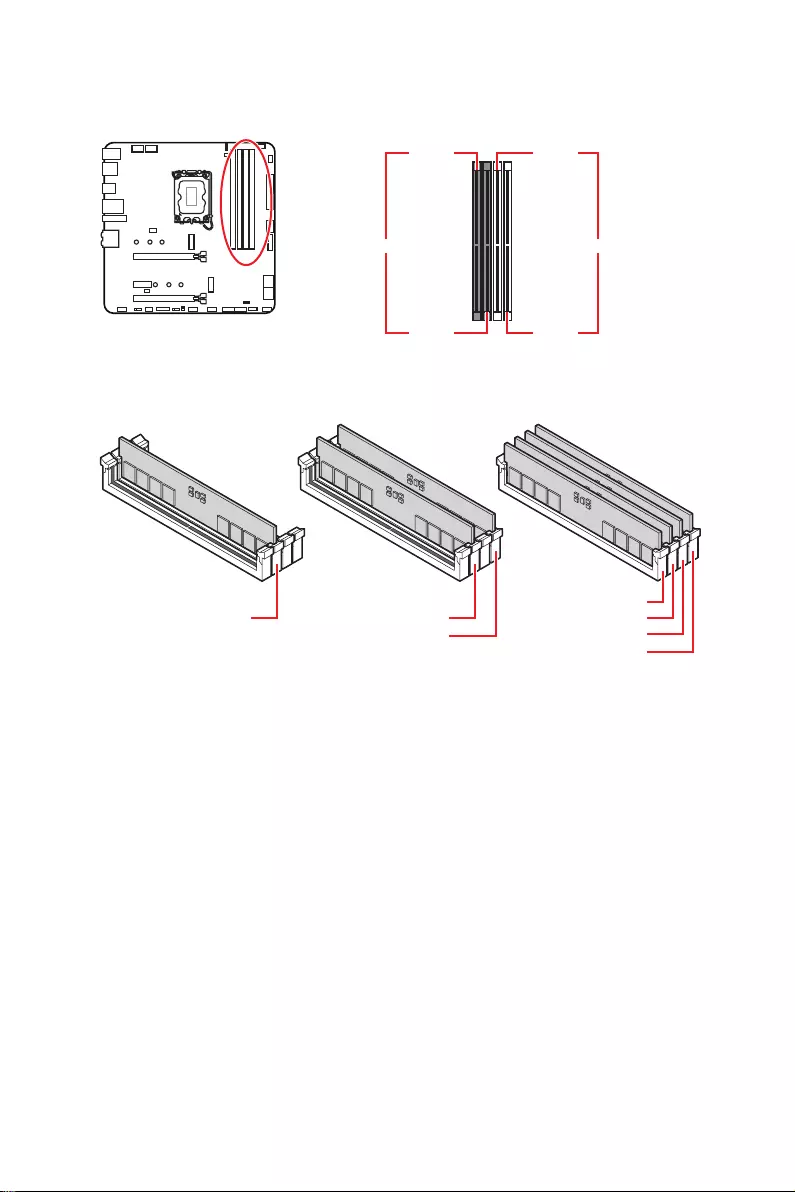
19
Overview of Components
DIMM Slots
Important
Always insert memory modules in the DIMMA2 slot first.
To ensure system stability for Dual channel mode, memory modules must be of the
same type, number and density.
Some memory modules may operate at a lower frequency than the marked value
when overclocking due to the memory frequency operates dependent on its Serial
Presence Detect (SPD). Go to BIOS and find the DRAM Frequency to set the memory
frequency if you want to operate the memory at the marked or at a higher frequency.
It is recommended to use a more efficient memory cooling system for full DIMMs
installation or overclocking.
The stability and compatibility of installed memory module depend on installed CPU
and devices when overclocking.
Please refer to www.msi.com for more information on compatible memory.
Memory module installation recommendation
DIMMA1 DIMMB1
Channel A Channel B
DIMMA2 DIMMB2
DIMMA2 DIMMA2
DIMMB2
DIMMA1
DIMMA2
DIMMB1
DIMMB2

20 Overview of Components
BAT1
PCI_E1~3: PCIe Expansion Slots
PCI_E1: PCIe 4.0 x16 (From CPU)
PCI_E2: PCIe 3.0 x1 (From Z690/ B660 chipset)
PCI_E3: PCIe 3.0 x4 (From Z690/ B660 chipset)
Important
If you install a large and heavy graphics card, you need to use a tool such as MSI
Graphics Card Bolster to support its weight to prevent deformation of the slot.
For a single PCIe x16 expansion card installation with optimum performance, using
the PCI_E1 slot is recommended.
When adding or removing expansion cards, always turn off the power supply and
unplug the power supply power cable from the power outlet. Read the expansion
card’s documentation to check for any necessary additional hardware or software
changes.
JFP1, JFP2: Front Panel Connectors
These connectors connect to the switches and LEDs on the front panel.
1
2 10
9
+
+
+
+
Power LED
HDD LED Reset Switch
Reserved
Power Switch
JFP1
1 HDD LED + 2 Power LED +
3 4
5 Reset Switch 6 Power Switch
7 Reset Switch 8 Power Switch
9 Reserved 10 No Pin
1
JFP2
+
+
Speaker
Buzzer
1 2 Buzzer +
3 4 Speaker +

21
Overview of Components
M2_1~2: M.2 Slots (Key M)
M2_1
M2_2
Important
Intel® RST only supports PCIe M.2 SSD with
UEFI ROM.
M2_2 supports Intel® Optane™ Memory.
Installing M.2 module
1. Loosen the screws of M.2 SHIELD FROZR heatsink.
2. Remove the M.2 SHIELD FROZR and remove the protective films from the thermal
pads.
2
2
1
1
1
1
M2_2
M2_1

22 Overview of Components
3. Please install the supplied EZ M.2 Clip kit in the M.2 slot according to your SSD
length.
Important
Please skip step 3 when installing the 2280 M.2 SSD.
4.
5. Rotate the EZ M.2 Clip to fix the M.2 SSD.
30º30º
5
4
3
6. Put the M.2 SHIELD FROZR heatsink back in place and secure it.
6
6
6
6

23
Overview of Components
SATA5~8 & SATA_A~B: SATA 6Gb/s Connectors
These connectors are SATA 6Gb/s interface ports. Each connector can connect to one
SATA device.
SATA_A
SATA5
SATA7
SATA_B
SATA6
SATA8
Important
transmission otherwise.
SATA cables have identical plugs on either sides of the cable. However, it is
recommended that the flat connector be connected to the motherboard for space
saving purposes.
SATA8 will be unavailable when installing M.2 SATA SSD in the M2_2 slot.
This connector allows you to connect audio jacks on the front panel.
1
2 10
9
1 MIC L 2 Ground
3 MIC R 4 NC
5 Head Phone R 6 MIC Detection
7 SENSE_SEND 8 No Pin
9 Head Phone L 10 Head Phone Detection

24 Overview of Components
JTBT1: Thunderbolt Add-on Card Connector
1
2 16
15
1 TBT_FORCE_PWR 2 TBT_S0IX_ENTRY_REQ
3 TBT_CIO_PLUG_EVENT# 4 TBT_S0IX_ENTRY_ACK
5 SLP_S3#_TBT 6 TBT_PSON_OVERRIDE_N
7 SLP_S5#_TBT 8 No Pin
9 Ground 10 SMBCLK_VSB
11 DG_PEWAKE# 12 SMBDATA_VSB
13 TBT_RTD3_PWR_EN 14 Ground
15 TBT_CARD_DET_R# 16 PD_IRQ#
JDASH1 : Tuning Controller connector
This connector is used to connect an optional Tuning Controller module.
1
2 6
5
1 No Pin 2 NC
3 MCU_SMB_SCL_M 4 MCU_SMB_SDA_M
5 VCC5 6 Ground

25
Overview of Components
24
131
12
ATX_PWR1
1 +3.3V 13 +3.3V
2 +3.3V 14
3 Ground 15 Ground
4 +5V 16
5 Ground 17 Ground
6 +5V 18 Ground
7 Ground 19 Ground
8 PWR OK 20 Res
9 5VSB 21 +5V
10 +12V 22 +5V
11 +12V 23 +5V
12 +3.3V 24 Ground
5
4 1
8CPU_PWR1~2
1 Ground 5 +12V
2 Ground 6 +12V
3 Ground 7 +12V
4 Ground 8 +12V
Important
Make sure that all the power cables are securely connected to a proper ATX power
supply to ensure stable operation of the motherboard.
These connectors allow you to connect an ATX power supply.

26 Overview of Components
JCI1: Chassis Intrusion Connector
This connector allows you to connect the chassis intrusion switch cable.
Normal
(default) Trigger the chassis
intrusion event
1. Connect the JCI1 connector to the chassis intrusion switch/ sensor on the chassis.
2. Close the chassis cover.
3. Go to BIOS > SETTINGS > Security > Chassis Intrusion Configuration.
4. Set Chassis Intrusion to Enabled.
5. Press F10 to save and exit and then press the Enter key to select Yes.
6. Once the chassis cover is opened again, a warning message will be displayed on
screen when the computer is turned on.
Resetting the chassis intrusion warning
1. Go to BIOS > SETTINGS > Security > Chassis Intrusion Configuration.
2. Set Chassis Intrusion to Reset.
3. Press F10 to save and exit and then press the Enter key to select Yes.

27
Overview of Components
This connector allows you to connect USB 3.2 Gen 1 5Gbps ports on the front panel.
Important
Note that the Power and Ground pins must be connected correctly to avoid possible
damage.
1
10 11
20
1 Power 11 USB2.0+
2 USB3_RX_DN 12
3 USB3_RX_DP 13 Ground
4 Ground 14 USB3_TX_C_DP
5 USB3_TX_C_DN 15 USB3_TX_C_DN
6 USB3_TX_C_DP 16 Ground
7 Ground 17 USB3_RX_DP
8 18 USB3_RX_DN
9 USB2.0+ 19 Power
10 Ground 20 No Pin
front panel. The connector possesses a foolproof design. When you connect the cable,
be sure to connect it with the corresponding orientation.
JUSB4
the front panel

28 Overview of Components
These connectors allow you to connect USB 2.0 ports on the front panel.
1
2 10
9
1 VCC 2 VCC
3 4
5 USB0+ 6 USB1+
7 Ground 8 Ground
9 No Pin 10 NC
Important
Note that the VCC and Ground pins must be connected correctly to avoid possible
damage.
In order to recharge your iPad, iPhone and iPod through USB ports, please install
MSI® Center utility.
JTPM1: TPM Module Connector
This connector is for TPM (Trusted Platform Module). Please refer to the TPM security
platform manual for more details and usages.
1
2 12
11
1 SPI Power 2 SPI Chip Select
3
Master In Slave Out (SPI Data)
4
Master Out Slave In (SPI Data)
5 Reserved 6 SPI Clock
7 Ground 8 SPI Reset
9 Reserved 10 No Pin
11 Reserved 12 Interrupt Request
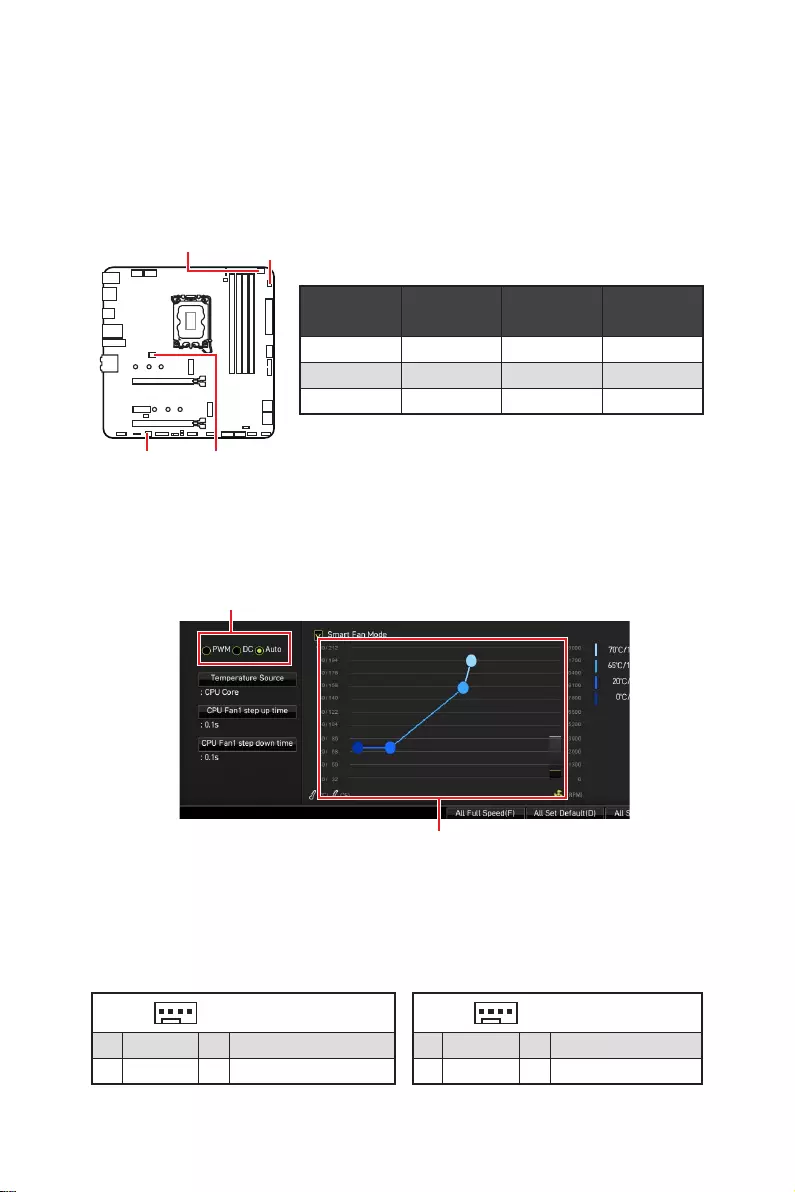
29
Overview of Components
Fan connectors can be classified as PWM (Pulse Width Modulation) Mode or DC Mode.
PWM Mode fan connectors provide constant 12V output and adjust fan speed with
speed control signal. DC Mode fan connectors control fan speed by changing voltage.
However, you can follow the instruction below to adjust the fan connector to PWM or
DC Mode manually.
Switching fan mode and adjusting fan speed
You can switch between PWM mode and DC mode and adjust fan speed in BIOS >
HARDWARE MONITOR.
Select PWM mode or DC mode
Important
Make sure fans are working properly after switching the PWM/ DC mode.
There are gradient points of the fan speed that allow you to adjust
fan speed in relation to CPU temperature.
Pin definition of fan connectors
CPU_FAN1
SYS_FAN2
PUMP_FAN1
SYS_FAN1
Connector Default fan
mode Max.
current Max.
power
CPU_FAN1 PWM mode 2A 24W
PUMP_FAN1 PWM mode 3A 36W
SYS_FAN1~2 DC mode 1A 12W
1 PWM Mode pin definition
1 Ground 2 +12V
3 Sense 4 Speed Control Signal
1 DC Mode pin definition
1 Ground 2 Voltage Control
3 Sense 4 NC

30 Overview of Components
JBAT1: Clear CMOS (Reset BIOS) Jumper
There is CMOS memory onboard that is external powered from a battery located on
the motherboard to save system configuration data. If you want to clear the system
configuration, set the jumpers to clear the CMOS memory.
Keep Data
(default) Clear CMOS/
Reset BIOS
Resetting BIOS to default values
1. Power off the computer and unplug the power cord.
2. Use a jumper cap to short JBAT1
3. Remove the jumper cap from JBAT1.
4. Plug the power cord and Power on the computer.
EZ Debug LED
These LEDs indicate the debug status of the motherboard.
DRAM
VGA
BOOT
or fail.

31
Overview of Components
Important
The JRGB connector supports up to 2 meters continuous 5050 RGB LED strips
(12V/G/R/B) with the maximum power rating of 3A (12V).
Always turn off the power supply and unplug the power cord from the power outlet
before installing or removing the RGB LED strip.
Please use MSI’s software to control the extended LED strip.
JRGB1: RGB LED connector
The JRGB connector allows you to connect the 5050 RGB LED strips 12V.
1
GRB
JRGB
connector
JRGB extension
cable 5050 RGB LED strips 12V
1
1 +12V 2 G
3 R 4 B
RGB LED Strip Connection
1
1
GRB
JRGB connector
System Fan connector
RGB LED Fan Connection
RGB LED Fan

32 Overview of Components
1
1
1
D
+5V
Do not connect the wrong type of LED strips. The JRGB connector and the JRAINBOW
connector provide different voltages, and connecting the 5V LED strip to the JRGB
connector will result in damage to the LED strip.
Important
The JRAINBOW connector supports up to 75 LEDs WS2812B Individually
Addressable RGB LED strips (5V/Data/Ground) with the maximum power rating of 3A
(5V). In the case of 20% brightness, the connector supports up to 200 LEDs.
Always turn off the power supply and unplug the power cord from the power outlet
before installing or removing the RGB LED strip.
Please use MSI’s software to control the extended LED strip.
JRAINBOW1~2: Addressable RGB LED connectors
These JRAINBOW connectors allow you to connect the WS2812B Individually
Addressable RGB LED strips 5V.
JRAINBOW
connector
JRAINBOW connector
System Fan connector
JRAINBOW
extension cable WS2812B Individually
Addressable RGB LED strips 5V
Addressable RGB LED Strip Connection
Addressable RGB LED Fan Connection
Addressable RGB LED Fan
1
JRAINBOW1
1
JRAINBOW2
1 +5V 2 Data
3 No Pin 4 Ground

33
Installing OS, Drivers & MSI Center
Installing OS, Drivers & MSI Center
Please download and update the latest utilities and drivers at www.msi.com
Installing Windows 10/ Windows 11
1. Power on the computer.
2. Insert the Windows 10/ Windows 11 installation disc/ USB into your computer.
3. Press the Restart button on the computer case.
4. Press F11
Menu.
5. Select the Windows 10/ Windows 11 installation disc/USB from the Boot Menu.
6. Press any key if screen shows Press any key to boot from CD or DVD... message.
If not please skip this step.
7. Follow the instructions on the screen to install Windows 10/ Windows 11.
Installing Drivers
1. Start up your computer in Windows 10/ Windows 11.
2. Insert MSI® DVD Drive disc into your optical drive.
3. Click the Select to choose what happens with this disc
select Run DVDSetup.exe to open the installer. If you turn off the AutoPlay feature
from the Windows Control Panel, you can still manually execute the DVDSetup.exe
from the root path of the MSI USB Drive.
4. The installer will find and list all necessary drivers in the Drivers/Software tab.
5. Click the Install
6. The drivers installation will then be in progress, after it has finished it will prompt
you to restart.
7. Click OK button to finish.
8. Restart your computer.
MSI Center
MSI Center is an application that helps you easily optimize game settings and smoothly
use content creation softwares. It also allows you to control and synchronize LED
light effects on PCs and other MSI products. With MSI Center, you can customize ideal
modes, monitor system performance, and adjust fan speed.
If you would like to know more information about MSI Center, please
refer to
http://download.msi.com/manual/mb/MSICENTER.pdf
or scan the QR code to access.
Important
Functions may vary depending on the product you have.

34
MSI UEFI BIOS is compatible with UEFI (Unified Extensible Firmware Interface)
architecture. UEFI has many new functions and advantages that traditional BIOS
cannot achieve, and it will completely replace BIOS in the future. The MSI UEFI
BIOS uses UEFI as the default boot mode to take full advantage of the new chipset’s
capabilities.
Important
The term BIOS in this user guide refers to UEFI BIOS unless otherwise noted.
test process. And also eliminates the time to switch to CSM mode during POST.
Supports for hard drive partitions larger than 2 TB.
Supports more than 4 primary partitions with a GUID Partition Table (GPT).
Supports unlimited number of partitions.
compatibility.
ensure that no malware tampers with the startup process.
32-bit Windows operating system
Older graphics card
warning message There is no GOP (Graphics Output protocol) support detected in
this graphics card.
Important
We recommend that you to replace with a GOP/UEFI compatible graphics card or
using integrated graphics from CPU for having normal function.
How to check the BIOS mode?
1. Power on your computer.
2. Press Delete key, when the Press DEL key to enter Setup Menu, F11 to enter
Boot Menu message appears on the screen during the boot process.
3. After entering the BIOS, you can check the BIOS Mode at the top of the screen.
BIOS Mode:

35
BIOS Setup
The default settings offer the optimal performance for system stability in normal
conditions. You should always keep the default settings to avoid possible system
damage or failure booting unless you are familiar with BIOS.
Important
BIOS items are continuously update for better system performance. Therefore, the
description may be slightly different from the latest BIOS and should be for reference
only. You could also refer to the HELP information panel for BIOS item description.
The BIOS screens, options and settings will vary depending on your system.
Entering BIOS Setup
Press Delete key, when the Press DEL key to enter Setup Menu, F11 to enter Boot
Menu message appears on the screen during the boot process.
Function key
F1: General Help list
F2: Add/ Remove a favorite item
F3: Enter Favorites menu
F4: Enter CPU Specifications menu
F5
F6: Load optimized defaults
F7: Switch between Advanced mode and EZ mode
F8: Load Overclocking Profile
F9: Save Overclocking Profile
F10: Save Change and Reset*
F12: Take a screenshot and save it to USB flash drive (FAT/ FAT32 format only).
Ctrl+F: Enter Search page
* When you press F10, a confirmation window appears and it provides the modification
information. Select between Yes or No to confirm your choice.
If you’d like to know more instructions on setting up the BIOS, please
refer to
http://download.msi.com/manual/mb/Intel600BIOS.pdf
or scan the QR code to access.

36
Resetting BIOS
You might need to restore the default BIOS setting to solve certain problems. There
are several ways to reset BIOS:
Go to BIOS and press F6 to load optimized defaults.
Short the Clear CMOS jumper on the motherboard.
Important
Be sure the computer is off before clearing CMOS data. Please refer to the Clear
CMOS jumper section for resetting BIOS.
Before updating:
Please download the latest BIOS file that matches your motherboard model from MSI
website. And then save the BIOS file into the USB flash drive.
Updating BIOS:
1. Insert the USB flash drive that contains the update file into the USB port.
2. Please refer the following methods to enter flash mode.
Reboot and press Ctrl + F5 key during POST and click on Yes to reboot the
system.
Reboot and press Del key during POST to enter BIOS. Click the M-FLASH button
and click on Yes to reboot the system.
3. Select a BIOS file to perform the BIOS update process.
4. When prompted click on Yes to start recovering BIOS.
5. After the flashing process is 100% completed, the system will reboot
automatically.

37
Before updating:
Make sure the LAN driver is already installed and the internet connection is set
properly.
Please close all other application software before updating the BIOS.
To update BIOS:
1. Install and launch MSI Center and go to Support page.
2. Select and click on Advance button.
3. Select the BIOS file and click on Install button.
4. The installation reminder will appear, then click the Install button on it.
5. The system will automatically restart to update BIOS.
6. After the flashing process is 100% completed, the system will restart
automatically.


1
Inhalt
Inhalt
Sicherheitshinweis ......................................................................................3
Hinweise zum Gehäuseabstandshalter ................................................................. 4
Hinweis zur Schadensvermeidung ......................................................................... 4
Spezifikationen ............................................................................................ 5
Packungsinhalt ..........................................................................................12
Rückseite E/A ............................................................................................13
LAN Port LED Zustandstabelle ............................................................................ 13
Konfiguration der Audioanschlüsse ..................................................................... 13
Realtek Audio Console ......................................................................................... 14
Übersicht der Komponenten ......................................................................17
CPU Sockel ........................................................................................................... 18
DIMM Steckplätze ................................................................................................. 19
PCI_E1~3: PCIe Erweiterungssteckplätze ........................................................... 20
................................................................... 20
M2_1~2: M.2 Steckplätze (Key M) ........................................................................ 21
SATA5~8 & SATA_A~B: SATA 6Gb/s Anschlüsse ................................................. 23
JAUD1: Audioanschluss des Frontpanels ............................................................ 23
...................................... 24
................................................................ 24
CPU_PWR1~2, ATX_PWR1: Stromanschlüsse .................................................... 25
JCI1: Gehäusekontaktanschluss .......................................................................... 26
............................................... 27
JUSB3: USB 3.2 Gen 1 5Gbit/s Anschluss ............................................................ 27
JUSB1~2: USB 2.0 Anschlüsse ............................................................................. 28
JTPM1: TPM Anschluss ........................................................................................ 28
CPU_FAN1, PUMP_FAN1, SYS_FAN1~2: Stromanschlüsse für Lüfter .............. 29
JBAT1: Clear CMOS Steckbrücke (Reset BIOS) ................................................... 30
EZ DEBUG LED ..................................................................................................... 30
JRGB1: RGB LED Anschluss ................................................................................ 31
........................ 32
Installation von OS, Treibern & MSI Center ............................................... 33
Installation von Windows 10/ Windows 11 ........................................................... 33
Installation von Treibern ...................................................................................... 33
MSI Center ............................................................................................................ 34
Deutsch

2Inhalt
..................................................................................................35
BIOS Setup ............................................................................................................ 36
Öffnen des BIOS Setups........................................................................................ 36
...................................................................................... 36
Reset des BIOS ..................................................................................................... 37
Aktualisierung des BIOS ....................................................................................... 37

3
Sicherheitshinweis
Sicherheitshinweis
Die im Paket enthaltene Komponenten sind der Beschädigung durch
elektrostatischen Entladung (ESD). Beachten Sie bitte die folgenden Hinweise, um die
erfolgreichen Computermontage sicherzustellen.
Stellen Sie sicher, dass alle Komponenten fest angeschlossen sind. Lockere
Steckverbindungen können Probleme verursachen, zum Beispiel: Der Computer
erkennt eine Komponente nicht oder startet nicht.
Halten Sie das Motherboard nur an den Rändern fest, und verhindern Sie die
Berührung der sensiblen Komponenten.
Um eine Beschädigung der Komponenten durch elektrostatische Entladung
(ESD) zu vermeiden, sollten Sie eines elektrostatischen Armbands während der
Handhabung des Motherboards tragen. Wenn kein elektrostatischen Handgelenkband
vorhanden ist, sollten Sie Ihre statische Elektrizität ableiten, indem Sie ein anderes
Metallobjekt berühren, bevor Sie das Motherboard anfassen.
Bewahren Sie das Motherboard in einer elektrostatische Abschirmung oder einem
Antistatiktuch auf, wenn das Motherboard nicht installiert ist.
Überprüfen Sie vor dem Einschalten des Computers, dass sich keine losen
Schrauben und andere Bauteile auf dem Motherboard oder im Computergehäuse
befinden
Bitte starten Sie den Computer nicht, bevor die Installation abgeschlossen ist.
Dies könnte permanente Schäden an den Komponenten sowie zu das Verletzung des
Benutzers verursachen.
Sollten Sie Hilfe bei der Installation benötigen, wenden Sie sich bitte an einen
Schalten Sie die Stromversorgung aus und ziehen Sie das das Stromkabel ab, bevor
Bewahren Sie die Bedienungsanleitung als künftige Referenz auf.
Halten Sie das Motherboard von Feuchtigkeit fern
Bitte stellen Sie sicher, dass Ihre Netzspannung den Hinweisen auf dem Netzteil vor
Anschluss des Netzteils an die Steckdose entspricht
Verlegen Sie das Netzkabel so, dass niemand versehentlich darauf treten kann.
Stellen Sie nichts auf dem Netzkabel ab.
Falls einer der folgenden Umstände eintritt, lassen Sie bitte das Motherboard von
Kundendienstpersonal prüfen:
Flüssigkeit ist in dem Computer eingedrungen.
Das Motherboard wurde Feuchtigkeit ausgesetzt.
Das Motherboard funktioniert nicht richtig oder Sie können es nicht wie in der
Bedienungsanleitung beschrieben bedienen.
Das Motherboard ist heruntergefallen und beschädigt.
Das Motherboard weist offensichtlich Zeichen eines Schadens auf.
Nutzen und lagern Sie das Gerät nicht an Stellen, an denen Temperaturen von mehr

4Sicherheitshinweis
Hinweise zum Gehäuseabstandshalter
Um eine Beschädigung des Motherboards zu vermeiden, sind unnötige Abstandshalter
. Die
Schilder „Case Standoff Keep Out Zone (Gehäuseabstandszone freihalten )“ auf der
Rückseite des Motherboards (wie unten gezeigt) dienen als entsprechender Hinweis
für den Anwender.
Hinweis zur Schadensvermeidung
Um jedes Schraubenloch ist eine Schutzfarbe aufgedruckt, um ein Verkratzen der
Teile zu verhindern.
* Die obige Bilder stellen lediglich Referenzen dar und können von dem von Ihnen
erworbenen Produkt abweichen

5
Spezifikationen
Spezifikationen
Unterstützt Intel® Core™ der 12. Generation Prozessoren,
Pentium® Gold und Celeron® Prozessoren*
Prozessor Sockel LGA1700
erhalten, wenn neue Prozessoren veröffentlicht werden.
Chipsatz
Intel® Z690 Chipsatz (MAG Z690M MORTAR WIFI)
Intel® B660 Chipsatz (MAG B660M MORTAR WIFI/ MAG
B660M MORTAR)
Speicher
4x DDR5 Speicherplätze, aufrüstbar bis 128 GB*
Unterstützt 1R 4800 MHz (durch JEDEC & POR)
Maximale Übertaktfrequenz:
1DPC 1R max. Übertragungsraten bis zu 6200+ MHz
1DPC 2R max. Übertragungsraten bis zu 5200+ MHz
2DPC 1R max. Übertragungsraten bis zu 4000+ MHz
2DPC 2R max. Übertragungsraten bis zu 4000+ MHz
Unterstützt Intel® XMP 3.0 OC
* Weitere Informationen zu kompatiblen Speichermodulen finden Sie unter:
www.msi.com.
Erweiterung-
anschlüsse
2x PCIe x16 Steckplätze
PCI_E1 Steckplatz (von CPU)
Unterstützt PCIe 4.0 x16
PCI_E3 Steckplatz (von Z690/ B660 Chipsatz)
Unterstützt PCIe 3.0 x4
1x PCIe 3.0 x1 Steckplätze
Onboard-Grafik
1x HDMI 2.1 mit HDR Anschluss, Unterstützung einer
maximalen Auflösung von 4K 60Hz*/**
1x DisplayPort 1.4 Anschluss mit HBR3, Unterstützung
einer maximalen Auflösung von 4K 60Hz*/**
*Es ist verfügbar für den Prozessor mit integrierter Grafik.
variieren.
Fortsetzung auf der nächsten Seite

6Spezifikationen
Fortsetzung der vorherigen Seite
Aufbewahrung
4x SATA 6Gb/s Anschlüsse (SATA5~8 von Z690/ B660
Chipsatz)*
2x SATA 6Gb/s Anschlüsse (SATA_A & SATA_B, von
ASMedia ASM1061)
2x M.2 Steckplätze (Key M)
M2_1 Steckplatz (von CPU)
Unterstützt PCIe 4.0 x4
Unterstützt 2242/ 2260/ 2280 Speichergeräte
M2_2 Steckplatz (von Z690/ B660 Chipsatz)
Unterstützt PCIe 4.0 x4
Unterstützt bis zu SATA 6Gb/s
Unterstützt 2242/ 2260/ 2280 Speichergeräte
Unterstützt Intel® Optane™ Memory
* Der SATA8 Anschluss wird nicht zur Verfügung stehen, wenn Sie eine M.2
SATA SSD im M2_2 Steckplatz installieren.
RAID
Unterstützt RAID 0, RAID 1, RAID 5 und RAID 10 für SATA
Speichergeräte*
Intel® Z690/ B660 Chipsatz
der rückseitigen Anschlussleiste
durch die internen Anschlüsse
2x USB 3.2 Gen 1 5Gbit/s Anschlüsse stehen durch die
internen Anschlüsse
4x USB 2.0 Anschlüsse an der rückseitigen
Anschlussleiste
USB 2.0 Hub GL3590
rückseitigen Anschlussleiste
USB 2.0 Hub GL850G
4x USB 2.0 Anschlüsse stehen durch die internen
Anschlüsse
Fortsetzung auf der nächsten Seite

7
Spezifikationen
Fortsetzung der vorherigen Seite
Audio
Realtek® ALC1200 Codec
LAN 1x Intel® 8125BG 2,5Gbit/s LAN Controller
Wireless LAN &
Bluetooth®
(Für MAG Z690M
MORTAR WIFI/ MAG
B660M MORTAR
WIFI)
vorinstalliert
(160MHz) mit Datenraten bis zu 2,4Gbit/s
Unterstützt 802.11 a/ b/ g/ n/ ac/ ax
Unterstützt Bluetooth® 5.2**, FIPS, FISMA
Windows 10 version 21H1 und Windows 11 bereit sein.
** Bluetooth 5.2 wird in Windows 10 Version 21H1 und Windows 11 verfügbar
sein.
Interne Anschlüsse
6x SATA 6Gb/s Anschlüsse
2x M.2 Steckplätze (Key M)
1x USB 3.2 Gen 1 5Gbit/s Anschluss (unterstützt
zusätzliche 2 USB 3.2 Gen 1 5Gbit/s Anschlüsse)
USB 2.0 Anschlüsse)
1x Audioanschluss des Frontpanels
1x Gehäusekontaktschalter
1x Clear CMOS Steckbrücke
1x TPM Anschluss
1x TBT Anschluss (Unterstützt RTD3)
Fortsetzung auf der nächsten Seite

8Spezifikationen
Fortsetzung der vorherigen Seite
LED Funktionen
4x EZ Debug LED
Hintere Ein-/ und
Ausgänge
1x DisplayPort
1x HDMI Anschluss
1x 2,5Gbit/s LAN (RJ45) Anschluss
WIFI/ MAG B660M MORTAR WIFI)
5x Audiobuchsen
E/A Anschluss NUVOTON NCT6687D Controller Chip
Hardware Monitor
CPU/ System/ Chipsatz Temperaturerfassung
Formfaktor
9,6 Zoll x 9,6 Zoll (24,4 cm x 24,4 cm)
BIOS Funktionen
1x 256 Mb Flash
UEFI AMI BIOS
ACPI 6.4, SMBIOS 3.4
Mehrsprachenunterstützung
Fortsetzung auf der nächsten Seite

9
Spezifikationen
Fortsetzung der vorherigen Seite
Software
Treiber
MSI Center
Intel® Extreme Tuning Utility
MSI APP Player (BlueStacks)
Open Broadcaster Software (OBS)
Google Chrome™, Google Toolbar, Google Drive
Norton™ Internet Security Solution
MSI Center
Funktionen
Gaming Modus
Smart Priority
Game Highlights
LAN Manager
Mystic Light
Umgebungsgeräte
Frozr AI Kühlung
True Color
Live Update
Hardware Monitor
Super Charger
Speed Up
Smart Image Finder
MSI Companion
Fortsetzung auf der nächsten Seite

10 Spezifikationen
Fortsetzung der vorherigen Seite
Besondere
Funktionen
Audio
Audio Boost
Netzwerk
2.5G LAN
LAN Manager
Intel WiFi (Für MAG Z690M MORTAR WIFI/ MAG B660M
MORTAR WIFI)
Kühlung
Erweitertes Kühlkörperdesign
M.2 Shield Frozr
7W/mK MOSFET Thermalpad
Choke Thermalpad
LED
Mystic Light Extension (RGB)
Mystic Light Extension (RAINBOW)
Mystic Light SYNC
Unterstützung für Umgebungsgeräte
EZ LED Steuerung
EZ DEBUG LED
Fortsetzung auf der nächsten Seite

11
Spezifikationen
Fortsetzung der vorherigen Seite
Besondere
Funktionen
Leistung
Lightning Gen 4 M.2
Memory Boost
Core Boost
Game Boost
Lightning USB 20G
USB 3.2 Gen 2 10G
USB Anschluss mit Typ A+C
2oz Kupfer verdicktes PCB
Schutz
Vorinstallierte Anschlussblende
Erfahrung
MSI Center
EZ M.2 Clip
Click BIOS 5
CPU Cooler Tuning (Für MAG B660M MORTAR WIFI/
MAG B660M MORTAR)
Frozr AI Kühlung
Tile (Für MAG Z690M MORTAR WIFI/ MAG B660M
MORTAR WIFI)

12 Packungsinhalt
Packungsinhalt
Überprüfen Sie den Packungsinhalt des Mainboards. Die Packung sollte enthalten:
Motherboard
MAG Z690M
MORTAR
WIFI
MAG B660M
MORTAR
WIFI
MAG B660M
MORTAR
Dokumentation
anleitung 1 1 1
Anwendung
1 1 1
Kabel
SATA 6Gb/s Kabel (2
Kabel pro Packung) 1 1 1
Zubehör
1 1
1 1 1
EZ M.2 Clip (1 Kabel
pro Packung) 2 2 2
1 1 1
registrierungskarte 1 1 1
Geschenke
Kleine
Sätze 1 1
Wichtig
Falls einer der oben aufgeführten Artikel beschädigt ist oder fehlt, wenden Sie sich
bitte an Ihren Händler.

13
Rückseite E/A
Konfiguration der Audioanschlüsse
Audioanschlüsse Kanal
2468
Hinterer Lautsprecher
Lautsprecher
Lautsprecher
Mic In
Blank: Leer)
LAN Port LED Zustandstabelle
Verbindung/ Aktivität LED
Zustand Bezeichnung
Aus Keine Verbindung
Gelb Verbindung
Blinkt Datenaktivität
Geschwindigkeit LED
Zustand Bezeichnung
Aus 10 Mbit/s Verbindung
Grün 100/1000 Mbit/s Verbindung
Orange 2,5 Gbit/s Verbindung
2,5 Gbit/s LAN
Audiobuchsen
Antennenanschlüsse
(optional)
DisplayPort
USB 3.2 Gen 2
USB 3.2 Gen 2x2
Ausgang
Rückseite E/A

14 Rückseite E/A
Realtek Audio Console
Audioeinstellungen verändern, um ein optimales Klangerlebnis erzeugen.
Geräteauswahl
aktivierte Gerät ist mit einem Haken gekennzeichnet.
Optimierungen
Lautstärke
Verbindungsstatus
Anschlüsse
Auto Popup-Dialog
fragt nach einer Bestätigung für das angeschlossene Gerät.
Jede Buchse entspricht diesem Wert der Grundeinstellung, wie es auf den nächsten
Seiten gezeigt wird.
Wichtig
Die obige Bilder stellen lediglich Referenzen dar und können von dem von Ihnen
erworbenen Produkt abweichen
Verbindungsstatus
Anschluss
Geräteauswahl
Lautstärke
Optimierungen
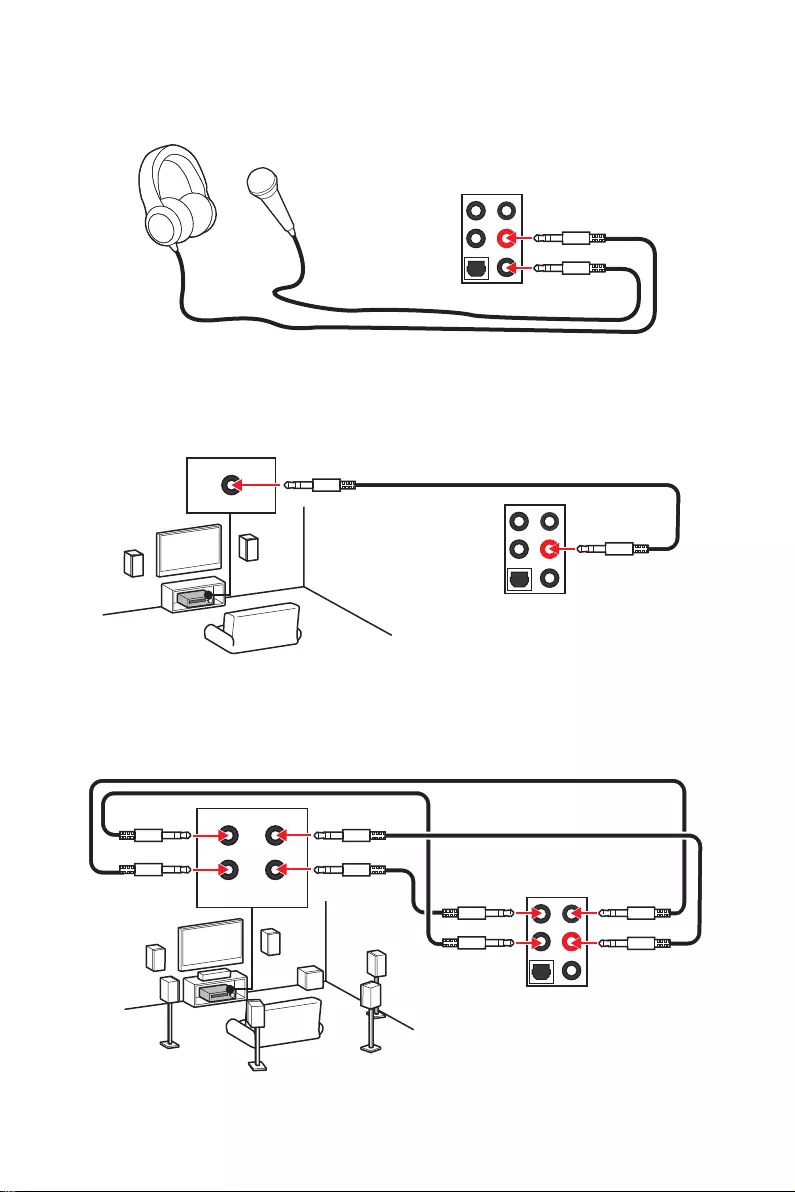
15
Rückseite E/A
Audiobuchsen für den Anschluss von einem Kopfhörer und Mikrofon
Audiobuchsen für Stereo-Lautsprecher
Audiobuchsen für 7.1 Kanal Anlage
AUDIO INPUT
AUDIO INPUT
Rear Front
Side Center/
Subwoofer

16 Rückseite E/A
Antennen installieren
1. Schrauben Sie die Antennen fest an die Antennenanschlüsse, wie gezeigt.
2. Richten Sie die Antennenspitzen aus.
1
2

17
Übersicht der Komponenten
Übersicht der Komponenten
BAT1
JTPM1
JRGB1
M2_2
M2_1
SYS_FAN1
JFP2
JFP1
JBAT1
JRAINBOW2
JUSB2
JCI1
PUMP_FAN1
PCI_E1
PCI_E2
JDASH1
PCI_E3
JTBT1
Prozessor Sockel
CPU_PWR1 JSMB1
JRAINBOW1
CPU_PWR2
CPU_FAN1
JUSB4
JUSB3
JAUD1
JUSB1
SYS_FAN2 SATA7
SATA8
ATX_PWR1
DIMMB1
DIMMB2
DIMMA1
DIMMA2
(optional)

18 Übersicht der Komponenten
Wichtig
Bitte bewahren Sie die CPU Schutzkappe nach der Installation des Prozessors auf.
MSI wird RMA (Return Merchandise Authorization) Anfragen nur dann behandeln,
und die Systemstabilität zu gewährleisten.
Stellen Sie sicher, dass Ihr Kühlkörper eine feste Verbindung mit der CPU
hergestellt hat, bevor Sie Ihr System starten.
Überhitzung beschädigt die CPU und das System nachhaltig. Stellen Sie stets eine
korrekte Funktionsweise des CPU Kühlers sicher, um die CPU vor Überhitzung zu
schützen. Stellen Sie sicher, dass eine gleichmäßige Schicht thermischer Paste oder
thermischen Tapes zwischen der CPU und dem Kühlkörper vorhanden ist, um die
Wärmeableitung zu erhöhen.
installiert ist.
Verwenden Sie bitte die Installationsanweisung des Kühlkörpers/Kühlers, falls Sie
eine seperate CPU oder einen Kühlkörper/ Kühler erworben haben.
Dieses Motherboard wurde so entworfen, dass es Übertakten unterstützt. Stellen
Sie jedoch bitte sicher, dass die betroffenen Komponenten mit den abweichenden
Einstellungen während des Übertaktens zurecht kommen. Von jedem Versuch
des Betriebes außerhalb der Produktspezifikationen kann nur abgeraten werden.
MSI übernehmt keinerlei Garantie für die Schäden und Risiken, die aus einem
unzulässigem Betrieb oder einem Betrieb außerhalb der Produktspezifikation
resultieren.
Die Oberseite der LGA 1700 CPU hat vier
Justierungen und ein goldenes Dreieck
um die korrekte Ausrichtung der CPU
auf dem Motherboard zu gewährleisten.
Das goldene Dreieck des Prozessors
definiert die Position des ersten Pins.
Abstand zwischen der Mitte der
Steckplatz.
52,76 mm

19
Übersicht der Komponenten
DIMM Steckplätze
Wichtig
Um einen sicheren Systemstart zu gewährleisten, bestücken Sie immer DIMMA2
zuerst.
Typs und identischer Speicherdichte in den DIMM Slots unterschiedlicher Kanäle
verwenden.
Einige Speichermodule können beim Übertakten auf einer niedrigeren Frequenz
DRAM Frequency die Speicherfrequenz ein, wenn Sie
mit der festgelegten oder einer höheren Speicherfrequenz arbeiten möchten.
Es wird empfohlen, ein effizienteres Speicherkühlsystem bei einer Vollbestückung
des DIMMs oder beim Übertakten zu verwenden.
Die Stabilität und Kompatibilität beim Übertakten der installierten Speichermodule
sind abhängig von der installierten CPU und den installierten Geräten.
Weitere Informationen zu kompatiblen Speichermodulen finden Sie unter: www.
msi.com.
Speichermodul-Installationsempfehlung
DIMMA1 DIMMB1
Kanal A Kanal B
DIMMA2 DIMMB2
DIMMA2 DIMMA2
DIMMB2
DIMMA1
DIMMA2
DIMMB1
DIMMB2

20 Übersicht der Komponenten
BAT1
PCI_E1~3: PCIe Erweiterungssteckplätze
PCI_E1: PCIe 4.0 x16 (von CPU)
PCI_E2: PCIe 3.0 x1 (von Z690/ B660 Chipsatz)
PCI_E3: PCIe 3.0 x4 (von Z690/ B660 Chipsatz)
Wichtig
Wenn Sie eine große und schwere Grafikkarte einbauen, benötigen Sie einen
Verformung des Steckplatzes vermeidet.
Für die Installation einer einzelnen PCIe x16 Erweiterungskarte mit optimaler
Leistung, empfehlen wir den PCI_E1 Steckplatz zu verwenden.
Achten Sie darauf, dass Sie den Strom abschalten und das Netzkabel aus der
Steckdose herausziehen, bevor Sie eine Erweiterungskarte installieren oder
entfernen. Lesen Sie bitte auch die Dokumentation der Erweiterungskarte, um
JFP1, JFP2: Frontpanel-Anschlüsse
Diese Anschlüsse verbinden die Schalter und LEDs des Frontpanels.
1
2 10
9
+
+
+
+
Power LED
HDD LED Reset Switch
Reserved
Power Switch
JFP1
1 HDD LED + 2 Power LED +
3 4
5 Reset Switch 6 Power Switch
7 Reset Switch 8 Power Switch
9 Reserved 10 No Pin
1
JFP2
+
+
Speaker
Buzzer
1 2 Buzzer +
3 4 Speaker +

21
Übersicht der Komponenten
M2_1~2: M.2 Steckplätze (Key M)
M2_1
M2_2
Wichtig
Intel® RST unterstützt nur PCIe M.2 SSD mit
UEFI ROM.
M2_2 unterstützt Intel® Optane™ Memory
Installation eines M.2 Moduls
1.
2.
Wärmeleitpads.
2
2
1
1
1
1
M2_2
M2_1

22 Übersicht der Komponenten
3. Wenn kein EZ M.2 Clip installiert ist, installieren Sie bitte das mitgelieferte EZ M.2
Wichtig
Bitte überspringen Sie Schritt 3, wenn Sie die 2280 M.2 SSD installieren.
4.
5. Drehen Sie den EZ M.2 Clip, um die M.2 SSD zu befestigen.
30º30º
5
4
3
6.
6
6
6
6

23
Übersicht der Komponenten
SATA5~8 & SATA_A~B: SATA 6Gb/s Anschlüsse
Dieser Anschluss basiert auf der Hochgeschwindigkeitsschnittstelle SATA 6 Gb/s. Pro
Anschluss kann ein SATA Gerät angeschlossen werden.
SATA_A
SATA5
SATA7
SATAB
SATA6
SATA8
Wichtig
Folge sein.
flachen Stecker auf dem Motherboard einstecken.
Der SATA8 Anschluss wird nicht zur Verfügung stehen, wenn Sie eine M.2 SATA SSD
im M2_2 Steckplatz installieren.
Dieser Anschluss ermöglicht den Anschluss von Audiobuchsen eines Frontpanels.
1
2 10
9
1 MIC L 2 Ground
3 MIC R 4 NC
5 Head Phone R 6 MIC Detection
7 SENSE_SEND 8 No Pin
9 Head Phone L 10 Head Phone Detection

24 Übersicht der Komponenten
JTBT1: Anschluss für Thunderbolt-Erweiterungskarte
Erweiterungskarte anschließen.
1
2 16
15
1 TBT_FORCE_PWR 2 TBT_S0IX_ENTRY_REQ
3 TBT_CIO_PLUG_EVENT# 4 TBT_S0IX_ENTRY_ACK
5 SLP_S3#_TBT 6 TBT_PSON_OVERRIDE_N
7 SLP_S5#_TBT 8 No Pin
9 Ground 10 SMBCLK_VSB
11 DG_PEWAKE# 12 SMBDATA_VSB
13 TBT_RTD3_PWR_EN 14 Ground
15 TBT_CARD_DET_R# 16 PD_IRQ#
JDASH1: Tuning Controller-Anschluss
1
2 6
5
1 No Pin 2 NC
3 MCU_SMB_SCL_M 4 MCU_SMB_SDA_M
5 VCC5 6 Ground

25
Übersicht der Komponenten
24
131
12
ATX_PWR1
1 +3,3V 13 +3,3V
2 +3,3V 14
3 Ground 15 Ground
4 +5V 16
5 Ground 17 Ground
6 +5V 18 Ground
7 Ground 19 Ground
8 PWR OK 20 Res
9 5VSB 21 +5V
10 +12V 22 +5V
11 +12V 23 +5V
12 +3,3V 24 Ground
5
4 1
8CPU_PWR1~2
1 Ground 5 +12V
2 Ground 6 +12V
3 Ground 7 +12V
4 Ground 8 +12V
Wichtig
Stellen Sie sicher, dass alle Anschlüsse mit den richtigen Anschlüssen des Netzteils
verbunden sind, um einen stabilen Betrieb der Hauptplatine sicherzustellen
Mit diesen Anschlüssen verbinden Sie die ATX Stromstecker.

26 Übersicht der Komponenten
JCI1: Gehäusekontaktanschluss
Dieser Anschluss wird mit einem Kontaktschalter verbunden
Normal
(Standardwert) Löse den
Gehäuseeingriff aus
Gehäusekontakt-Detektor verwenden
1. Schließen Sie den JCI1
Gehäuse an.
2. Schließen Sie die Gehäuseabdeckung.
3. Gehen Sie zu BIOS > SETTINGS > Security > Chassis Intrusion Configuration.
4. Stellen Sie Chassis Intrusion auf Enabled.
5. Drücken Sie F10 zum Speichern und Beenden und drücken Sie dann die Enter
Taste, um Ja auszuwählen.
6. Bei eingeschaltetem Computer wird eine Warnmeldung auf dem Bildschirm
angezeigt, wenn die Gehäuseabdeckung wieder geöffnet wird.
Gehäusekontakt-Warnung zurücksetzen
1. Gehen Sie zu BIOS > SETTINGS > Security > Chassis Intrusion Configuration.
2. Stellen Sie Chassis Intrusion auf Reset.
3. Drücken Sie F10 zum Speichern und Beenden und drücken Sie dann die Enter
Taste, um Ja auszuwählen.

27
Übersicht der Komponenten
Mit diesem Anschluss können Sie die USB 3.2 Gen 1 5Gbit/s Anschlüsse auf dem
Frontpanel verbinden.
Wichtig
Bitte beachten Sie, dass Sie die mit „Stromführende Leitung“ und „Erdleitung“
bezeichneten Pins korrekt verbinden müssen, ansonsten kann es zu Schäden
kommen.
1
10 11
20
1 Power 11 USB2.0+
2 USB3_RX_DN 12
3 USB3_RX_DP 13 Ground
4 Ground 14 USB3_TX_C_DP
5 USB3_TX_C_DN 15 USB3_TX_C_DN
6 USB3_TX_C_DP 16 Ground
7 Ground 17 USB3_RX_DP
8 18 USB3_RX_DN
9 USB2.0+ 19 Power
10 Ground 20 No Pin
auf dem Frontpanel verbinden. Der Anschluss verfügt über ein besonders sicheres
Design. Wenn Sie das Kabel anschließen, müssen Sie es in der entsprechenden
Ausrichtung verbinden.
JUSB4
Anschluss auf dem
Frontpanel

28 Übersicht der Komponenten
Mit diesen Anschlüssen können Sie die USB 2.0 Anschlüsse auf dem Frontpanel
verbinden.
1
2 10
9
1 VCC 2 VCC
3 4
5 USB0+ 6 USB1+
7 Ground 8 Ground
9 No Pin 10 NC
Wichtig
Bitte beachten Sie, dass Sie die mit VCC (Stromführende Leitung) und Ground
(Erdung) bezeichneten Pins korrekt verbinden müssen, ansonsten kann es zu Schäden
kommen.
JTPM1: TPM Anschluss
Dieser Anschluss wird für das TPM Modul (Trusted Platform Module) verwendet.
Weitere Informationen über den Einsatz des optionalen TPM Modules entnehmen Sie
bitte dem TPM Plattform Handbuch.
1
2 12
11
1 SPI Power 2 SPI Chip Select
3
Master In Slave Out (SPI Data)
4
Master Out Slave In (SPI Data)
5 Reserved 6 SPI Clock
7 Ground 8 SPI Reset
9 Reserved 10 No Pin
11 Reserved 12 Interrupt Request

29
Übersicht der Komponenten
Diese Anschlüsse können im PWM (Pulse Width Modulation) Modus
Lüfteranschlüsse konstante 12V Ausgang und regeln die Lüftergeschwindigkeit
Sie können unter BIOS > HARDWARE MONITOR
umschalten und die Lüfterdrehzahl ändern.
Wählen Sie den PWMDC
Wichtig
Überprüfen Sie die ordnungsgemäße Funktion der Lüfter nach dem Umschalten des
Die Gradientenpunkte des Lüfterverlaufs erlauben die
Temperatur.
Pin-Belegung der Lüfteranschlüsse
CPU_FAN1
SYS_FAN2
PUMP_FAN1
SYS_FAN1
Anschluss Standard-
lüftermodus Max.
Strom Max.
Leistung
CPU_FAN1 PWM Modus 2A 24W
PUMP_FAN1 PWM Modus 3A 36W
SYS_FAN1~2 DC Modus 1A 12W
1 Pin-Belegung des PWM-Modus
1 Ground 2 +12V
3 Sense 4 Speed Control Signal
1 Pin-Belegung des DC-Modus
1 Ground 2 Voltage Control
3 Sense 4 NC

30 Übersicht der Komponenten
JBAT1: Clear CMOS Steckbrücke (Reset BIOS)
Der Onboard CMOS Speicher (RAM) wird durch eine externe Spannungsversorgung
durch eine Batterie auf dem Motherboard versorgt, um die Daten der
Systemkonfiguration zu speichern. Wenn Sie die Systemkonfiguration löschen wollen,
müssen Sie die Steckbrücke für kurze Zeit umsetzen.
Daten
beibehalten
(Standardwert)
löschen/ Reset
des BIOS
Rücksetzen des BIOS auf Standardwerte
1. Schalten Sie den Computer ab und ziehen Sie das Netzkabel ab.
2. Verwenden Sie eine Steckbrücke, um JBAT1
3. Entfernen Sie die Steckbrücke von JBAT1.
4. Stecken Sie das Kabel Ihres Computers in die Steckdose hinein und schalten Sie
den Computer ein.
DRAM
VGA
BOOT
fehlerhaft.

31
Übersicht der Komponenten
Wichtig
R/B) mit der maximalen Leistung von 3 A (12 V)
Schalten Sie die Stromversorgung aus und ziehen Sie das Netzkabel ab, bevor Sie
JRGB1: RGB LED Anschluss
1
GRB
JRGB
Anschluss
JRGB
Verlängerungskabel 5050 RGB LED Streifen 12V
1
1 +12V 2 G
3 R 4 B
RGB-LED-Streifen anschließen
1
1
GRB
JRGB Anschluss
RGB-LED-Lüfteranschluss
RGB LED Lüfter

32 Übersicht der Komponenten
1
1
1
D
+5V
Wichtig
Der JRAINBOW Anschluss unterstützt bis zu up to 75 LEDs WS2812B einzeln
von 3 A (5 V). Bei einer Helligkeit von 20 Prozent unterstützt dieser Anschluss bis zu
200 LEDs.
Schalten Sie die Stromversorgung aus und ziehen Sie das Netzkabel ab, bevor Sie
JRAINBOW1~2: Adressierbarer RGB-LED-Streifen Anschlüsse
JRAINBOW
Anschluss
JRAINBOW Anschluss
JRAINBOW
Verlängerungskabel WS2812B einzeln adressierbare
Adressierbarer RGB-LED-Streifen anschließen
Adressierbarer RGB-LED-Streifen anschließen
1
JRAINBOW1
1
JRAINBOW2
1 +5V 2 Data
3 No Pin 4 Ground

33
Installation von OS, Treibern & MSI Center
Installation von OS, Treibern & MSI Center
Laden Sie die neuesten Treiber und Dienstprogramme von www.msi.com herunter
und aktualisieren Sie sie.
Installation von Windows 10/ Windows 11
1. Schalten Sie den Computer ein.
2.
Flashlaufwerk in das optisches Laufwerk.
3. Drücken Sie die Taste Restart auf dem Computergehäuse.
4. Drücken Sie die F11
das Bootmenu zu öffnen.
5.
Bootmenu.
6. Wenn eine entsprechende Meldung Press any key to boot from CD or
DVD...angezeigt wird, drücken Sie eine beliebige Taste Wenn diese Nachricht nicht
angezeigt wird, überspringen Sie bitte diesen Schritt.
7. Folgen Sie den Anweisungen auf dem Bildschirm, um das Dienstprogramm
„Windows® 10/ Windows 11“ zu installieren.
Installation von Treibern
1. Starten Sie Ihren Computer mit Windows 10/ Windows 11.
2. Legen Sie die MSI® Treiber Disk in das optische Laufwerk.
3. Wählen Sie eine Aktion für
Wechseldatenträger aus , und wählen Sie DVDSetup.exe starten aus, um
Systemsteuerung ausschalten, können Sie das Programm DVDSetup.exe im
4. Der Installer wird findet eine Liste aller benötigten Treiber auf der Treiber/
Software
5. Klicken Sie auf Install in der rechten unteren Ecke des Fensters.
6.
dazu aufgefordet, den Computer neu zu starten.
7. Klicken Sie zum Beenden auf OK.
8. Starten Sie Ihren Computer neu.

34 Installation von OS, Treibern & MSI Center
MSI Center
MSI Center ist eine Anwendung, mit der Sie die Spieleinstellungen einfach optimieren
und die Software zur Erstellung von Inhalten einstellen können. Außerdem können Sie
Mit MSI Center können Sie ideale Modi einstellen, die Systemleistung überwachen und
die Lüftergeschwindigkeit anpassen.
MSI Center Benutzerhandbuch
Wenn Sie weitere Informationen zu MSI Center wünschen, besuchen
Sie bitte
http://download.msi.com/manual/mb/MSICENTER.pdf
Wichtig
Die Funktionen können je nach Produkt variieren.

35
die das traditionelle BIOS nicht bieten kann. Es wird zukünftige PCs und Geräte, die
Chipsatzes voll auszunutzen.
Wichtig
sofern nicht anders angegeben.
Selbsttestprozess speichern. Außerdem entfällt die Zeit, um während des POST in den
Unterstützt Festplattenpartitionen, die größer als 2 TB sind.
Unterstützt eine unbegrenzte Anzahl an Partitionen.
Unterstützt den vollen Funktionsumfang neuer Geräte – neue Geräte bieten
möglicherweise keine Abwärtskompatibilität.
Unterstützt sicheren Start – UEFI kann die Gültigkeit des Betriebssystems
überprüfen, um sicherzustellen, dass keine Malware den Startvorgang beeinträchtigt.
32-Bit-Windows-Betriebssystem
Ältere Grafikkarten
nicht kompatiblen Grafikkarte wird die Warnmeldung „Auf dieser Grafikkarte wurde
angezeigt.
Wichtig
CPU mit integrierter Grafikeinheit zu verwenden, um eine normale Funktion des
Systems zu gewährleisten.
Wie überprüfe ich den BIOS-Modus?
1. Schalten Sie den Computer ein.
2. ENTF, wenn die Meldung
Press DEL key to enter Setup Menu, F11 to enter Boot Menu erscheint.
3. Nach dem Aufrufen des BIOS können Sie den BIOS-Modus oben auf dem
Bildschirm überprüfen.
BIOS Mode:

36
BIOS Setup
Die Standardeinstellungen bieten die optimale Leistung für die Systemstabilität unter
Normalbedingungen. Sie sollten immer die Standardeinstellungen behalten, um
ausreichende BIOS Kenntnisse.
Wichtig
BIOS Funktionen werden für eine bessere Systemleistung kontinuierlich
aktualisiert. Deswegen können die Beschreibungen leicht von der letzten Fassung
des BIOS abweichen und sollten demnach nur als Anhaltspunkte dienen. Für eine
Beschreibung der BIOS Funktionen rufen Sie die HELP Informationstafel aus.
Öffnen des BIOS Setups
ENTF, wenn die Meldung Press
DEL key to enter Setup Menu, F11 to enter Boot Menu erscheint.
Funktionstasten
F1: Allgemeine Hilfe
F2: Hinzufügen/Entfernen eines Favoritenpunkts
F3: Öffnen des Favoriten Menüs
F4:
F5:
F6:
F7:
F8:
F9:
F10:
F12:
Strg+F: Öffnet die Suchseite
* Beim Drücken der F10 Taste wird das Fenster zum Speichern der Einstellungen
angezeigt. Wählen Sie Yes, um die Wahl zu bestätigen, oder No, um die derzeitige
Einstellung beizubehalten.
BIOS-Benutzerhandbuch
Sie bitte
http://download.msi.com/manual/mb/Intel600BIOSde.pdf

37
Reset des BIOS
Sie können die Werkseinstellung wieder herstellen, um bestimmte Probleme zu
lösen. Es gibt verschiedene Möglichkeiten, um das BIOS zurückzusetzen:
Öffnen Sie das BIOS und drücken Sie F6, um optimierten Einstellungen zu laden.
Schließen Sie die Clear CMOS Steckbrücke an das Motherboard an.
Wichtig
Clear CMOS
Steckbrücke“ nach.
Aktualisierung des BIOS
Aktualisierung des BIOS mit dem M-FLASH-Programm
Vorbereitung:
1.
2.
Ctrl + F5 und
klicken Sie auf Yes (Ja), tum das System neu zu starten.
Del (Entf)
M-FLASH und klicken
Sie auf Yes (Ja), um das System neu zu starten.
3.
aus.
4. Klicken Sie auf Ja, wenn Sie dazu aufgefordert werden, um die Wiederherstellung
des BIOS zu starten.
5. Nachdem das Flashen des BIOS vollständig ist, startet das System automatisch
neu.

38
Aktualisierung des BIOS mit MSI Center
Vorbereitung:
Internetverbindung eingerichtet ist.
Bitte schließen Sie jegliche andere Anwendungssoftware, bevor Sie das BIOS
aktualisieren.
Schritte zur Aktualisierung des BIOS:
1. Installieren und starten Sie „MSI Center“ und gehen Sie zur Support
2. Wählen Sie aus und klicken Sie auf die Schaltfläche Advance.
3. Install
4. Die Installationsanweisung wird angezeigt, klicken Sie daraufhin auf die
Schaltfläche Install.
5. Das System wird automatisch neu gestartet, um das BIOS zu aktualisieren.
6. Nachdem das Flashen des BIOS vollständig ist, startet das System automatisch
neu.

1
Table des matières
Table des matières
Informations de sécurité ....................................................................................... 3
Avertissement pour l’installation des entretoises ................................................ 4
Zone de protection .................................................................................................. 4
Spécifications ......................................................................................................... 5
Contenu ................................................................................................................ 13
Panneau E/S arrière ............................................................................................ 14
Tableau explicatif de l’état de la LED du port LAN .............................................. 14
Configuration des ports audio .............................................................................. 14
Realtek Audio Console ......................................................................................... 15
Vue d’ensemble des composants ....................................................................... 18
Socket Processeur ............................................................................................... 19
Slots DIMM ............................................................................................................ 20
PCI_E1~3 : Slots d’extension PCIe ....................................................................... 21
JFP1, JFP2 : Connecteurs de panneau avant ...................................................... 21
M2_1~2 : Slots M.2 (Touche M) ............................................................................ 22
SATA5~8 et SATA_A~B : Connecteurs SATA 6 Gb/s ............................................ 24
JAUD1 : Connecteur audio avant .......................................................................... 24
JTBT1 : Connecteur de carte additionnelle Thunderbolt .................................... 25
JDASH1 : Connecteur du contrôleur de réglages ................................................ 25
CPU_PWR1~2, ATX_PWR1 : Connecteurs d’alimentation ................................... 26
JCI1 : Connecteur intrusion châssis .................................................................... 27
........................................... 28
JUSB3 : Connecteur USB 3.2 Gen 1 5 Gb/s .......................................................... 28
JUSB1~2 : Connecteurs USB 2.0 .......................................................................... 29
JTPM1 : Connecteur de module TPM ................................................................... 29
CPU_FAN1, PUMP_FAN1, SYS_FAN1~2 : Connecteurs de ventilateur .............. 30
JBAT1 : Cavalier Clear CMOS (Réinitialiser le BIOS) ........................................... 31
EZ Debug LED ....................................................................................................... 31
JRGB1 : Connecteur LED RGB ............................................................................. 32
JRAINBOW1~2 : Connecteurs LED RGB adressables ......................................... 33
Installer OS, Pilotes et MSI Center ..................................................................... 34
Installer Windows 10/Windows 11 ....................................................................... 34
Installer les pilotes ............................................................................................... 34
MSI Center ............................................................................................................ 35
Français

2Table des matières
............................................................................................................. 36
Configuration du BIOS .......................................................................................... 37
Entrer dans la configuration du BIOS .................................................................. 37
Guide d’utilisation du BIOS ................................................................................... 37
Réinitialiser le BIOS.............................................................................................. 38
Mettre le BIOS à jour ............................................................................................ 38

3
Informations de sécurité
Informations de sécurité
Les composants dans l’emballage peuvent être endommagés par des décharges
électrostatiques (ESD). Pour vous assurer de correctement monter votre ordinateur,
connexion, il se peut que l’ordinateur ne reconnaisse pas le composant et que le
démarrage échoue.
Veuillez tenir la carte mère par les bords pour éviter de toucher les composants
sensibles.
Il est recommandé de porter un bracelet antistatique lors de la manipulation de la
carte mère pour prévenir tout dommage. Si vous n’avez pas de bracelet antistatique,
touchez un objet métallique relié à la terre avant de manipuler la carte mère afin de
vous décharger de votre charge statique. Touchez régulièrement l’objet métallique
pendant toute la manipulation.
contre les ondes électrostatiques ou sur une couche antistatique.
Avant de démarrer l’ordinateur, vérifiez si toutes les vis et les composants
métalliques sont bien fixés sur la carte mère ou ailleurs dans le boîtier de
l’ordinateur.
Ne démarrez pas l’ordinateur avant d’avoir terminé l’installation. Ceci peut
endommager les composants ou vous blesser.
Si vous avez besoin d’aide pendant l’installation, veuillez consulter un technicien
informatique certifié.
Avant d’installer les composants d’ordinateur, veuillez toujours mettre hors tension
et débrancher le cordon d’alimentation.
Gardez ce manuel pour références futures.
Protégez ce manuel contre l’humidité.
Avant de brancher le bloc d’alimentation sur la sortie électrique, veuillez
vous assurer que la tension de la sortie électrique est bien égale à celle du bloc
d’alimentation.
Placez le cordon d’alimentation de façon à éviter que l’on marche dessus. Ne posez
rien sur le cordon d’alimentation.
Veuillez prêter attention à toutes les alertes et remarques indiquées sur la carte
mère.
carte mère :
Un liquide a pénétré dans l’ordinateur.
La carte mère a été exposée à l’humidité.
La carte mère ne fonctionne pas comme indiqué dans les instructions.
La carte mère est tombée par terre et a été endommagée.
La carte mère est cassée.
Ne pas mettre la carte mère dans un environnement dont la température est
supérieure à 60 °C (140 °F) sous peine de l’endommager.

4Informations de sécurité
Avertissement pour l’installation des entretoises
Pour éviter d’endommager la carte mère, il est interdit d’installer des entretoises
inutiles entre le circuit de la carte mère et le boîtier de l’ordinateur. Les signes de
zone interdite (Keep Out Zone) sont marqués à l’arrière de la carte mère (comme
Zone de protection
Une peinture protectrice est présente autour de chaque trou de vis pour éviter que les
pièces ne soient rayées.
selon le produit que vous avez acheté.

5
Spécifications
Spécifications
Support des processeurs Intel® Core™ de 12ème
génération, Pentium® Gold et Celeron®*
Socket LGA1700
* Veuillez vous rendre sur le site www.msi.com pour obtenir la dernière liste
des modèles supportés à mesure que de nouveaux processeurs sont introduits
sur le marché.
Chipset
Chipset Intel® Z690 (MAG Z690M MORTAR WIFI)
Chipset Intel® B660 (MAG B660M MORTAR WIFI / MAG
B660M MORTAR)
Mémoire
4 x slots pour mémoire DDR5, support jusqu’à 128 Go*
Support 1R 4800 MHz (par JEDEC et POR)
Fréquence d’overclocking maximale :
La fréquence maximale en mode 1DPC 1R monte
jusqu’à 6200+ MHz
La fréquence maximale en mode 1DPC 2R monte
jusqu’à 5200+ MHz
La fréquence maximale en mode 2DPC 1R monte
jusqu’à 4000+ MHz
La fréquence maximale en mode 2DPC 2R monte
jusqu’à 4000+ MHz
Support Intel® XMP 3.0 OC
Support mémoire dual channel à double contrôleur
* Veuillez vous rendre sur le site www.msi.com pour plus d’informations sur la
mémoire compatible.
Slots d’extension
2 x slots PCIe x16
Slot PCI_E1 (depuis CPU)
Support PCIe 4.0 x16
Slot PCI_E3 (depuis Chipset Z690/B660)
Support PCIe 3.0 x4
1 x slot PCIe 3.0 x1
Suite du tableau sur la page suivante

6Spécifications
Suite du tableau sur la page précédente
Sorties vidéo
intégrées
1 x port HDMI 2.1 avec HDR, supportant une résolution
maximum de 4K 60 Hz*/**
1 x port DisplayPort 1.4 avec HBR3, supportant une
résolution maximum de 4K 60 Hz*/**
* Disponible uniquement pour le processeur avec puce graphique intégrée.
** Les caractéristiques des cartes graphiques peuvent varier en fonction du
processeur installé.
Stockage
4 x ports SATA 6 Gb/s (SATA5~8, depuis Chipset Z690/
B660)*
2 x ports SATA 6 Gb/s (SATA_A et SATA_B, depuis
ASMedia ASM1061)
2 x slots M.2 (Touche M)
Slot M2_1 (depuis CPU)
Support PCIe 4.0 x4
Support des périphériques de stockage
2242/2260/2280
Slot M2_2 (depuis Chipset Z690/B660)*
Support PCIe 4.0 x4
Support SATA 6 Gb/s
Support des périphériques de stockage
2242/2260/2280
Support Intel® Optane™ Memory
* Le connecteur SATA8 est indisponible lorsqu’un SSD M.2 SATA est installé
dans le slot M2_2.
RAID
Support RAID 0, RAID 1, RAID 5 et RAID 10 pour les
périphériques de stockage SATA*
* SATA_A et SATA_B ne supportent pas la fonction RAID.
Suite du tableau sur la page suivante

7
Spécifications
Suite du tableau sur la page précédente
Chipset Intel® Z690/B660
panneau arrière
l’intermédiaire du connecteur interne
2 x ports USB 3.2 Gen 1 5 Gb/s disponibles par
l’intermédiaire du connecteur interne
4 x ports USB 2.0 sur le panneau arrière
arrière
4 x ports USB 2.0 disponibles par l’intermédiaire des
connecteurs internes
Audio
Realtek® ALC1200 Codec
Audio haute définition 7.1
Support sortie S/PDIF
LAN 1 x contrôleur Realtek® 8125BG 2,5 Gb/s LAN
Wireless LAN et
Bluetooth®
(Pour MAG Z690M
MORTAR WIFI / MAG
B660M MORTAR
WIFI)
(Touche E)
MHz) jusqu’à 2,4 Gb/s
Support 802.11 a/b/g/n/ac/ax
Support Bluetooth® 5.2**, FIPS, FISMA
et sera disponible dans Windows 10 21H1 et Windows 11.
** La norme Bluetooth 5.2 sera disponible dans Windows 10 21H1 et Windows
11.
Suite du tableau sur la page suivante

8Spécifications
Suite du tableau sur la page précédente
Connecteurs
internes
1 x connecteur d’alimentation principal ATX à 24 broches
2 x connecteurs d’alimentation ATX 12 V à 8 broches
6 x connecteurs SATA 6 Gb/s
2 x slots M.2 (Touche M)
1 x connecteur USB 3.2 Gen 1 5 Gb/s (support de 2 autres
ports USB 3.2 Gen 1 5 Gb/s)
USB 2.0)
1 x connecteur de ventilateur CPU à 4 broches
1 x connecteur de ventilateur à 4 broches pour la pompe
à eau
2 x connecteurs de ventilateur système à 4 broches
1 x connecteur audio avant
2 x connecteurs de panneau système
1 x connecteur intrusion châssis
1 x cavalier Clear CMOS
1 x connecteur de module TPM
1 x connecteur TBT (Support RTD3)
1 x connecteur du contrôleur de réglages
Fonctions LED
4 x EZ Debug LED
1 x connecteur LED RGB à 4 broches
2 x connecteurs LED RAINBOW à 3 broches
Suite du tableau sur la page suivante

9
Spécifications
Suite du tableau sur la page précédente
Connecteurs sur le
panneau arrière
1 x DisplayPort
1 x port HDMI
1 x port 2,5 G LAN (RJ45)
MORTAR WIFI / MAG B660M MORTAR WIFI)
5 x jacks audio
1 x connecteur sortie S/PDIF optique
Contrôleur E/S Contrôleur NUVOTON NCT6687D
Moniteur système
Détection de la température du CPU, du système et du
Chipset
Détection de la vitesse du ventilateur du CPU, du système
et de la pompe
Contrôle de la vitesse du ventilateur du CPU, du système
et de la pompe
Dimensions
24,4 cm x 24,4 cm (9,6” x 9,6”)
Fonctions BIOS
1 x flash 256 Mb
UEFI AMI BIOS
ACPI 6.4, SMBIOS 3.4
Multilingue
Logiciel
Pilotes
MSI Center
Intel Extreme Tuning Utility
MSI App Player (BlueStacks)
Open Broadcaster Software (OBS)
Google Chrome™, Google Toolbar, Google Drive
Norton™ Internet Security Solution
Suite du tableau sur la page suivante

10 Spécifications
Suite du tableau sur la page précédente
Fonctions MSI
Center
Gaming Mode
Smart Priority
Game Highlights
LAN Manager
Mystic Light
Ambient Devices
Frozr AI Cooling
User Scenario
True Color
Live Update
Hardware Monitoring
Super Charger
Speed Up
Smart Image Finder
MSI Companion
Suite du tableau sur la page suivante

11
Spécifications
Suite du tableau sur la page précédente
Fonctions spéciales
Audio
Audio Boost
Network
2,5 G LAN
LAN Manager
Intel WiFi (Pour MAG Z690M MORTAR WIFI / MAG
B660M MORTAR WIFI)
Cooling
Extended Heatsink Design
M.2 Shield Frozr
7W/mK MOSFET thermal pad
Choke thermal pad
Pump Fan
Smart Fan Control
LED
Mystic Light Extension (RGB)
Mystic Light Extension (RAINBOW)
Mystic Light SYNC
Ambient Devices Support
EZ LED Control
EZ DEBUG LED
Suite du tableau sur la page suivante

12 Spécifications
Suite du tableau sur la page précédente
Fonctions spéciales
Performance
Lightning Gen 4 M.2
Memory Boost
Core Boost
Game Boost
Lightning USB 20 G
USB 3.2 Gen 2 10 G
USB de Type A+C
Dual CPU Power
2oz Copper thickened PCB
Protection
Expérience
MSI Center
EZ M.2 Clip
Click BIOS 5
CPU Cooler Tuning (Pour MAG B660M MORTAR WIFI /
MAG B660M MORTAR)
Forzr AI Cooling
App player
Tile (Pour MAG Z690M MORTAR WIFI / MAG B660M
MORTAR WIFI)

13
Contenu
Contenu
Vérifiez tous les articles dans le carton d’emballage de votre carte mère. L’emballage
doit contenir :
Carte mère
MAG Z690M
MORTAR WIFI MAG B660M
MORTAR WIFI MAG B660M
MORTAR
Documentation
Guide
d’installation
rapide 1 1 1
Application
DVD de pilotes 1 1 1
Câble
Câble SATA 6 Gb/s
(2 câbles/paquet) 1 1 1
Accessoires
1 1
Insigne pour
châssis 1 1 1
Clip EZ M.2
(1 ensemble/
paquet) 2 2 2
Autocollant MAG 1 1 1
Carte
d’enregistrement
de produit 1 1 1
Cadeaux
Jeu de petits
tournevis 1 1
Important
manquant.

14 Panneau E/S arrière
Configuration des ports audio
Ports audio Canal
2468
Sortie centre/Caisson de basse
Entrée Microphone
Espace : vide)
Panneau E/S arrière
Tableau explicatif de l’état de la LED du port LAN
LED indiquant la connexion
et l’activité
État Description
Éteint Pas de connexion
Jaune Connexion correcte
Clignote Activité en cours
LED indiquant la vitesse
État Description
Éteint 10 Mb/s
Vert 100/1000 Mb/s
Orange 2,5 Gb/s
2,5 Gb/s LAN
Prises audio
Connecteurs
(selon modèle)
DisplayPort
USB 3.2 Gen 2
USB 3.2 Gen 2x2
Sortie S/PDIF optique

15
Panneau E/S arrière
Realtek Audio Console
Après l’installation de Realtek Audio Console, vous pouvez l’utiliser pour modifier les
paramètres du son afin d’obtenir une meilleure expérience sonore.
Sélection du périphérique
audio pour en modifier les paramètres. Le symbole de coche indique le périphérique
sélectionné par défaut.
Amélioration d’application
des effets acoustiques proposés pour les périphériques de sortie et d’entrée.
Volume principal
parleurs branchés sur le panneau avant ou derrière en ajustant la barre de volume.
État des prises Jack
connectés à votre ordinateur.
Paramètres du connecteur
Auto popup dialog
Lorsqu’un périphérique est branché sur une prise audio, une fenêtre de dialogue
apparaît et vous demande de choisir le périphérique connecté que vous souhaitez
utiliser.
Chaque jack est réglé avec ses paramètres par défaut comme indiqué sur la page
suivante.
Important
le produit que vous avez acheté.
État des prises Jack
Paramètres du connecteur
Sélection du
périphérique
Volume principal
Amélioration d’application

16 Panneau E/S arrière
Illustration de l’utilisation des ports audio dédiés au casque et au
microphone
Illustration de l’utilisation du port audio dédié aux haut-parleurs
Illustration de l’utilisation des ports audio dédiés aux haut-parleurs 7.1
AUDIO INPUT
AUDIO INPUT
Rear Front
Side Center/
Subwoofer

17
Panneau E/S arrière
Installation des antennes
1. Vissez fermement les antennes aux connecteurs dédiés, comme illustré ici.
2. Orientez les antennes.
1
2

18 Vue d’ensemble des composants
Vue d’ensemble des composants
BAT1
JTPM1
JRGB1
M2_2
M2_1
SYS_FAN1
JFP2
JFP1
JBAT1
JRAINBOW2
JUSB2
JCI1
PUMP_FAN1
PCI_E1
PCI_E2
JDASH1
PCI_E3
JTBT1
Socket processeur
CPU_PWR1 JSMB1
JRAINBOW1
CPU_PWR2
CPU_FAN1
JUSB4
JUSB3
JAUD1
JUSB1
SYS_FAN2 SATA7
SATA8
ATX_PWR1
DIMMB1
DIMMB2
DIMMA1
DIMMA2
(selon modèle)

19
Vue d’ensemble des composants
Important
Avant d’installer ou de retirer le processeur du socket, veillez à toujours débrancher
le câble d’alimentation de la prise électrique.
Veuillez garder le capot de protection du processeur après l’installation du
processeur. Selon les exigences de RMA (Return Merchandise Authorization), MSI
n’acceptera pas les cartes mère dont le capot de protection aura été retiré.
Lors de l’installation d’un processeur, n’oubliez pas d’installer un ventilateur pour
processeur. Un ventilateur de processeur est nécessaire pour protéger le processeur
contre la surchauffe et maintenir la stabilité du système.
démarrer votre système.
La surchauffe peut facilement endommager le processeur et la carte mère.
de pâte thermique (ou adhésif thermique) entre le processeur et le système de
refroidissement afin d’améliorer la dissipation de la chaleur.
Quand le processeur n’est pas installé, protégez toujours les broches du socket
CPU avec le couvercle dédié.
Si vous avez achetez un processeur indépendamment du ventilateur, veuillez vous
référer à la documentation dans le paquet du ventilateur pour plus d’informations
concernant l’installation.
Cette carte mère supporte l’overclocking. Néanmoins, veuillez vous assurer que vos
composants soient capables de tolérer l’overclocking. Prenez note que l’utilisation
pas les dommages et risques causés par les utilisations non prévues dans les
spécifications du produit.
Socket Processeur
Présentation du socket LGA1700
Sur le socket LGA1700, vous
remarquerez quatre encoches et un
triangle doré servant d’indicateurs pour
placer le processeur dans la bonne
position. Le triangle doré correspond à
la broche 1 du processeur.
Distance entre le centre du CPU
et le slot DIMM le plus proche.
52,76 mm

20 Vue d’ensemble des composants
Slots DIMM
Important
Veillez à toujours insérer un module de mémoire dans le slot DIMMA2 en premier.
d’installer les modules de mémoire du même type, du même nombre et de la même
densité.
Certaines mémoires peuvent fonctionner à une fréquence réduite par rapport à
la valeur indiquée lors de l’overclocking car la fréquence d’opération de mémoire
fonction DRAM Frequency pour régler la fréquence de mémoire si vous voulez faire
fonctionner la mémoire à la fréquence indiquée ou à une fréquence plus élevée.
Il est recommandé d’utiliser un système de refroidissement qui sera capable de
refroidir toutes les barrettes mémoire et d’offrir de bonnes performances lors d’un
overclocking.
La stabilité et la compatibilité du module de mémoire lors de l’overclocking
dépendent du processeur et des périphériques installés.
Veuillez vous référer au site www.msi.com pour plus d’informations sur la mémoire
compatible.
Installation recommandée de module mémoire
DIMMA1 DIMMB1
Canal A Canal B
DIMMA2 DIMMB2
DIMMA2 DIMMA2
DIMMB2
DIMMA1
DIMMA2
DIMMB1
DIMMB2

21
Vue d’ensemble des composants
BAT1
PCI_E1~3 : Slots d’extension PCIe
PCI_E1 : PCIe 4.0 x16 (depuis CPU)
PCI_E2 : PCIe 3.0 x1 (depuis Chipset Z690/ B660)
PCI_E3 : PCIe 3.0 x4 (depuis Chipset Z690/ B660)
Important
Si vous installez une carte graphique lourde, il vous faut utiliser un outil comme la
barre de support MSI pour supporter son poids et pour éviter la déformation du slot.
Si vous choisissez d’installer une seule carte d’extension PCIe x16, nous vous
recommandons d’utiliser le slot PCI_E1 pour profiter de performances optimales.
Veillez à toujours mettre l’ordinateur hors tension et à débrancher le cordon
documentation des cartes pour vérifier si un composant ou un logiciel doit être
modifié.
JFP1, JFP2 : Connecteurs de panneau avant
Ces connecteurs se lient aux interrupteurs et indicateurs LED du panneau avant.
1
2 10
9
+
+
+
+
Power LED
HDD LED Reset Switch
Reserved
Power Switch
JFP1
1 HDD LED + 2 Power LED +
3 4
5 Reset Switch 6 Power Switch
7 Reset Switch 8 Power Switch
9 Reserved 10 No Pin
1
JFP2
+
+
Speaker
Buzzer
1 2 Buzzer +
3 4 Speaker +

22 Vue d’ensemble des composants
M2_1~2 : Slots M.2 (Touche M)
M2_1
M2_2
Important
La technologie Intel® RST supporte
uniquement un SSD M.2 PCIe avec une
mémoire ROM UEFI.
Le slot M2_2 supporte Intel® Optane™
Memory.
Installation du module M.2
1. Desserrez les vis de la plaque M.2 SHIELD FROZR.
2. Retirez la plaque M.2 SHIELD FROZR et retirez le film de protection du pad
thermique.
2
2
1
1
1
1
M2_2
M2_1

23
Vue d’ensemble des composants
3. Veuillez installer le kit de clips EZ M.2 fourni dans le slot M.2 selon la longueur du
SSD.
Important
Veuillez ignorer l’étape 3 lors de l’installation du SSD M.2 2280.
4. Insérez votre SSD M.2 dans le slot M.2 à un angle de 30 degrés.
5. Faites pivoter le clip EZ M.2 pour fixer le SSD M.2.
30º30º
5
4
3
6.
6
6
6
6

24 Vue d’ensemble des composants
SATA5~8 et SATA_A~B : Connecteurs SATA 6 Gb/s
Ces connecteurs utilisent une interface SATA 6 Gb/s. Chaque connecteur peut être
relié à un appareil SATA.
SATA_A
SATA5
SATA7
SATA_B
SATA6
SATA8
Important
Veuillez ne pas plier les câbles SATA à 90° car cela pourrait entraîner une perte de
données pendant la transmission.
Les câbles SATA disposent de prises identiques sur chaque côté. Néanmoins, il est
recommandé de connecter la prise plate sur la carte mère pour un gain d’espace.
Le connecteur SATA8 est indisponible lorsqu’un SSD M.2 SATA est installé dans le
slot M2_2.
Ce connecteur se lie aux jacks audio du panneau avant.
1
2 10
9
1 MIC L 2 Ground
3 MIC R 4 NC
5 Head Phone R 6 MIC Detection
7 SENSE_SEND 8 No Pin
9 Head Phone L 10 Head Phone Detection
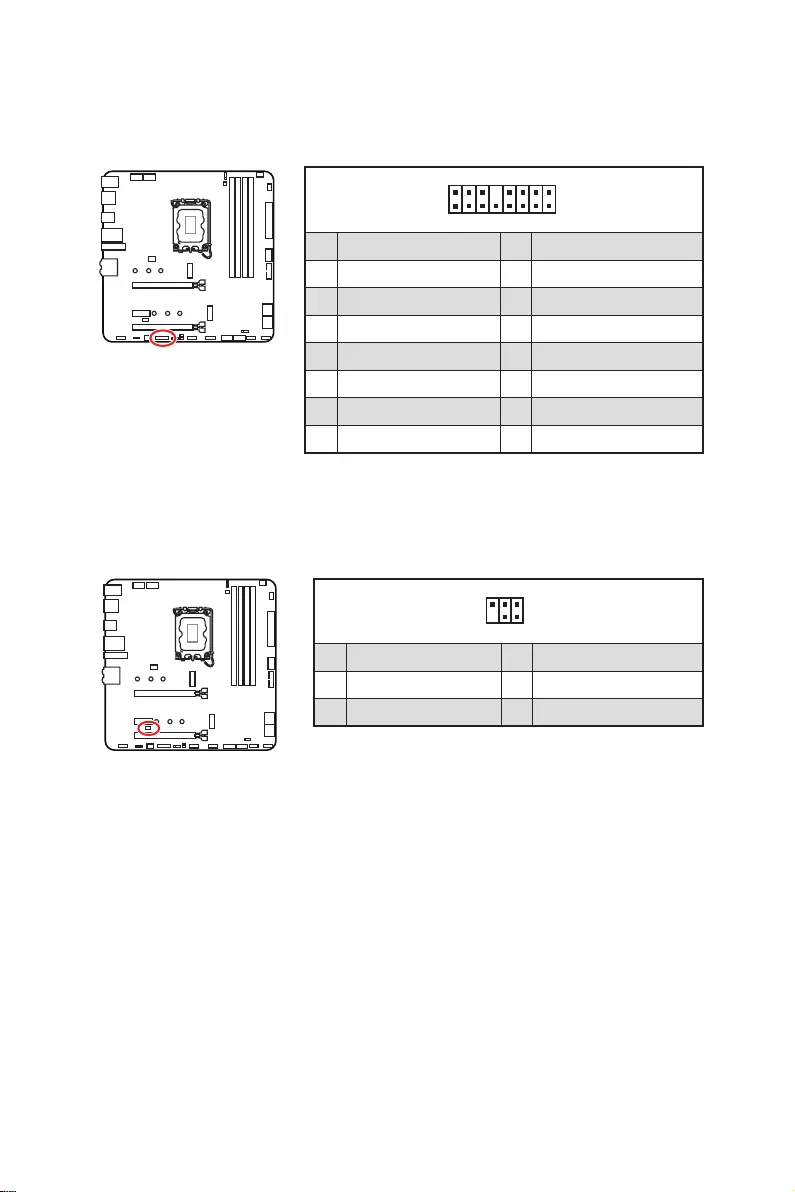
25
Vue d’ensemble des composants
JTBT1 : Connecteur de carte additionnelle Thunderbolt
Ce connecteur vous permet de relier une carte additionnelle Thunderbolt E/S.
1
2 16
15
1 TBT_FORCE_PWR 2 TBT_S0IX_ENTRY_REQ
3 TBT_CIO_PLUG_EVENT# 4 TBT_S0IX_ENTRY_ACK
5 SLP_S3#_TBT 6 TBT_PSON_OVERRIDE_N
7 SLP_S5#_TBT 8 No Pin
9 Ground 10 SMBCLK_VSB
11 DG_PEWAKE# 12 SMBDATA_VSB
13 TBT_RTD3_PWR_EN 14 Ground
15 TBT_CARD_DET_R# 16 PD_IRQ#
JDASH1 : Connecteur du contrôleur de réglages
Ce connecteur est utilisé pour connecter un contrôleur de réglage (selon modèle).
1
2 6
5
1 No Pin 2 NC
3 MCU_SMB_SCL_M 4 MCU_SMB_SDA_M
5 VCC5 6 Ground

26 Vue d’ensemble des composants
24
131
12
ATX_PWR1
1 +3.3V 13 +3.3V
2 +3.3V 14
3 Ground 15 Ground
4 +5V 16
5 Ground 17 Ground
6 +5V 18 Ground
7 Ground 19 Ground
8 PWR OK 20 Res
9 5VSB 21 +5V
10 +12V 22 +5V
11 +12V 23 +5V
12 +3.3V 24 Ground
5
4 1
8CPU_PWR1~2
1 Ground 5 +12V
2 Ground 6 +12V
3 Ground 7 +12V
4 Ground 8 +12V
Important
Veuillez vous assurer que tous les câbles d’alimentation sont branchés aux
connecteurs adéquats afin de garantir une opération stable de la carte mère.
Ces connecteurs vous permettent de relier une alimentation ATX.

27
Vue d’ensemble des composants
JCI1 : Connecteur intrusion châssis
Ce connecteur est relié à un câble d’interrupteur intrusion châssis.
Normal
(défaut) Commencer l’activité
instrusion châssis
1. Reliez le connecteur JCI1 à l’interrupteur ou au capteur d’intrusion châssis situé
sur le boîtier du PC.
2. Fermez le couvercle du boîtier.
3. Allez dans BIOS > SETTINGS (Réglages) > Security (Sécurité) > Chassis Intrusion
Configuration (Configuration d’intrusion châssis).
4. Réglez Chassis Intrusion (Intrusion châssis) sur Enabled (Activé).
5. Appuyez sur F10 pour sauvegarder et quitter. Ensuite appuyez sur la touche Enter
(Entrée) pour choisir Yes (Oui).
6. Désormais, si le boîtier du PC est ouvert quand l’ordinateur est allumé, vous
recevrez un message d’avertissement à l’écran.
Réinitialisation de l’avertissement d’intrusion châssis
1. Allez dans BIOS > SETTINGS (Réglages) > Security (Sécurité) > Chassis Intrusion
Configuration (Configuration d’intrusion châssis).
2. Réglez Chassis Intrusion (Intrusion châssis) sur Reset (Réinitialiser).
3. Appuyez sur F10 pour sauvegarder et quitter. Ensuite appuyez sur la touche Enter
(Entrée) pour choisir Yes (Oui).

28 Vue d’ensemble des composants
Ce connecteur vous permet de relier un port USB 3.2 Gen 1 5 Gb/s sur le panneau
avant.
Important
Notez que les câbles d’alimentation et de terre doivent être branchés correctement
afin d’éviter d’endommager la carte.
1
10 11
20
1 Power 11 USB2.0+
2 USB3_RX_DN 12
3 USB3_RX_DP 13 Ground
4 Ground 14 USB3_TX_C_DP
5 USB3_TX_C_DN 15 USB3_TX_C_DN
6 USB3_TX_C_DP 16 Ground
7 Ground 17 USB3_RX_DP
8 18 USB3_RX_DN
9 USB2.0+ 19 Power
10 Ground 20 No Pin
sur le panneau avant. Pour plus de sécurité, ce connecteur a été conçu pour offrir une
dans le bon sens.
JUSB4
le panneau avant

29
Vue d’ensemble des composants
Ces connecteurs vous permettent de relier des ports USB 2.0 sur le panneau avant.
1
2 10
9
1 VCC 2 VCC
3 4
5 USB0+ 6 USB1+
7 Ground 8 Ground
9 No Pin 10 NC
Important
Notez que les broches VCC et Terre doivent être branchées correctement afin
d’éviter tout dommage sur la carte mère.
Pour recharger votre iPad, iPhone et iPod par l’intermédiaire d’un port USB, veuillez
installer l’utilitaire MSI® Center.
JTPM1 : Connecteur de module TPM
Ce connecteur est relié à un module TPM (Trusted Platform Module). Veuillez vous
référer au manuel du module TPM pour plus d’informations.
1
2 12
11
1 SPI Power 2 SPI Chip Select
3
Master In Slave Out (SPI Data)
4
Master Out Slave In (SPI Data)
5 Reserved 6 SPI Clock
7 Ground 8 SPI Reset
9 Reserved 10 No Pin
11 Reserved 12 Interrupt Request

30 Vue d’ensemble des composants
ventilateur
Les connecteurs de ventilateur peuvent être utilisés en mode PWM (Pulse Width
Modulation) et en mode DC. En mode PWM, les connecteurs fournissent une sortie
de 12 V constante et ajustent la vitesse du ventilateur avec un signal de contrôle de
vitesse. En mode DC, les connecteurs contrôlent la vitesse du ventilateur en modifiant
connecteur de ventilateur en mode PWM ou mode DC.
Basculer entre les modes de ventilateur et ajuster la vitesse
Vous pouvez alterner entre le mode PWM et le mode DC et ajuster la vitesse du
ventilateur dans BIOS > HARDWARE MONITOR.
Choisissez le mode PWM ou le mode DC
Important
Veuillez vous assurer que les ventilateurs fonctionnent correctement après avoir
basculé entre les modes PWM et DC.
Il y a des points de gradient de la vitesse du ventilateur qui
vous permet d’ajuster la vitesse du ventilateur par rapport à la
température du processeur.
Définition des broches des connecteurs de ventilateur
CPU_FAN1
SYS_FAN2
PUMP_FAN1
SYS_FAN1
Connecteur Mode
ventilateur
par défaut
Courant
maximum Puissance
maximum
CPU_FAN1 Mode PWM 2 A 24 W
PUMP_FAN1 Mode PWM 3 A 36 W
SYS_FAN1~2 Mode DC 1 A 12 W
1 Définition des broches en mode PWM
1 Ground 2 +12V
3 Sense 4 Speed Control Signal
1 Définition des broches en mode DC
1 Ground 2 Voltage Control
3 Sense 4 NC

31
Vue d’ensemble des composants
JBAT1 : Cavalier Clear CMOS (Réinitialiser le BIOS)
Une mémoire CMOS est intégrée et est alimentée en externe par une batterie située
sur la carte mère afin de conserver les données de configuration système. Si vous
souhaitez nettoyer la configuration du système, réglez le cavalier pour effacer la
mémoire CMOS.
Conserver
les données
(défaut)
Effacer le CMOS/
Réinitialiser le BIOS
Réinitialiser le BIOS aux valeurs par défaut
1. Éteignez l’ordinateur et débranchez le câble d’alimentation de la prise électrique.
2. Utilisez un couvercle de cavalier pour fermer JBAT1 pendant 5 à 10 secondes.
3. Enlevez le couvercle de cavalier du JBAT1.
4.
EZ Debug LED
Ces LEDs indiquent l’état de débogage de la carte mère.
son initialisation a échoué.
DRAM
détectée ou que son initialisation a échoué.
VGA
son initialisation a échoué.
BOOT
n’est pas détecté ou que son initialisation a
échoué.

32 Vue d’ensemble des composants
Important
Le connecteur JRGB supporte des rubans LED RGB (12 V/G/R/B) de type 5050 d’une
longueur de 2 mètres maximum avec une puissance nominale maximale de 3 A (12 V).
Avant d’installer ou de retirer le ruban LED RGB, veillez à toujours éteindre
l’alimentation et à débrancher le câble d’alimentation de la prise électrique.
Veuillez utiliser un logiciel MSI dédié pour contrôler le ruban d’extension LED.
JRGB1 : Connecteur LED RGB
Le connecteur JRGB vous permet de connecter un ruban LED RGB de type 5050 12 V.
1
GRB
Connecteur JRGB Câble d’extension JRGB
Ruban LED RGB de type 5050, sortie 12 V
1
1 +12V 2 G
3 R 4 B
Connexion du ruban LED RGB
1
1
GRB
Connecteur JRGB
Connecteur de ventilateur système
Connexion du ventilateur LED RGB
Ventilateur LED RGB

33
Vue d’ensemble des composants
1
1
1
D
+5V
Attention
Faites attention à bien connecter le bon type de ruban LED. Le connecteur JRGB et le
connecteur JRAINBOW fournissent des tensions différentes. La connexion d’un ruban
LED 5 V au connecteur JRGB peut endommager le ruban.
Important
Le connecteur JRAINBOW supporte jusqu’à des rubans 75 LEDs WS2812B
adressables individuellement (5 V/Data/Ground) avec une puissance nominale
maximale de 3 A (5 V). Dans le cas d’une luminosité de 20 %, le connecteur supporte
jusqu’à 200 LED.
Avant d’installer ou de retirer le ruban LED RGB, veillez à toujours éteindre
l’alimentation et à débrancher le câble d’alimentation de la prise électrique.
Veuillez utiliser un logiciel MSI dédié pour contrôler le ruban d’extension LED.
JRAINBOW1~2 : Connecteurs LED RGB adressables
Le connecteur JRAINBOW vous permet de connecter un ruban à LED RGB WS2812B
adressable individuellement 5 V.
Connecteur
JRAINBOW
Connecteur JRAINBOW
Connecteur de ventilateur système
Câble d’extension
JRAINBOW Ruban LED RGB WS2812B
adressable individuellement,
sortie 5 V
Connexion du ruban LED RGB adressable
Connexion du ventilateur LED RGB adressable
Ventilateur LED RGB adressable
1
JRAINBOW1
1
JRAINBOW2
1 +5V 2 Data
3 No Pin 4 Ground

34 Installer OS, Pilotes et MSI Center
Installer OS, Pilotes et MSI Center
Veuillez vous référer au site www.msi.com pour télécharger et mettre à jour les
derniers utilitaires et pilotes.
Installer Windows 10/Windows 11
1. Allumez l’ordinateur.
2. Insérez le disque ou la clé USB d’installation de Windows 10/Windows 11 dans
votre ordinateur.
3. Appuyez sur le bouton Redémarrer (Restart) du boîtier de l’ordinateur.
4. Appuyez sur la touche F11
entrer dans le menu de démarrage.
5. Choisissez le disque ou la clé USB d’installation de Windows 10/Windows 11 dans
le menu de démarrage.
6. Appuyez sur n’importe quelle touche lorsqu’apparaît le message [Appuyez sur
n’importe quelle touche pour démarrer du CD ou du DVD] (Press any key to boot
from CD or DVD). Sinon, veuillez ignorer cette étape.
7. Suivez les instructions à l’écran pour installer Windows 10/Windows 11.
Installer les pilotes
1. Allumez l’ordinateur sous Windows 10/Windows 11.
2. Insérez le disque MSI® DVD Drive dans le lecteur optique.
3. Cliquez sur la fenêtre popup Choisir quoi faire avec ce disque (Select to choose
what happens with this disc), puis choisissez Run DVDSetup.exe pour ouvrir
l’outil d’installation. Si vous désactivez la fonction AutoPlay dans le panneau
de configuration Windows, vous pouvez quand même exécuter manuellement
DVDSetup.exe à partir du chemin d’accès depuis la racine de la clé USB MSI.
4. L’outil d’installation trouvera et listera tous les pilotes dont vous avez besoin dans
l’onglet Pilotes/Logiciels (Drivers/Software).
5. Cliquez sur le bouton Installer (Install) dans le coin inférieur droit de la fenêtre.
6. L’installation des pilotes commence. Une fois terminée, il vous sera demandé de
redémarrer.
7. Cliquez sur le bouton OK pour terminer.
8. Redémarrez votre ordinateur.

35
Installer OS, Pilotes et MSI Center
MSI Center
MSI Center est une application qui vous aide à optimiser facilement les paramètres
de jeu et à utiliser les logiciels de création de contenu de manière intuitive. Elle vous
permet également de contrôler et de synchroniser les effets de lumière LED sur les
PC et autres produits MSI. Avec MSI Center, vous pouvez personnaliser les modes
selon vos envies, surveiller les performances du système et régler la vitesse du
ventilateur.
Guide d’utilisation de MSI Center
Si vous souhaitez en savoir plus sur MSI Center, veuillez vous référer
au fichier
http://download.msi.com/manual/mb/MSICENTER.pdf
ou scannez le code QR pour y accéder.
Important
Les fonctions peuvent varier en fonction du produit que vous possédez.

36
Le BIOS UEFI de MSI est compatible avec l’architecture UEFI (Unified Extensible
Firmware Interface). Le BIOS UEFI présente de nombreuses nouvelles fonctionnalités
et avantages qui ne sont pas proposés par le BIOS traditionnel. Le BIOS UEFI est ainsi
voué à totalement remplacer le BIOS traditionnel à l’avenir. Le BIOS UEFI de MSI
utilise UEFI comme mode de démarrage par défaut pour profiter au maximum des
capacités du nouveau chipset.
Important
Dans ce guide d’utilisation, le terme BIOS se réfère au BIOS UEFI, sauf indication
contraire.
enregistrer le processus d’autotest du BIOS. Il élimine également le temps à attendre
pour passer en mode CSM pendant le POST.
Prend en charge des partitions de disque dur supérieures à 2 To.
Prend en charge plus de 4 partitions principales avec une table de partition GUID
(GPT).
Prend en charge un nombre illimité de partitions.
appareils peuvent ne pas fournir de compatibilité descendante.
d’exploitation pour s’assurer qu’aucun malware ne perturbe le processus de
démarrage.
Système d’exploitation Windows 32 bits
système d’exploitation Windows 10/Windows 11 64 bits.
Carte graphique ancienne
message d’avertissement apparaît si aucun support GOP (Graphics Output Protocol)
n’est détecté sur cette carte graphique.
Important
Nous vous recommandons de remplacer votre carte graphique par un modèle
compatible GOP/UEFI ou d’utiliser la puce graphique intégrée à votre processeur pour
profiter d’un fonctionnement normal.
Comment vérifier le mode BIOS ?
1. Allumez votre ordinateur.
2. Pendant le démarrage, lorsqu’apparaît le message Press DEL key to enter Setup
Menu, F11 to enter Boot Menu sur l’écran, veuillez appuyer sur la touche Suppr.
3. Après être entré dans le BIOS, vous pouvez vérifier le Mode BIOS en haut de
l’écran.
BIOS Mode:

37
Configuration du BIOS
Les réglages par défaut fournissent une performance optimale pour la stabilité du
système en conditions normales. Veillez à toujours garder les réglages par défaut
pour éviter d’endommager le système ou tout problème au démarrage, sauf si vous
êtes familier avec le BIOS.
Important
Le BIOS est constamment mis à jour afin d’offrir de meilleures performances
système. Par conséquent, la description peut différer selon la version du BIOS utilisée
et n’est donc donnée qu’à titre de référence. Vous pouvez aussi vous référer à l’onglet
Help (Aide) pour obtenir la description des fonctions du BIOS.
Les écrans, les options et les paramètres du BIOS peuvent varier selon votre
système.
Entrer dans la configuration du BIOS
Pendant le démarrage, lorsqu’apparaît le message Press DEL key to enter Setup
Menu, F11 to enter Boot Menu sur l’écran, veuillez appuyer sur la touche Suppr.
Touches de fonction
F1 : Liste d’aide générale
F2 : Ajouter ou supprimer un élément favori
F3 : Entrer dans le menu Favoris
F4 : Entrer dans le menu caractéristiques du processeur
F5
F6 : Charger les réglages par défaut
F7 : Alterner entre le mode avancé et le mode simplifié
F8 : Charger le profil d’overclocking
F9 : Sauvegarder le profil d’overclocking
F10 : Sauvegarder les modifications et réinitialiser*
F12 : Prendre une capture d’écran et la conserver dans la clé USB (au format FAT/
FAT32 uniquement)
Ctrl+F : Entrer dans la page de recherche
* Lorsque vous appuyez sur F10, une fenêtre de confirmation apparaît et fournit
l’information de modification. Choisissez entre Oui et Non pour confirmer.
Guide d’utilisation du BIOS
Si vous souhaitez en savoir plus sur la configuration du BIOS, veuillez
vous référer au fichier
http://download.msi.com/manual/mb/Intel600BIOSfr.pdf
ou scannez le code QR pour y accéder.

38
Réinitialiser le BIOS
Il se peut que vous ayez besoin de récupérer les réglages BIOS par défaut pour
résoudre des problèmes. Pour réinitialiser les réglages du BIOS, veuillez suivre l’une
des méthodes suivantes :
Allez dans le BIOS et appuyez sur F6 pour charger les réglages par défaut.
Clear CMOS sur la carte mère.
Important
vous référer à la section cavalier Clear CMOS pour en savoir plus sur la réinitialisation
du BIOS.
Mettre le BIOS à jour
Mettre le BIOS à jour avec M-FLASH
Avant la mise à jour :
Veuillez télécharger la dernière version du BIOS compatible à votre carte mère sur le
site MSI. Ensuite, veuillez sauvegarder le profil BIOS sur la clé USB.
Mettre le BIOS à jour :
1. Insérez la clé USB contenant le fichier de mise à jour au port USB.
2. Veuillez vous référer aux méthodes suivantes pour passer en mode flash.
Redémarrez et appuyez sur la touche Ctrl + F5 pendant le processus de POST et
cliquez sur Oui pour redémarrer le système.
Redémarrez et appuyez sur la touche Del pendant le processus de POST pour
entrer dans le BIOS. Cliquez sur le bouton M-FLASH et cliquez sur Oui pour
redémarrer le système.
3. Choisissez un profil BIOS pour commencer la mise à jour du BIOS.
4. Lorsque vous y êtes invité, cliquez sur Oui pour lancer la restauration du BIOS.
5. Une fois la mise à jour terminée, le système redémarrera automatiquement.

39
Mettre le BIOS à jour avec MSI Center
Avant la mise à jour :
correctement connecté à internet.
Veuillez désactiver tous les autres logiciels d’application avant de mettre à jour le
BIOS.
Mettre le BIOS à jour :
1. Installez et lancez MSI Center et accédez à la page Support.
2. Choisissez et cliquez sur le bouton Avancé.
3. Choisissez le profil BIOS et cliquez sur le bouton Installer.
4. Le rappel d’installation apparaît. Cliquez ensuite sur le bouton Installer.
5. Le système redémarrera automatiquement pour la mise à jour du BIOS.
6. Une fois la mise à jour terminée, le système redémarrera automatiquement.


1
............................................................. 3
............................. 4
.................................................................................................. 4
............................................................................. 5
............................................................................................ 12
............................................................. 13
....................................................... 13
.............................................................................. 13
Realtek Audio Console ......................................................................................... 14
..................................................................... 17
........................................................................................... 18
......................................................................................................... 19
................................................................... 20
............................................................ 20
......................................................................... 21
..................................................... 23
............................................................ 23
....................... 24
......................................................... 24
................................................... 25
........................................................... 26
.................................................... 27
................................................................... 27
................................................................................ 28
............................................................................... 28
.................... 29
..................................... 30
...................................................................................... 30
..................................................................................... 31
.................................................... 32
............................................................ 33
................................................................... 33
.......................................................................................... 33
MSI Center ............................................................................................................ 33

2
............................................................................................................. 34
.................................................................................................... 35
........................................................................................ 35
.......................................................................... 35
........................................................................................................... 36
................................................................................................. 36

3

4

5
Intel® Z690 (MAG Z690M MORTAR WIFI)
Intel® B660 (MAG B660M MORTAR WIFI/ MAG B660M
MORTAR)
Controller
/**
/**

6
ASM1061)
M2_2.
RAID
Realtek® ALC1200 Codec

7
LAN
MORTAR WIFI/ MAG
B660M MORTAR
WIFI)
6E
Windows 11.

8
WIFI/ MAG B660M MORTAR WIFI)
NUVOTON NCT6687D
UEFI AMI BIOS
ACPI 6.4, SMBIOS 3.4

9
MSI Center
Intel Extreme Tuning Utility
MSI App Player (BlueStacks)
Open Broadcaster Software (OBS)
Google Chrome™, Google Toolbar, Google Drive
Norton™ Internet Security Solution
Center
Gaming Mode
Smart Priority
Game Highlights
LAN Manager
Mystic Light
Ambient Devices
Frozr AI Cooling
User Scenario
True Color
Live Update
Hardware Monitoring
Super Charger
Speed Up
Smart Image Finder
MSI Companion

10
Audio Boost
LAN Manager
MORTAR WIFI)
Extended Heatsink Design
M.2 Shield Frozr
7W/mK MOSFET thermal pad
Choke thermal pad
Pump Fan
Smart Fan Control
Mystic Light Extension (RGB)
Mystic Light Extension (RAINBOW)
Mystic Light SYNC
Ambient Devices Support
EZ LED Control
EZ DEBUG LED

11
Lightning Gen 4 M.2
Memory Boost
Core Boost
Game Boost
Lightning USB 20G
USB 3.2 Gen 2 10G
Dual CPU Power
2oz Copper thickened PCB
MSI Center
EZ M.2 Clip
Click BIOS 5
MAG B660M MORTAR)
Forzr AI Cooling
App player
MORTAR WIFI)

12
MAG Z690M
MORTAR WIFI MAG B660M
MORTAR WIFI MAG B660M
MORTAR
1 1 1
1 1 1
1 1 1
1 1
1 1 1
2 2 2
1 1 1
1 1 1
1 1

13
2468
(
DisplayPort
USB 3.2 Gen 2
USB 3.2 Gen 2x2

14
Realtek Audio Console

15
AUDIO INPUT
AUDIO INPUT
Rear Front
Side Center/
Subwoofer

16
1.
2.
1
2

17
BAT1
JTPM1
JRGB1
M2_2
M2_1
SYS_FAN1
JFP2
JFP1
JBAT1
JRAINBOW2
JUSB2
JCI1
PUMP_FAN1
PCI_E1
PCI_E2
JDASH1
PCI_E3
JTBT1
CPU_PWR1 JSMB1
JRAINBOW1
CPU_PWR2
CPU_FAN1
JUSB4
JUSB3
JAUD1
JUSB1
SYS_FAN2 SATA7
SATA8
ATX_PWR1
DIMMB1
DIMMB2
DIMMA1
DIMMA2

18

19
DIMMA2.
DRAM Frequency
DIMMA1 DIMMB1
DIMMA2 DIMMB2
DIMMA2 DIMMA2
DIMMB2
DIMMA1
DIMMA2
DIMMB1
DIMMB2

20
BAT1
PCI_E1
PCI_E2
PCI_E3: P
MSI Graphics Card Bolster
PCI_E1.
1
2 10
9
+
+
+
+
Power LED
HDD LED Reset Switch
Reserved
Power Switch
JFP1
1 HDD LED + 2 Power LED +
3 4
5 Reset Switch 6 Power Switch
7 Reset Switch 8 Power Switch
9 Reserved 10 No Pin
1
JFP2
+
+
Speaker
Buzzer
1 2 Buzzer +
3 4 Speaker +

21
M2_1
M2_2
Optane™.
1.
2.
2
2
1
1
1
1
M2_2
M2_1

22
3.
4.
5.
30º30º
5
4
3
6.
6
6
6
6

23
SATA5~8 & SATA_A~B:
SATA_A
SATA5
SATA7
SATA_B
SATA6
SATA8
1
2 10
9
1 MIC L 2 Ground
3 MIC R 4 NC
5 Head Phone R 6 MIC Detection
7 SENSE_SEND 8 No Pin
9 Head Phone L 10 Head Phone Detection

24
Thunderbolt.
1
2 16
15
1 TBT_FORCE_PWR 2 TBT_S0IX_ENTRY_REQ
3 TBT_CIO_PLUG_EVENT# 4 TBT_S0IX_ENTRY_ACK
5 SLP_S3#_TBT 6 TBT_PSON_OVERRIDE_N
7 SLP_S5#_TBT 8 No Pin
9 Ground 10 SMBCLK_VSB
11 DG_PEWAKE# 12 SMBDATA_VSB
13 TBT_RTD3_PWR_EN 14 Ground
15 TBT_CARD_DET_R# 16 PD_IRQ#
1
2 6
5
1 No Pin 2 NC
3 MCU_SMB_SCL_M 4 MCU_SMB_SDA_M
5 VCC5 6 Ground

25
24
131
12
ATX_PWR1
1 +3.3V 13 +3.3V
2 +3.3V 14
3 Ground 15 Ground
4 +5V 16
5 Ground 17 Ground
6 +5V 18 Ground
7 Ground 19 Ground
8 PWR OK 20 Res
9 5VSB 21 +5V
10 +12V 22 +5V
11 +12V 23 +5V
12 +3.3V 24 Ground
5
4 1
8CPU_PWR1~2
1 Ground 5 +12V
2 Ground 6 +12V
3 Ground 7 +12V
4 Ground 8 +12V

26
1. JCI1.
2.
3. BIOS > SETTINGS > Security > Chassis Intrusion Configuration.
4. Chassis IntrusionEnabled.
5. F10
EnterYes.
6.
1. BIOS > SETTINGS > Security > Chassis Intrusion Configuration.
2. Chassis Intrusion, Reset.
3. F10
EnterYes.

27
1
10 11
20
1 Power 11 USB2.0+
2 USB3_RX_DN 12
3 USB3_RX_DP 13 Ground
4 Ground 14 USB3_TX_C_DP
5 USB3_TX_C_DN 15 USB3_TX_C_DN
6 USB3_TX_C_DP 16 Ground
7 Ground 17 USB3_RX_DP
8 18 USB3_RX_DN
9 USB2.0+ 19 Power
10 Ground 20 No Pin
JUSB4

28
1
2 10
9
1 VCC 2 VCC
3 4
5 USB0+ 6 USB1+
7 Ground 8 Ground
9 No Pin 10 NC
1
2 12
11
1 SPI Power 2 SPI Chip Select
3
Master In Slave Out (SPI Data)
4
Master Out Slave In (SPI Data)
5 Reserved 6 SPI Clock
7 Ground 8 SPI Reset
9 Reserved 10 No Pin
11 Reserved 12 Interrupt Request

29
BIOS > HARDWARE MONITOR
PWMDC
CPU_FAN1
SYS_FAN2
PUMP_FAN1
SYS_FAN1
CPU_FAN1
PUMP_FAN1
SYS_FAN1~2
1
1 Ground 2 +12V
3 Sense 4 Speed Control Signal
1
1 Ground 2 Voltage Control
3 Sense 4 NC

30
1.
2. JBAT1
3. JBAT1.
4.
DRAM
VGA
BOOT
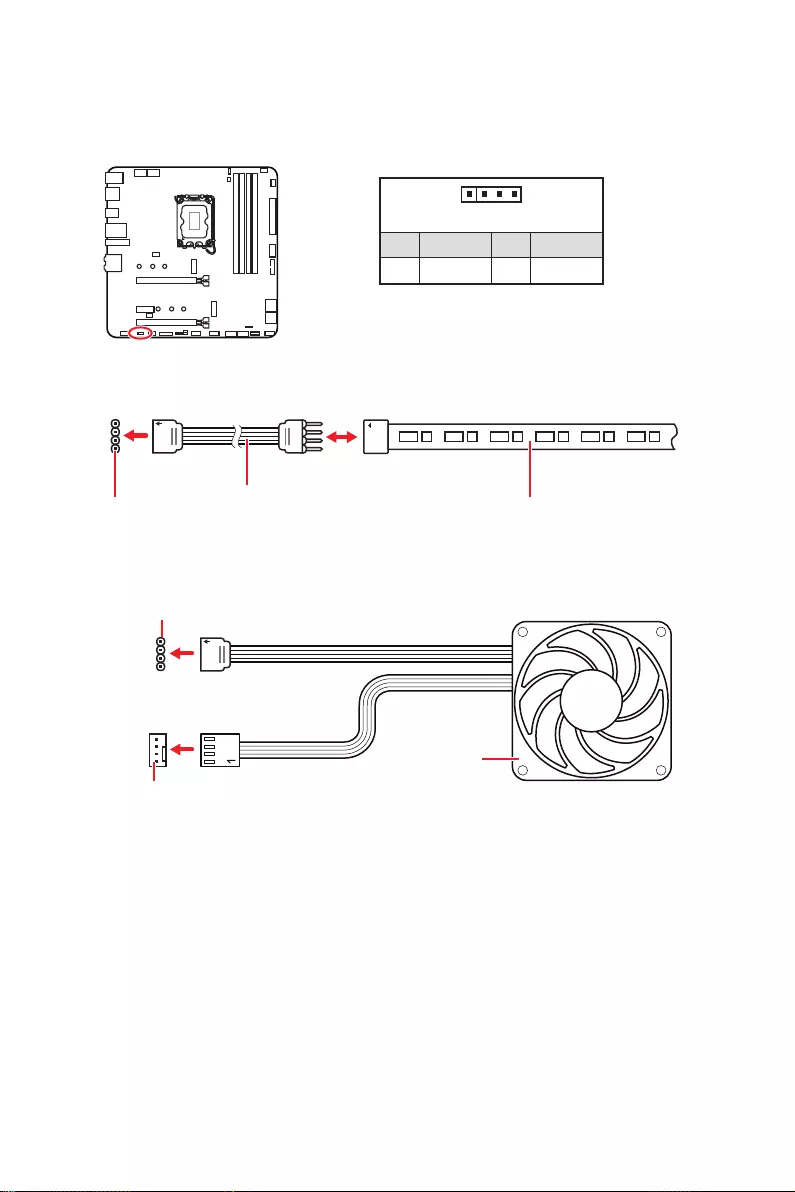
31
1
GRB
1
1 +12V 2 G
3 R 4 B
1
1
GRB

32
1
1
1
D
+5V
JRAINBOW
1
JRAINBOW1
1
JRAINBOW2
1 +5V 2 Data
3 No Pin 4 Ground

33
1.
2.
3. Restart
4. F11
5.
6. Press any
key to boot from CD or DVD...
7.
1.
2.
3. Select to choose what happens with this disc
Run DVDSetup.exe
DVDSetup.exe
4.
Drivers/Software.
5. Install
6.
7. OK
8.
MSI Center
http://download.msi.com/manual/mb/MSICENTER.pdf

34
There is
no GOP (Graphics Output protocol) support detected in this graphics card
1.
2. DeletePress DEL
key to enter Setup Menu, F11 to enter Boot Menu
3.

35
HELP.
DeletePress DEL key to
enter Setup Menu, F11 to enter Boot Menu
F1
F2
F3
F4
F5
F6
F7
F8
F9
F10
F12
Ctrl+F
http://download.msi.com/manual/mb/Intel600BIOSru.pdf

36
F6
.
1.
2.
Ctrl+F5
Yes
Del
M-FLASH
Yes
3.
4. Yes
BIOS.
5.

37
1. Support.
2. Advance.
3. Install.
4. Install.
5.
6.


1
........................................................................................... 3
................................................................................ 4
............................................................................................ 4
........................................................................................................................ 5
................................................................................................. 12
....................................................................................................... 13
........................................................................................... 13
......................................................................................... 13
................................................................................ 14
.......................................................................................... 17
........................................................................................................... 18
........................................................................................................ 19
................................................................................. 20
................................................................. 20
................................................................................ 21
................................................... 23
................................................................... 23
........................................................... 24
................................................. 24
......................................................... 25
..................................................................... 26
............................................... 27
.............................................................. 27
............................................................................... 28
........................................................................ 28
................................. 29
........................................................ 30
EZ Debug LED ....................................................................................................... 30
................................................................................. 31
......................................................... 32
................................................. 33
.............................................................. 33
....................................................................................... 33
MSI Center ............................................................................................................ 33

2
............................................................................................................. 34
........................................................................................................... 35
................................................................................. 35
........................................................................................... 35
...................................................................................................... 36
........................................................................................ 36

3

4

5
B660M MORTAR)

6
RAID
LAN

7
Bluetooth®
(MAG Z690M
MORTAR WIFI/ MAG
B660M MORTAR
EZ Debug LED x4

8
DisplayPort x1
9.6 in. x 9.6 in. (24.4 cm x 24.4 cm)
UEFI AMI BIOS
ACPI 6.4, SMBIOS 3.4
MSI Center
Intel Extreme Tuning Utility
MSI App Player (BlueStacks)
Open Broadcaster Software (OBS)
Google Chrome™, Google Toolbar, Google Drive
Norton™ Internet Security Solution

9
Gaming Mode
Smart Priority
Game Highlights
LAN Manager
Mystic Light
Ambient Devices
Frozr AI Cooling
User Scenario
True Color
Live Update
Hardware Monitoring
Super Charger
Speed Up
Smart Image Finder
MSI Companion

10
Audio Boost
2.5G LAN
LAN Manager
Intel WiFi (MAG Z690M MORTAR WIFI/ MAG B660M
M.2 Shield Frozr
LED
Mystic Light SYNC
EZ DEBUG LED

11
Lightning Gen 4 M.2
Memory Boost
Core Boost
Game Boost
Lightning USB 20G
USB 3.2 Gen 2 10G
MSI Center
Click BIOS 5
App player
Tile (MAG Z690M MORTAR WIFI/ MAG B660M MORTAR

12
MAG Z690M
MORTAR WIFI MAG B660M
MORTAR WIFI MAG B660M
MORTAR
111
111
111
1 1
111
222
111
111
1 1

13
2468
Off
Off 10 Mbps
100/1000 Mbps
2.5 Gbps
2.5 Gbps LAN
DisplayPort
USB 3.2 Gen 2
USB 3.2 Gen 2x2

14

15
AUDIO INPUT
AUDIO INPUT
Rear Front
Side Center/
Subwoofer

16
1.
2.
1
2

17
BAT1
JTPM1
JRGB1
M2_2
M2_1
SYS_FAN1
JFP2
JFP1
JBAT1
JRAINBOW2
JUSB2
JCI1
PUMP_FAN1
PCI_E1
PCI_E2
JDASH1
PCI_E3
JTBT1
CPU_PWR1 JSMB1
JRAINBOW1
CPU_PWR2
CPU_FAN1
JUSB4
JUSB3
JAUD1
JUSB1
SYS_FAN2 SATA7
SATA8
ATX_PWR1
DIMMB1
DIMMB2
DIMMA1
DIMMA2

18
52.76 mm

19
DIMMA2
DRAM Frequency
DIMMA1 DIMMB1
DIMMA2 DIMMB2
DIMMA2 DIMMA2
DIMMB2
DIMMA1
DIMMA2
DIMMB1
DIMMB2

20
BAT1
PCI_E1
PCI_E2
PCI_E3: P
MSI Graphics Card Bolster
PCI_E1
1
2 10
9
+
+
+
+
Power LED
HDD LED Reset Switch
Reserved
Power Switch
JFP1
1 HDD LED + 2 Power LED +
3 4
5 Reset Switch 6 Power Switch
7 Reset Switch 8 Power Switch
9 Reserved 10 No Pin
1
JFP2
+
+
Speaker
Buzzer
1 2 Buzzer +
3 4 Speaker +

21
M2_1
M2_2
1.
2.
2
2
1
1
1
1
M2_2
M2_1

22
3.
4.
5.
30º30º
5
4
3
6.
6
6
6
6

23
SATA5~8 & SATA_A~B:
SATA_A
SATA5
SATA7
SATA_B
SATA6
SATA8
1
2 10
9
1 MIC L 2 Ground
3 MIC R 4 NC
5 Head Phone R 6 MIC Detection
7 SENSE_SEND 8 No Pin
9 Head Phone L 10 Head Phone Detection
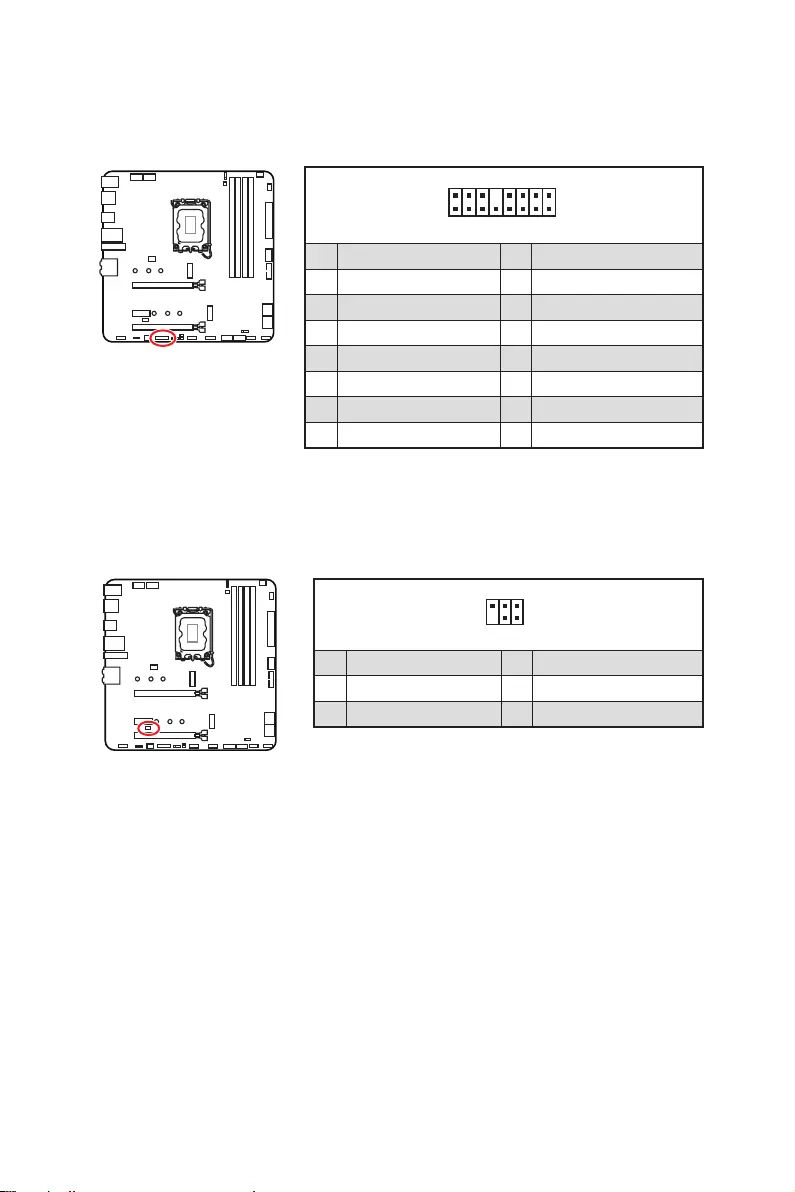
24
1
2 16
15
1 TBT_FORCE_PWR 2 TBT_S0IX_ENTRY_REQ
3 TBT_CIO_PLUG_EVENT# 4 TBT_S0IX_ENTRY_ACK
5 SLP_S3#_TBT 6 TBT_PSON_OVERRIDE_N
7 SLP_S5#_TBT 8 No Pin
9 Ground 10 SMBCLK_VSB
11 DG_PEWAKE# 12 SMBDATA_VSB
13 TBT_RTD3_PWR_EN 14 Ground
15 TBT_CARD_DET_R# 16 PD_IRQ#
1
2 6
5
1 No Pin 2 NC
3 MCU_SMB_SCL_M 4 MCU_SMB_SDA_M
5 VCC5 6 Ground

25
24
131
12
ATX_PWR1
1 +3.3V 13 +3.3V
2 +3.3V 14
3 Ground 15 Ground
4 +5V 16
5 Ground 17 Ground
6 +5V 18 Ground
7 Ground 19 Ground
8 PWR OK 20 Res
9 5VSB 21 +5V
10 +12V 22 +5V
11 +12V 23 +5V
12 +3.3V 24 Ground
5
4 1
8CPU_PWR1~2
1 Ground 5 +12V
2 Ground 6 +12V
3 Ground 7 +12V
4 Ground 8 +12V

26
1. JCI1
2.
3. BIOS > SETTINGS > Security > Chassis Intrusion Configuration
4. Chassis IntrusionEnabled
5. F10Enter
Yes
6.
1. BIOS > SETTINGS > Security > Chassis Intrusion Configuration
2. Chassis IntrusionReset
3. F10Enter
Yes

27
1
10 11
20
1 Power 11 USB2.0+
2 USB3_RX_DN 12
3 USB3_RX_DP 13 Ground
4 Ground 14 USB3_TX_C_DP
5 USB3_TX_C_DN 15 USB3_TX_C_DN
6 USB3_TX_C_DP 16 Ground
7 Ground 17 USB3_RX_DP
8 18 USB3_RX_DN
9 USB2.0+ 19 Power
10 Ground 20 No Pin
JUSB4

28
1
2 10
9
1 VCC 2 VCC
3 4
5 USB0+ 6 USB1+
7 Ground 8 Ground
9 No Pin 10 NC
1
2 12
11
1 SPI Power 2 SPI Chip Select
3
Master In Slave Out (SPI Data)
4
Master Out Slave In (SPI Data)
5 Reserved 6 SPI Clock
7 Ground 8 SPI Reset
9 Reserved 10 No Pin
11 Reserved 12 Interrupt Request

29
BIOS > HARDWARE MONITOR
PWM/DC
CPU_FAN1
SYS_FAN2
PUMP_FAN1
SYS_FAN1
CPU_FAN1 2A 24W
PUMP_FAN1 3A 36W
SYS_FAN1~2 1A 12W
1
1 Ground 2 +12V
3 Sense 4 Speed Control Signal
1
1 Ground 2 Voltage Control
3 Sense 4 NC

30
1.
2. JBAT1
3. JBAT1
4.
EZ Debug LED
DRAM
VGA
BOOT

31
1
GRB
1
1 +12V 2 G
3 R 4 B
1
1
GRB

32
1
1
1
D
+5V
1
JRAINBOW1
1
JRAINBOW2
1 +5V 2 Data
3 No Pin 4 Ground

33
1.
2.
3. Restart
4. F11
5.
6. Press any key to boot from CD or DVD...
7.
1.
2.
3.
Run DVDSetup.exe
DVDSetup.exe
4.
5. Install
6.
7. OK
8.
MSI Center
http://download.msi.com/manual/mb/MSICENTER.pdf

34
1.
2. Press DEL key to enter Setup Menu, F11 to enter Boot Menu
Delete
3.
BIOS Mode:

35
HELP
Press DEL key to enter Setup Menu, F11 to enter Boot Menu
Delete
F1
F2
F3
F4
F5
F6
F7
F8
F9
F10
F12
Ctrl+F
http://download.msi.com/manual/mb/Intel600BIOSjp.pdf

36
F6
1.
2.
Ctrl + F5 Yes
DeleteM-FLASH
Yes
3.
4. Yes
5.

37
1. Support
2. Advanced
3. Install
4.
5.
6.


1
.......................................................................................................3
............................................................................................ 4
.......................................................................................................... 4
..............................................................................................................5
..................................................................................................12
...............................................................................................13
........................................................................................ 13
............................................................................................. 13
............................................................................................... 14
..................................................................................................17
............................................................................................................... 18
............................................................................................................. 19
..................................................................................... 20
................................................................................ 20
..................................................................................... 21
......................................................... 23
.................................................................................... 23
.......................................................................... 24
.............................................................................. 24
............................................................... 25
........................................................................................... 26
..................................................... 27
.................................................................... 27
..................................................................................... 28
....................................................................................... 28
............................................. 29
............................................................... 30
....................................................................................................... 30
....................................................................................... 31
............................................... 32
................................................................33
....................................................................... 33
.................................................................................................. 33
................................................................................................................ 33

2
..................................................................................................34
.............................................................................................. 35
............................................................................................................... 35
................................................................................................ 35
............................................................................................................... 36
........................................................................................................ 36

3

4

5
MORTAR)

6
ASM1061)
RAID
LAN

7
®
(MAG Z690M
MORTAR WIFI/ MAG
B660M MORTAR

8
9.6 in. x 9.6 in. (24.4 cm x 24.4 cm)
1x 256 Mb flash
UEFI AMI BIOS
ACPI 6.4, SMBIOS 3.4
MSI App Player (BlueStacks)
Open Broadcaster Software (OBS)

9
True Color

10
2.5G LAN
LED

11
USB 3.2 Gen 2 10G
USB Type A+C
2oz Copper thickened PCB
App Player

12
MAG Z690M
MORTAR WIFI MAG B660M
MORTAR WIFI MAG B660M
MORTAR
111
111
SATA 6Gb/s
111
1 1
111
222
111
111
1 1

13
2468
2.5 Gbps LAN
USB 3.2 Gen 2
USB 3.2 Gen 2x2

14
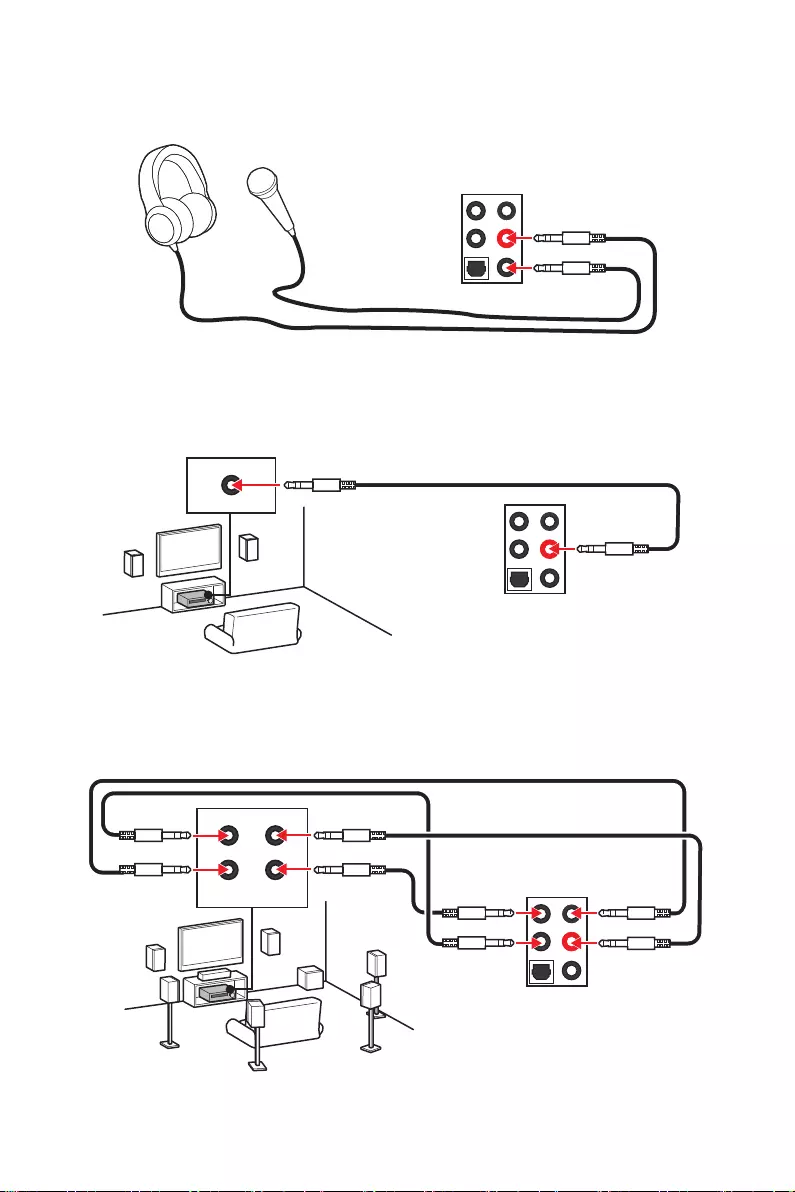
15
AUDIO INPUT
AUDIO INPUT
Rear Front
Side Center/
Subwoofer

16
1.
2.
1
2

17
BAT1
JTPM1
JRGB1
M2_2
M2_1
SYS_FAN1
JFP2
JFP1
JBAT1
JRAINBOW2
JUSB2
JCI1
PUMP_FAN1
PCI_E1
PCI_E2
JDASH1
PCI_E3
JTBT1
CPU_PWR1 JSMB1
JRAINBOW1
CPU_PWR2
CPU_FAN1
JUSB4
JUSB3
JAUD1
JUSB1
SYS_FAN2 SATA7
SATA8
ATX_PWR1
DIMMB1
DIMMB2
DIMMA1
DIMMA2

18
52.76 mm

19
DIMMA2
DRAM Frequency
DIMMA1 DIMMB1
DIMMA2 DIMMB2
DIMMA2 DIMMA2
DIMMB2
DIMMA1
DIMMA2
DIMMB1
DIMMB2
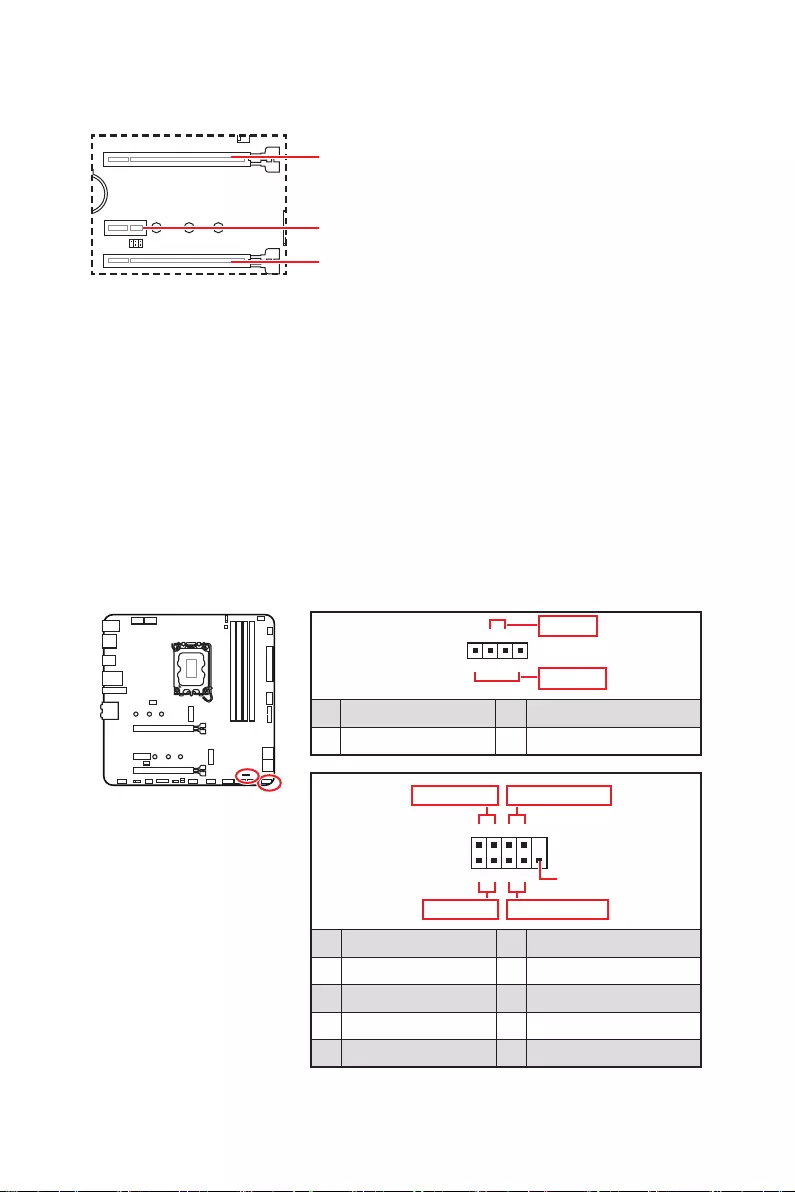
20
BAT1
PCI_E1: PCIe 4.0 x16 (CPU)
PCI_E2
PCI_E3: P
PCI_E1
1
2 10
9
+
+
+
+
HDD LED
Reserved
JFP1
1 HDD LED + 2 Power LED +
3 4
5 Reset Switch 6 Power Switch
7 Reset Switch 8 Power Switch
9 Reserved 10 No Pin
1
JFP2
+
+
Speaker
Buzzer
1 2 Buzzer +
3 4 Speaker +
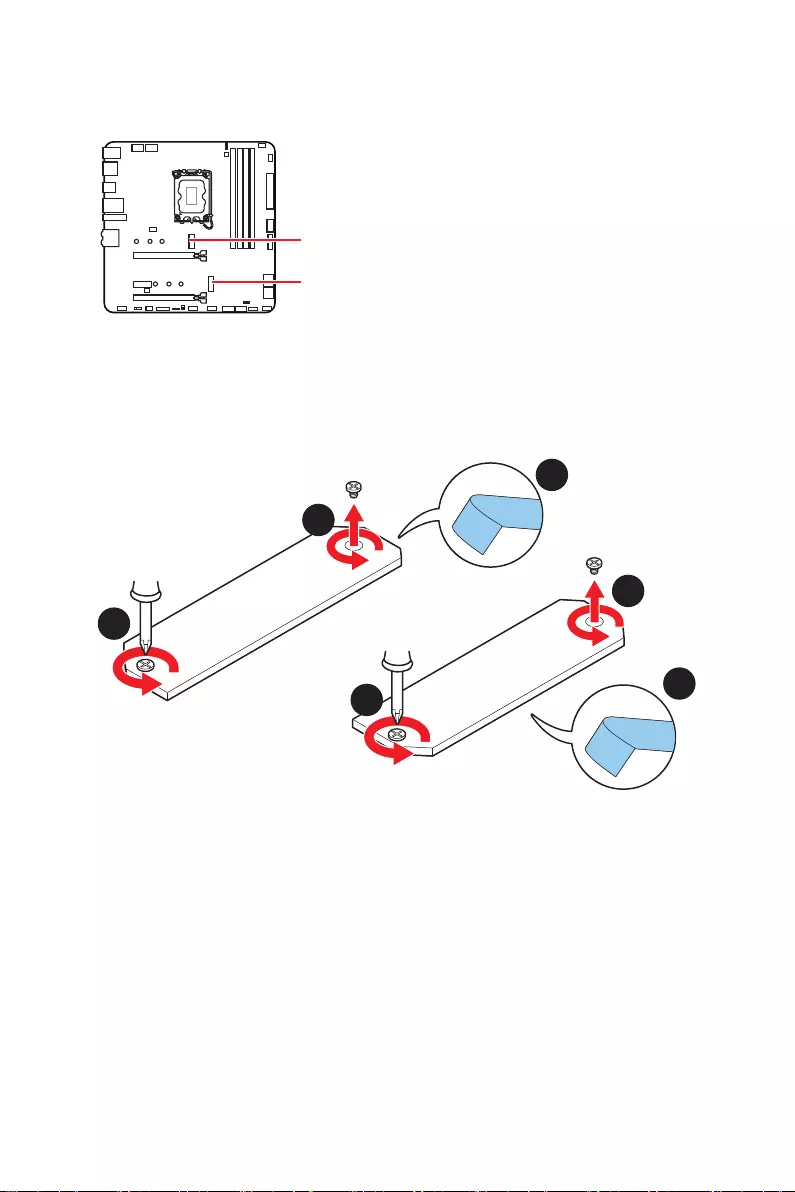
21
M2_1
M2_2
1.
2.
2
2
1
1
1
1
M2_2
M2_1

22
3.
4.
5.
30º30º
5
4
3
6.
6
6
6
6

23
SATA5~8 & SATA_A~B:
SATA_A
SATA5
SATA7
SATA_B
SATA6
SATA8
1
2 10
9
1 MIC L 2 Ground
3 MIC R 4 NC
5 Head Phone R 6 MIC Detection
7 SENSE_SEND 8 No Pin
9 Head Phone L 10 Head Phone Detection

24
1
2 16
15
1 TBT_FORCE_PWR 2 TBT_S0IX_ENTRY_REQ
3 TBT_CIO_PLUG_EVENT# 4 TBT_S0IX_ENTRY_ACK
5 SLP_S3#_TBT 6 TBT_PSON_OVERRIDE_N
7 SLP_S5#_TBT 8 No Pin
9 Ground 10 SMBCLK_VSB
11 DG_PEWAKE# 12 SMBDATA_VSB
13 TBT_RTD3_PWR_EN 14 Ground
15 TBT_CARD_DET_R# 16 PD_IRQ#
1
2 6
5
1 No Pin 2 NC
3 MCU_SMB_SCL_M 4 MCU_SMB_SDA_M
5 VCC5 6 Ground

25
24
131
12
ATX_PWR1
1 +3.3V 13 +3.3V
2 +3.3V 14
3 Ground 15 Ground
4 +5V 16
5 Ground 17 Ground
6 +5V 18 Ground
7 Ground 19 Ground
8 PWR OK 20 Res
9 5VSB 21 +5V
10 +12V 22 +5V
11 +12V 23 +5V
12 +3.3V 24 Ground
5
4 1
8CPU_PWR1~2
1 Ground 5 +12V
2 Ground 6 +12V
3 Ground 7 +12V
4 Ground 8 +12V

26
1. JCI1
2.
3. BIOS > SETTINGS > Security > Chassis Intrusion Configuration
4.
5. F10EnterYes
6.
1. BIOS > SETTINGS > Security > Chassis Intrusion Configuration
2.
3. F10 EnterYes

27
1
10 11
20
1 Power 11 USB2.0+
2 USB3_RX_DN 12
3 USB3_RX_DP 13 Ground
4 Ground 14 USB3_TX_C_DP
5 USB3_TX_C_DN 15 USB3_TX_C_DN
6 USB3_TX_C_DP 16 Ground
7 Ground 17 USB3_RX_DP
8 18 USB3_RX_DN
9 USB2.0+ 19 Power
10 Ground 20 No Pin
JUSB4

28
1
2 10
9
1 VCC 2 VCC
3 4
5 USB0+ 6 USB1+
7 Ground 8 Ground
9 No Pin 10 NC
1
2 12
11
1 SPI Power 2 SPI Chip Select
3
Master In Slave Out (SPI Data)
4
Master Out Slave In (SPI Data)
5 Reserved 6 SPI Clock
7 Ground 8 SPI Reset
9 Reserved 10 No Pin
11 Reserved 12 Interrupt Request

29
PWMDC
CPU_FAN1
SYS_FAN2
PUMP_FAN1
SYS_FAN1
CPU_FAN1 2A 24W
PUMP_FAN1 3A 36W
SYS_FAN1~2 1A 12W
1
1 Ground 2 +12V
3 Sense 4 Speed Control Signal
1
1 Ground 2 Voltage Control
3 Sense 4 NC

30
1.
2. JBAT1
3. JBAT1
4.
DRAM
VGA
BOOT

31
1
GRB
1
1 +12V 2 G
3 R 4 B
1
1
GRB
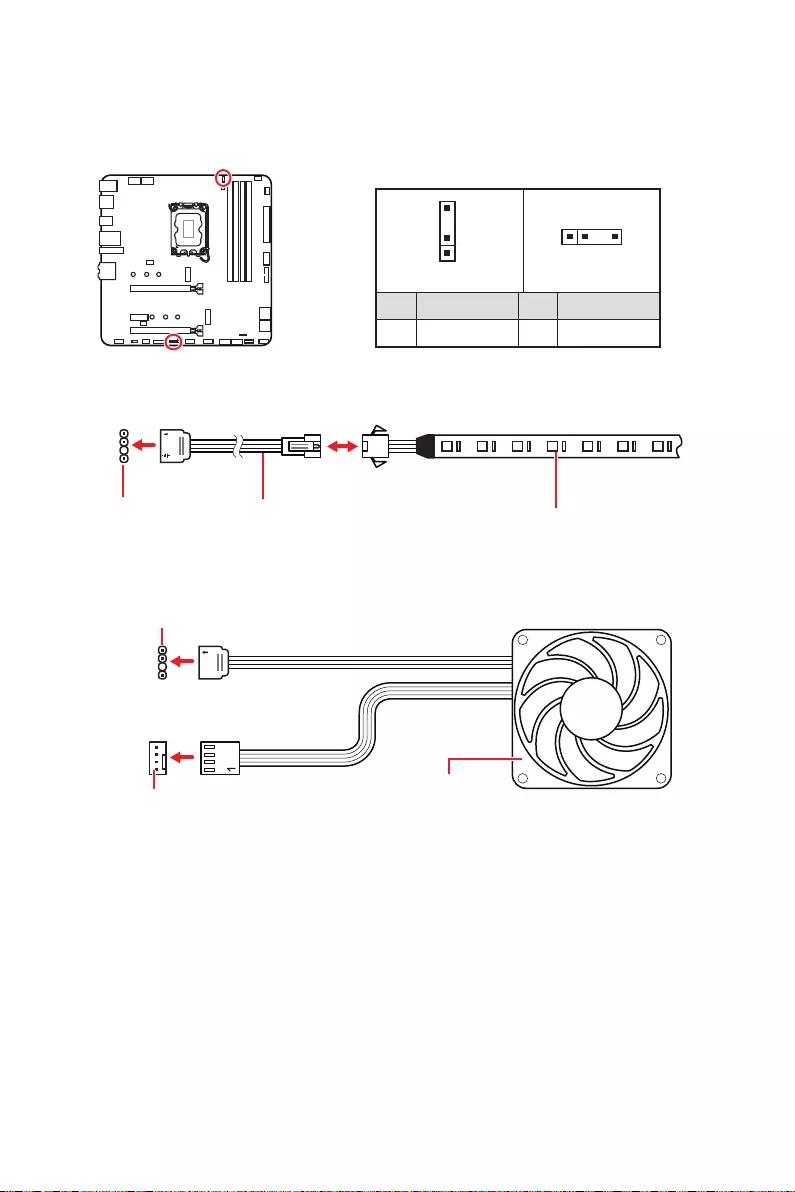
32
1
1
1
D
+5V
JRAINBOW
1
JRAINBOW1
1
JRAINBOW2
1 +5V 2 Data
3 No Pin 4 Ground

33
1.
2.
3. Restart
4. F11
5.
6. Press any key to boot from CD or DVD...
7.
1.
2.
3. Select to choose what happens with this disc Run
DVDSetup.exe
DVDSetup.exe
4. Drivers/Software
5. Install
6.
7. OK
8.
http://download.msi.com/manual/mb/MSICENTER.pdf

34
1.
2. DEL
Delete
3.

35
Delete
F1
F2
F3
F4
F5
F6
F7
F8
F9
F10
F12
Ctrl+F
http://download.msi.com/manual/mb/Intel600BIOSkr.pdf

36
1.
2.
Ctrl + F5Yes
DelM-FLASH
3.
4. Yes
5.

37
1. Support
2. Advance
3. Install
4.
5.
6.


1
................................................................................................................. 3
............................................................................................... 4
................................................................................................... 4
........................................................................................................................ 5
............................................................................................................... 12
................................................................................................................ 13
.................................................................................... 13
.................................................................................................... 13
.............................................................................................. 14
............................................................................................................... 17
............................................................................................................... 18
............................................................................................................ 19
..................................................................................... 20
.................................................................................... 20
...................................................................................... 21
............................................................ 23
........................................................................................... 23
.......................................................................... 24
..................................................................................... 24
.................................................................. 25
............................................................................................... 26
........................................................ 27
....................................................................... 27
........................................................................................ 28
.......................................................................................... 28
...................................... 29
............................................................ 30
................................................................................................... 30
.......................................................................................... 31
................................................................. 32
............................................................... 33
............................................................................. 33
........................................................................................................ 33
MSI Center ............................................................................................................ 33

2
............................................................................................................. 34
.............................................................................................................. 35
...................................................................................................... 35
................................................................................................... 35
.............................................................................................................. 36
.............................................................................................................. 36

3

4

5
MORTAR)
60Hz */**
4K 60Hz*/**

6
ASM1061)
RAID
10*

7
Bluetooth®
MORTAR WIFI/ MAG
B660M MORTAR
WIFI)

8
B660M MORTAR WIFI)
UEFI AMI BIOS
MSI Center
Intel Extreme Tuning Utility
MSI App Player (BlueStacks)
Open Broadcaster Software (OBS)
Norton™ Internet Security Solution

9
Gaming Mode
Smart Priority
Game Highlights
Mystic Light
Ambient Devices
Frozr AI Cooling
User Scenario
True Color
Live Update
Super Charger
Speed Up
Smart Image Finder
MSI Companion

10
MORTAR WIFI)
M.2 Shield Frozr
Ambient Devices Support

11
Lightning Gen 4 M.2
Memory Boost
Lightning USB 20G
USB 3.2 Gen 2 10G
MSI Center
MAG B660M MORTAR)
Frozr AI Cooling
App player
MORTAR WIFI)

12
MAG Z690M
MORTAR WIFI MAG B660M
MORTAR WIFI MAG B660M
MORTAR
111
111
111
1 1
111
222
111
111
1 1

13
DisplayPort
USB 3.2 Gen 2
USB 3.2 Gen 2x2
2468

14

15
AUDIO INPUT
AUDIO INPUT
Rear Front
Side Center/
Subwoofer

16
1.
2.
1
2

17
BAT1
JTPM1
JRGB1
M2_2
M2_1
SYS_FAN1
JFP2
JFP1
JBAT1
JRAINBOW2
JUSB2
JCI1
PUMP_FAN1
PCI_E1
PCI_E2
JDASH1
PCI_E3
JTBT1
CPU_PWR1 JSMB1
JRAINBOW1
CPU_PWR2
CPU_FAN1
JUSB4
JUSB3
JAUD1
JUSB1
SYS_FAN2 SATA7
SATA8
ATX_PWR1
DIMMB1
DIMMB2
DIMMA1
DIMMA2

18
52.76 mm

19
DIMMA2
DRAM Frequency
DIMMA1 DIMMB1
DIMMA2 DIMMB2
DIMMA2 DIMMA2
DIMMB2
DIMMA1
DIMMA2
DIMMB1
DIMMB2
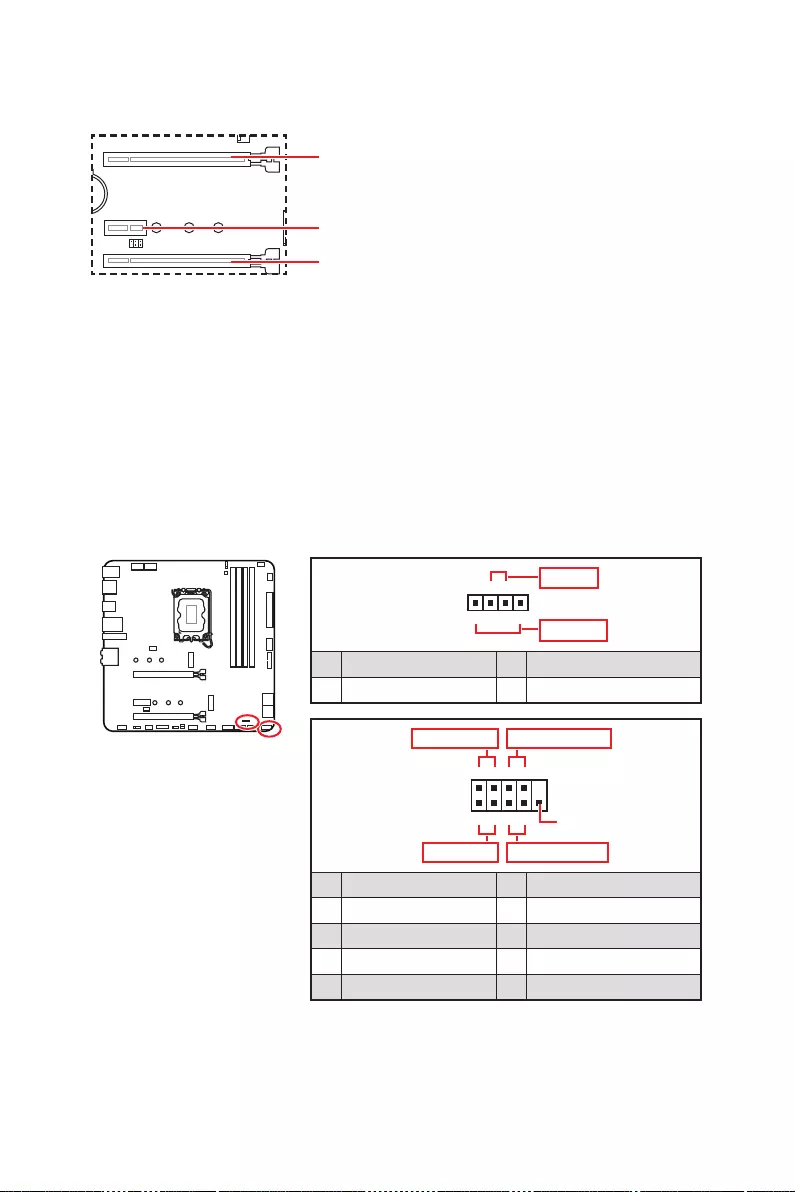
20
BAT1
PCI_E1
PCI_E2
PCI_E3
PCI_E1
1
2 10
9
+
+
+
+
Power LED
HDD LED Reset Switch
Reserved
Power Switch
JFP1
1 HDD LED + 2 Power LED +
3 4
5 Reset Switch 6 Power Switch
7 Reset Switch 8 Power Switch
9 Reserved 10 No Pin
1
JFP2
+
+
Speaker
Buzzer
1 2 Buzzer +
3 4 Speaker +

21
M2_1
M2_2
1.
2.
2
2
1
1
1
1
M2_2
M2_1

22
3.
4.
5.
30º30º
5
4
3
6.
6
6
6
6

23
SATA5~8 & SATA_A~B:
SATA_A
SATA5
SATA7
SATA_B
SATA6
SATA8
1
2 10
9
1 MIC L 2 Ground
3 MIC R 4 NC
5 Head Phone R 6 MIC Detection
7 SENSE_SEND 8 No Pin
9 Head Phone L 10 Head Phone Detection

24
1
2 16
15
1 TBT_FORCE_PWR 2 TBT_S0IX_ENTRY_REQ
3 TBT_CIO_PLUG_EVENT# 4 TBT_S0IX_ENTRY_ACK
5 SLP_S3#_TBT 6 TBT_PSON_OVERRIDE_N
7 SLP_S5#_TBT 8 No Pin
9 Ground 10 SMBCLK_VSB
11 DG_PEWAKE# 12 SMBDATA_VSB
13 TBT_RTD3_PWR_EN 14 Ground
15 TBT_CARD_DET_R# 16 PD_IRQ#
1
2 6
5
1 No Pin 2 NC
3 MCU_SMB_SCL_M 4 MCU_SMB_SDA_M
5 VCC5 6 Ground

25
24
131
12
ATX_PWR1
1 +3.3V 13 +3.3V
2 +3.3V 14
3 Ground 15 Ground
4 +5V 16
5 Ground 17 Ground
6 +5V 18 Ground
7 Ground 19 Ground
8 PWR OK 20 Res
9 5VSB 21 +5V
10 +12V 22 +5V
11 +12V 23 +5V
12 +3.3V 24 Ground
5
4 1
8CPU_PWR1~2
1 Ground 5 +12V
2 Ground 6 +12V
3 Ground 7 +12V
4 Ground 8 +12V

26
1. JCI1
2.
3. BIOS > SETTINGS > Security > Chassis Intrusion Configuration
4. Chassis IntrusionEnabled
5. F10Enter
6.
1. BIOS > SETTINGS > Security > Chassis Intrusion Configuration
2. Chassis IntrusionReset
3. F10 EnterYes

27
1
10 11
20
1 Power 11 USB2.0+
2 USB3_RX_DN 12
3 USB3_RX_DP 13 Ground
4 Ground 14 USB3_TX_C_DP
5 USB3_TX_C_DN 15 USB3_TX_C_DN
6 USB3_TX_C_DP 16 Ground
7 Ground 17 USB3_RX_DP
8 18 USB3_RX_DN
9 USB2.0+ 19 Power
10 Ground 20 No Pin
JUSB4

28
1
2 10
9
1 VCC 2 VCC
3 4
5 USB0+ 6 USB1+
7 Ground 8 Ground
9 No Pin 10 NC
1
2 12
11
1 SPI Power 2 SPI Chip Select
3
Master In Slave Out (SPI Data)
4
Master Out Slave In (SPI Data)
5 Reserved 6 SPI Clock
7 Ground 8 SPI Reset
9 Reserved 10 No Pin
11 Reserved 12 Interrupt Request

29
BIOS > HARDWARE MONITOR
PWMDC
CPU_FAN1
SYS_FAN2
PUMP_FAN1
SYS_FAN1
CPU_FAN1 2A 24W
PUMP_FAN1 3A 36W
SYS_FAN1~2 1A 12W
1
1 Ground 2 +12V
3 Sense 4 Speed Control Signal
1
1 Ground 2 Voltage Control
3 Sense 4 NC

30
1.
2. JBAT1
3. JBAT1
4.
DRAM
VGA
BOOT

31
1
GRB
1
1 +12V 2 G
3 R 4 B
1
1
GRB

32
1
1
1
D
+5V
1
JRAINBOW1
1
JRAINBOW2
1 +5V 2 Data
3 No Pin 4 Ground

33
www.msi.com
1.
2.
3.
4. F11
5.
6. Press any key to boot from CD or DVD...
7.
1.
2.
3. DVDSetup.exe
DVDSetup.exe
4.
5.
6.
7.
8.
MSI Center
http://download.msi.com/manual/mb/MSICENTERCT.pdf

34
There is no GOP (Graphics
Output protocol) support detected in this graphics card.
1.
2.
Delete
3.
BIOS Mode:

35
HELP
Delete
F1
F2
F3
F4
F5
F6
F7
F8
F9
F10
F12
Ctrl+F
http://download.msi.com/manual/mb/Intel600BIOStc.pdf

36
F6
1.
2.
Ctrl + F5 Yes
Del M-FLASHYes
3.
4. Yes
5.

37
1. Support
2. Advance
3. Install
4. Install
5.
6.


1
................................................................................................................. 3
................................................................................................... 4
................................................................................................... 4
........................................................................................................................ 5
............................................................................................................... 12
........................................................................................................ 13
........................................................................................... 13
........................................................................................................ 13
.............................................................................................. 14
............................................................................................................... 17
............................................................................................................... 18
............................................................................................................ 19
..................................................................................... 20
.................................................................................... 20
...................................................................................... 21
............................................................ 23
........................................................................................... 23
.......................................................................... 24
.................................................................................... 24
.................................................................. 25
........................................................................................ 26
........................................................ 27
....................................................................... 27
........................................................................................ 28
.......................................................................................... 28
............................................. 29
.................................................................... 30
................................................................................................... 30
.......................................................................................... 31
.................................................................... 32
............................................................... 33
............................................................................. 33
................................................................................................................ 33
MSI Center ............................................................................................................ 33

2
............................................................................................................. 34
.............................................................................................................. 35
...................................................................................................... 35
....................................................................................................... 35
.............................................................................................................. 36
.............................................................................................................. 36

3

4

5
MORTAR)
*/**
4K 60Hz*/**

6
ASM1061)
RAID
10*
LAN

7
MORTAR WIFI/ MAG
B660M MORTAR
WIFI)

8
MAG B660M MORTAR WIFI)
UEFI AMI BIOS
ACPI 6.4, SMBIOS 3.4
MSI Center

9
True Color
Live Update
MSI Companion

10
2.5G LAN
B660M MORTAR WIFI)

11
Lightning Gen 4 M.2
USB 3.2 Gen 2 10G
MSI Center
MAG B660M MORTAR)
MORTAR WIFI)

12
MAG Z690M
MORTAR WIFI MAG B660M
MORTAR WIFI MAG B660M
MORTAR
111
111
SATA 6Gb/s
111
1 1
111
222
111
111
1 1

13
2468
2.5 Gbps LAN
USB 3.2 Gen 2
USB 3.2 Gen 2x2
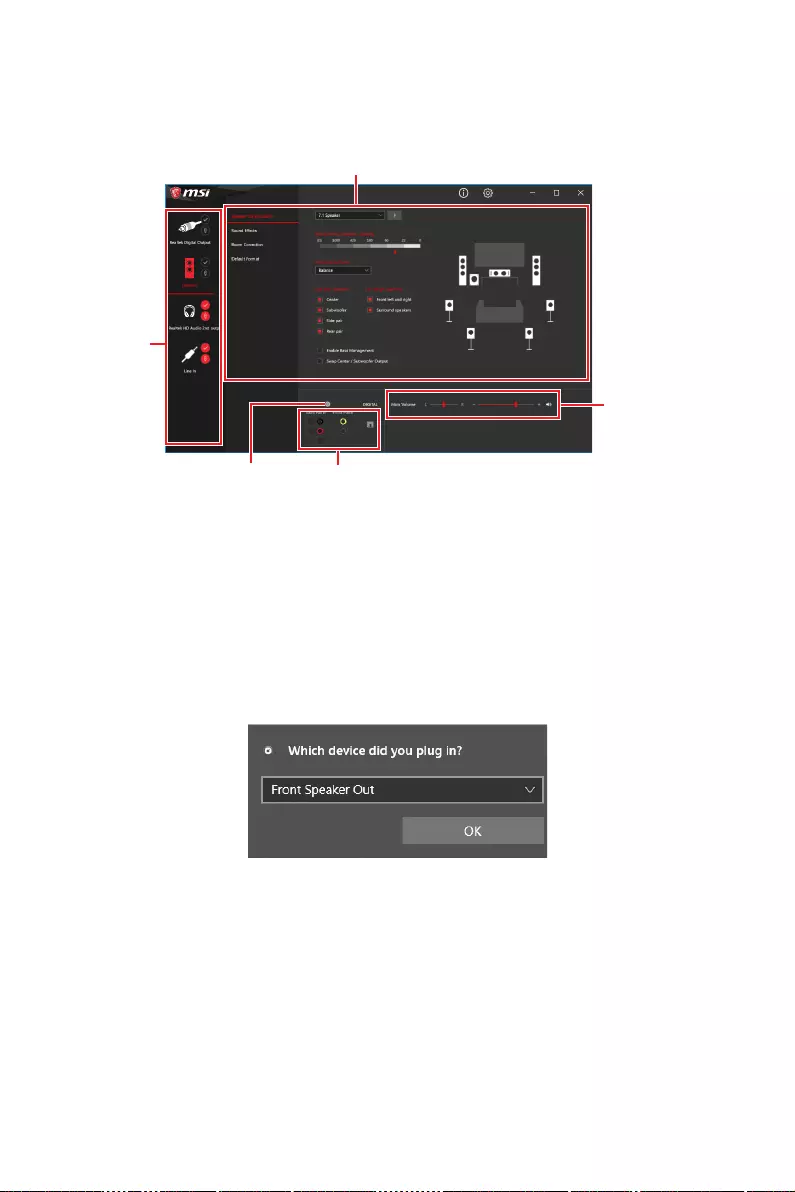
14

15
AUDIO INPUT
AUDIO INPUT
Rear Front
Side Center/
Subwoofer

16
1.
2.
1
2

17
BAT1
JTPM1
JRGB1
M2_2
M2_1
SYS_FAN1
JFP2
JFP1
JBAT1
JRAINBOW2
JUSB2
JCI1
PUMP_FAN1
PCI_E1
PCI_E2
JDASH1
PCI_E3
JTBT1
CPU_PWR1 JSMB1
JRAINBOW1
CPU_PWR2
CPU_FAN1
JUSB4
JUSB3
JAUD1
JUSB1
SYS_FAN2 SATA7
SATA8
ATX_PWR1
DIMMB1
DIMMB2
DIMMA1
DIMMA2

18

19
DIMMA2
DRAM Frequency
DIMMA1 DIMMB1
DIMMA2 DIMMB2
DIMMA2 DIMMA2
DIMMB2
DIMMA1
DIMMA2
DIMMB1
DIMMB2

20
BAT1
PCI_E1
PCI_E2
PCI_E3: P
PCI_E1
1
2 10
9
+
+
+
+
Power LED
HDD LED Reset Switch
Reserved
Power Switch
JFP1
1 HDD LED + 2 Power LED +
3 4
5 Reset Switch 6 Power Switch
7 Reset Switch 8 Power Switch
9 Reserved 10 No Pin
1
JFP2
+
+
Speaker
Buzzer
1 2 Buzzer +
3 4 Speaker +

21
M2_1
M2_2
1.
2.
2
2
1
1
1
1
M2_2
M2_1

22
3.
4.
5.
30º30º
5
4
3
6.
6
6
6
6

23
SATA5~8 & SATA_A~B:
SATA_A
SATA5
SATA7
SATA_B
SATA6
SATA8
1
2 10
9
1 MIC L 2 Ground
3 MIC R 4 NC
5 Head Phone R 6 MIC Detection
7 SENSE_SEND 8 No Pin
9 Head Phone L 10 Head Phone Detection

24
1
2 16
15
1 TBT_FORCE_PWR 2 TBT_S0IX_ENTRY_REQ
3 TBT_CIO_PLUG_EVENT# 4 TBT_S0IX_ENTRY_ACK
5 SLP_S3#_TBT 6 TBT_PSON_OVERRIDE_N
7 SLP_S5#_TBT 8 No Pin
9 Ground 10 SMBCLK_VSB
11 DG_PEWAKE# 12 SMBDATA_VSB
13 TBT_RTD3_PWR_EN 14 Ground
15 TBT_CARD_DET_R# 16 PD_IRQ#
1
2 6
5
1 No Pin 2 NC
3 MCU_SMB_SCL_M 4 MCU_SMB_SDA_M
5 VCC5 6 Ground

25
24
131
12
ATX_PWR1
1 +3.3V 13 +3.3V
2 +3.3V 14
3 Ground 15 Ground
4 +5V 16
5 Ground 17 Ground
6 +5V 18 Ground
7 Ground 19 Ground
8 PWR OK 20 Res
9 5VSB 21 +5V
10 +12V 22 +5V
11 +12V 23 +5V
12 +3.3V 24 Ground
5
4 1
8CPU_PWR1~2
1 Ground 5 +12V
2 Ground 6 +12V
3 Ground 7 +12V
4 Ground 8 +12V

26
1. JCI1
2.
3. BIOS > SETTINGS > Security > Chassis Intrusion Configuration
4. Chassis IntrusionEnabled
5. F10EnterYes
6.
1. BIOS > SETTINGS > Security > Chassis Intrusion Configuration
2. Chassis IntrusionReset
3. F10EnterYes

27
1
10 11
20
1 Power 11 USB2.0+
2 USB3_RX_DN 12
3 USB3_RX_DP 13 Ground
4 Ground 14 USB3_TX_C_DP
5 USB3_TX_C_DN 15 USB3_TX_C_DN
6 USB3_TX_C_DP 16 Ground
7 Ground 17 USB3_RX_DP
8 18 USB3_RX_DN
9 USB2.0+ 19 Power
10 Ground 20 No Pin
JUSB4

28
1
2 10
9
1 VCC 2 VCC
3 4
5 USB0+ 6 USB1+
7 Ground 8 Ground
9 No Pin 10 NC
1
2 12
11
1 SPI Power 2 SPI Chip Select
3
Master In Slave Out (SPI Data)
4
Master Out Slave In (SPI Data)
5 Reserved 6 SPI Clock
7 Ground 8 SPI Reset
9 Reserved 10 No Pin
11 Reserved 12 Interrupt Request

29
BIOS > HARDWARE MONITOR
PWM DC
CPU_FAN1
SYS_FAN2
PUMP_FAN1
SYS_FAN1
CPU_FAN1 2A 24W
PUMP_FAN1 3A 36W
SYS_FAN1~2 1A 12W
1
1 Ground 2 +12V
3 Sense 4 Speed Control Signal
1
1 Ground 2 Voltage Control
3 Sense 4 NC

30
1.
2. JBAT1
3. JBAT1
4.
DRAM
VGA
BOOT

31
1
GRB
1
1 +12V 2 G
3 R 4 B
1
1
GRB

32
1
1
1
D
+5V
JRAINBOW
1
JRAINBOW1
1
JRAINBOW2
1 +5V 2 Data
3 No Pin 4 Ground

33
1.
2.
3. Restart
4. F11
5.
6. Press any key to boot from CD or DVD...
7.
1.
2.
3. Select to choose what happens with this discRun
DVDSetup.exe
4. Drivers/Software
5. Install
6.
7. OK
8.
MSI Center
http://download.msi.com/manual/mb/MSICENTERCS.pdf

34
There is no GOP (Graphics
Output protocol) support detected in this graphics card
1.
2. Press DEL key to enter Setup Menu, F11 to enter
Boot MenuDelete
3. BIOS

35
Press DEL key to enter Setup Menu, F11 to enter Boot
MenuDelete
F1
F2
F3
F4
F5
F6
F7
F8
F9
F10
F12
Ctrl+F
http://download.msi.com/manual/mb/Intel600BIOSsc.pdf

36
F6
1.
2.
Ctrl + F5Yes
DelM-FLASHYes
3.
4. Yes
5.

37
1. Support
2. Advanced
3. Install
4. Install
5.
6.


i
Regulatory Notices
Regulatory Notices
FCC-B Radio Frequency Interference Statement
This equipment has been tested and found to comply with the limits
for a Class B digital device, pursuant to part 15 of the FCC rules. These
limits are designed to provide reasonable protection against harmful
interference in a residential installation. This equipment generates,
uses and radiates radio frequency energy, and, if not installed and
used in accordance with the instructions, may cause harmful interference to radio
communications. However, there is no guarantee that interference will not occur in a
particular installation. If this equipment does cause harmful interference to radio or
television reception, which can be determined by turning the equipment off and on, the
user is encouraged to try to correct the interference by one or more of the following
measures:
Reorient or relocate the receiving antenna.
Increase the separation between the equipment and receiver.
Connect the equipment into an outlet on a circuit different from that to which the
receiver is connected.
NOTE
The changes or modifications not expressly approved by the party responsible for
compliance could void the user’s authority to operate the equipment.
Shield interface cables and AC power cord, if any, must be used in order to comply
with the emission limits.
FCC Conditions
This device complies with part 15 of the FCC Rules. Operation is subject to the
following two conditions:
This device may not cause harmful interference.
This device must accept any interference received, including interference that may
cause undesired operation.
MSI Computer Corp.
901 Canada Court, City of Industry, CA 91748, USA
www.msi.com

ii Regulatory Notices
CE Conformity
Products bearing the CE marking comply with one or more of the
following EU Directives as may be applicable:
RED 2014/53/EU
Low Voltage Directive 2014/35/EU
EMC Directive 2014/30/EU
RoHS Directive 2011/65/EU
ErP Directive 2009/125/EC
Compliance with these directives is assessed using applicable European Harmonized
Standards.
Son.
Products with Radio Functionality (EMF)
This product incorporates a radio transmitting and receiving device. For computers
in normal use, a separation distance of 20 cm ensures that radio frequency exposure
levels comply with EU requirements. Products designed to be operated at closer
proximities, such as tablet computers, comply with applicable EU requirements in
typical operating positions. Products can be operated without maintaining a separation
distance unless otherwise indicated in instructions specific to the product.
Restrictions for Products with Radio Functionality
: IEEE 802.11x wireless LAN with 5.15~5.35 GHz frequency
band is restricted for indoor use only in all European Union member
states, EFTA (Iceland, Norway, Liechtenstein), and most other European
countries (e.g., Switzerland, Turkey, Republic of Serbia). Using this WLAN
application outdoors might lead to interference issues with existing radio
services.
Radio frequency bands and maximum power levels
Frequency Range:
2412~2484MHz
5150~5350MHz (RLAN 1)
5470~5725MHz (RLAN 2)
5725~5875MHz (RLAN 3)
5875~5925MHz (RLAN 4)
5925~6425MHz
Max Power Level: 2.4 GHz: 20dBm; 5 GHz: 23dBm; 6 GHz: 23dBm

iii
Regulatory Notices
This device is restricted to indoor use when operating in the 2.4GHz, 5GHz, 6GHz
frequency band.
Cet appareil doit être utilisé à l’intérieur.
Compliance Statement of Innovation, Science and
Economic Development Canada (ISED)
This device complies with with Innovation, Science and Economic Development
(1) this device may not cause interference, and (2) this device must accept any
interference, including interference that may cause undesired operation of the device.
Australia and New Zealand notice
This equipment incorporates a radio transmitting and receiving device. In normal use,
a separation distance of 20 cm ensures that radio frequency exposure levels comply
with the Australian and New Zealand Standards.

iv Regulatory Notices
MAG B660M MORTAR WIFI
MAG Z690M MORTAR WIFI
MAG B660M MORTAR

v
Regulatory Notices
Battery Information
Batteries, battery packs, and accumulators should not be disposed of as
unsorted household waste. Please use the public collection system to
return, recycle, or treat them in compliance with the local regulations.
Taiwan:
For better environmental protection, waste batteries should be collected
separately for recycling or special disposal.
The button cell battery may contain perchlorate material and requires
special handling when recycled or disposed of in California.
For further information please visit:
http://www.dtsc.ca.gov/hazardouswaste/perchlorate/
: There is a risk of explosion, if battery is incorrectly replaced. Replace only
with the same or equivalent type recommended by the manufacturer.
Chemical Substances Information
In compliance with chemical substances regulations, such as the EU REACH
Regulation (Regulation EC No. 1907/2006 of the European Parliament and the
Council), MSI provides the information of chemical substances in products at:
https://csr.msi.com/global/index
Environmental Policy
The product has been designed to enable proper reuse of parts and
recycling and should not be thrown away at its end of life.
Users should contact the local authorized point of collection for recycling
Visit the MSI website and locate a nearby distributor for further recycling
information.
Users may also reach us at gpcontdev@msi.com for information regarding proper
WEEE (Waste Electrical and Electronic Equipment)
Statement
ENGLISH
To protect the global environment and as an environmentalist, MSI must
remind you that...
Under the European Union (“EU”) Directive on Waste Electrical and
Electronic Equipment, Directive 2002/96/EC, which takes effect on August
13, 2005, products of “electrical and electronic equipment” cannot be

vi Regulatory Notices
discarded as municipal wastes anymore, and manufacturers of covered electronic
equipment will be obligated to take back such products at the end of their useful life.
branded products that are sold into the EU. You can return these products to local
collection points.
Hinweis von MSI zur Erhaltung und Schutz unserer Umwelt
beauftragt, die in die Europäische Union in Verkehr gebrachten Produkte, am Ende
seines Lebenszyklus zurückzunehmen. Bitte entsorgen Sie dieses Produkt zum
gegebenen Zeitpunkt ausschliesslich an einer lokalen Altgerätesammelstelle in Ihrer
Nähe.
FRANÇAIS
En tant qu’écologiste et afin de protéger l’environnement, MSI tient à rappeler ceci...
Au sujet de la directive européenne (EU) relative aux déchets des équipement
électriques et électroniques, directive 2002/96/EC, prenant effet le 13 août 2005,
que les produits électriques et électroniques ne peuvent être déposés dans les
décharges ou tout simplement mis à la poubelle. Les fabricants de ces équipements
seront obligés de récupérer certains produits en fin de vie. MSI prendra en compte
cette exigence relative au retour des produits en fin de vie au sein de la communauté
européenne. Par conséquent vous pouvez retourner localement ces matériels dans
les points de collecte.
ESPAÑOL
MSI como empresa comprometida con la protección del medio ambiente, recomienda:
Bajo la directiva 2002/96/EC de la Unión Europea en materia de desechos y/o
equipos electrónicos, con fecha de rigor desde el 13 de agosto de 2005, los productos
clasificados como “eléctricos y equipos electrónicos” no pueden ser depositados en
los contenedores habituales de su municipio, los fabricantes de equipos electrónicos,
están obligados a hacerse cargo de dichos productos al termino de su período de vida.
MSI estará comprometido con los términos de recogida de sus productos vendidos en

vii
Regulatory Notices
la Unión Europea al final de su periodo de vida. Usted debe depositar estos productos
en el punto limpio establecido por el ayuntamiento de su localidad o entregar a una
empresa autorizada para la recogida de estos residuos.
NEDERLANDS
Om het milieu te beschermen, wil MSI u eraan herinneren dat….
De richtlijn van de Europese Unie (EU) met betrekking tot Vervuiling van Electrische
en Electronische producten (2002/96/EC), die op 13 Augustus 2005 in zal gaan kunnen
niet meer beschouwd worden als vervuiling. Fabrikanten van dit soort producten
worden verplicht om producten retour te nemen aan het eind van hun levenscyclus.
MSI zal overeenkomstig de richtlijn handelen voor de producten die de merknaam MSI
dragen en verkocht zijn in de EU. Deze goederen kunnen geretourneerd worden op
lokale inzamelingspunten.
SRPSKI
sredini, MSI mora da vas podesti da…
Direktiva 2002/96/EC, koja stupa na snagu od 13. Avgusta 2005, proizvodi koji spadaju
kojima je istekao vek trajanja, koji imaju MSI oznaku i koji su prodati u EU. Ove
POLSKI
produktów elektrycznych i elektronicznych (Dyrektywa 2002/96/EC), która wchodzi w
wyznaczonych punktach zbiorczych.
TÜRKÇE
2002/96/EC platné od 13. srpna 2005 je zakázáno likvidovat “elektrické a elektronické

viii Regulatory Notices
MAGYAR
az MSI emlékezteti Önt, hogy ...
elektronikus berendezések hulladékairól szóló 2002/96/EK irányelve szerint az
hulladékként, és az ilyen elektronikus berendezések gyártói kötelessé válnak az
ilyen termékek visszavételére azok hasznos élettartama végén. Az MSI betartja
a termékvisszavétellel kapcsolatos követelményeket az MSI márkanév alatt az
ITALIANO
Per proteggere l’ambiente, MSI, da sempre amica della natura, ti ricorda che….
In base alla Direttiva dell’Unione Europea (EU) sullo Smaltimento dei Materiali
Elettrici ed Elettronici, Direttiva 2002/96/EC in vigore dal 13 Agosto 2005, prodotti
appartenenti alla categoria dei Materiali Elettrici ed Elettronici non possono più
essere eliminati come rifiuti municipali: i produttori di detti materiali saranno obbligati
a ritirare ogni prodotto alla fine del suo ciclo di vita. MSI si adeguerà a tale Direttiva
ritirando tutti i prodotti marchiati MSI che sono stati venduti all’interno dell’Unione
Europea alla fine del loro ciclo di vita. È possibile portare i prodotti nel più vicino punto
di raccolta
India RoHS
and prohibits use of lead, mercury, hexavalent chromium, polybrominated biphenyls
or polybrominated diphenyl ethers in concentrations exceeding 0.1 weight % and 0.01
weight % for cadmium, except for the exemptions set in Schedule 2 of the Rule.

ix
Regulatory Notices
(Pb)
(Hg)
(Cd)
(Cr(VI))
(PBB)
(PBDE)
(Pb)
(Hg)
(Cd)
(Cr+6)
(PBB)
(PBDE)

xRegulatory Notices
Copyright and Trademarks Notice
other marks and names mentioned may be trademarks of their respective owners. No
warranty as to accuracy or completeness is expressed or implied. MSI reserves the
right to make changes to this document without prior notice.
Technical Support
If a problem arises with your system and no solution can be obtained from the user
guide, please contact your place of purchase or local distributor. Alternatively, please
try the following help resources for further guidance.
Visit the MSI website for technical guide, BIOS updates, driver updates, and other
information: http://www.msi.com
Register your product at: http://register.msi.com
Revision History
Version 2.0, 2021/12 , First release.
Version 2.1, 2022/01 , update list.




